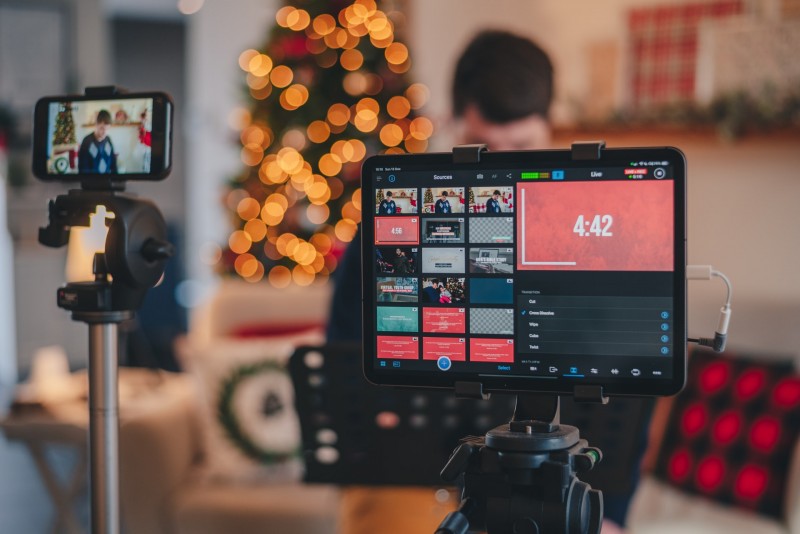
Social media video is one of the most powerful tools for engaging your audience. With so many platforms to choose from, it can be difficult to determine which one is best suited for your business. Knowing where and how to use video as a marketing tool can help you create an engaging experience that attracts potential customers.
According to many experts, video marketing is vital for the success of any business on social media channels. Although it’s a great way to introduce your business and brand to potential customers, keeping users engaged with videos can become challenging, especially on social media.
To help you get the most out of your social media video design services, here are some tips for creating and sharing animated content on Facebook, Twitter, and Instagram.
The Importance of Social Media Videos as a Marketing Tool
According to a recent survey by Animoto, social media videos are the most effective form of content for companies. Social media users are more likely to share videos (21%) than any other type of content. And social media users are twice as likely to purchase a product after seeing it in a video on major platforms.
Video marketing is a particularly powerful way to engage customers online. In fact, according to experts, 75% of consumers prefer watching a video about a product as opposed to reading text.
If you have a marketing budget, it's essential to make sure your videos effectively drive traffic back to your site and increase conversions. One of the most effective ways to do this is by hiring social media video design services.
Types of Videos You Can Publish on Social Media
As video content continues to gain popularity on social media, you might be wondering what types of videos you should create. Videos can take many forms, but a few are especially successful on social media. The most popular type of videos tend to fall into the following categories:
Stories
Stories are short-form videos that were first introduced back in 2014. Stories are a powerful tool for marketing, but they are not something that you can simply slap together. A story can last up to 24 hours and can be viewed by your followers even if they haven't visited your page.
In the business world, stories are used to help people remember how products and services solve problems. You can do a lot with stories if you know how to use them. You can make your content more interesting and memorable. You can also increase engagement, brand loyalty, and online traffic.
Short-form Videos
Short-form videos promote products and services in a quick, easy, and concise way. The length of these videos is between 15 and 60 seconds.
Short-form videos are effective because they are the best way to gain attention when you have a limited amount of time. If you have only a few seconds to get someone’s attention, you can do it with an image that is eye-catching and powerful.
According to a study done by Wistia, shorter videos are far more likely to be shared than longer ones. This is because short-form videos are easier to consume and create a sense of urgency.
Long-form Videos
There is a growing trend among social media video editors – long-form videos. Long-form videos are around the 5-10 minute mark. Usually, they feature an expert talking on a specific topic in their field.
Long-form videos are suitable for marketing because they allow brands to tell stories in detail and share expertise. They can also be used as product demonstrations and go viral if they offer value to the audience.
Today, we are living in the era of information overflow. The amount of content that is produced daily is enormous. If you have a product or service to promote and want it to be noticed by people, try producing long-form videos.
Live Streams
Live Streams are a popular and effective way to connect with your audience. No other form of content allows you to engage with your audience in real-time or reach an otherwise inaccessible audience.
Live streams can address any topic but are most commonly used for Q&A sessions, live events, and product announcements.
Live streams can be broadcast on multiple platforms, including Facebook Live and YouTube Live. They can also be hosted on a company’s website, such as with Periscope or Hangouts.
Social Media Video Tips to Produce Engaging Content
Be Prepared with a Script
<img src="data:image/jpeg;base64,/9j/4AAQSkZJRgABAQEASABIAAD/4gxYSUNDX1BST0ZJTEUAAQEAAAxITGlubwIQAABtbnRyUkdCIFhZWiAHzgACAAkABgAxAABhY3NwTVNGVAAAAABJRUMgc1JHQgAAAAAAAAAAAAAAAAAA9tYAAQAAAADTLUhQICAAAAAAAAAAAAAAAAAAAAAAAAAAAAAAAAAAAAAAAAAAAAAAAAAAAAAAAAAAAAAAABFjcHJ0AAABUAAAADNkZXNjAAABhAAAAGx3dHB0AAAB8AAAABRia3B0AAACBAAAABRyWFlaAAACGAAAABRnWFlaAAACLAAAABRiWFlaAAACQAAAABRkbW5kAAACVAAAAHBkbWRkAAACxAAAAIh2dWVkAAADTAAAAIZ2aWV3AAAD1AAAACRsdW1pAAAD+AAAABRtZWFzAAAEDAAAACR0ZWNoAAAEMAAAAAxyVFJDAAAEPAAACAxnVFJDAAAEPAAACAxiVFJDAAAEPAAACAx0ZXh0AAAAAENvcHlyaWdodCAoYykgMTk5OCBIZXdsZXR0LVBhY2thcmQgQ29tcGFueQAAZGVzYwAAAAAAAAASc1JHQiBJRUM2MTk2Ni0yLjEAAAAAAAAAAAAAABJzUkdCIElFQzYxOTY2LTIuMQAAAAAAAAAAAAAAAAAAAAAAAAAAAAAAAAAAAAAAAAAAAAAAAAAAAAAAAAAAAAAAAAAAWFlaIAAAAAAAAPNRAAEAAAABFsxYWVogAAAAAAAAAAAAAAAAAAAAAFhZWiAAAAAAAABvogAAOPUAAAOQWFlaIAAAAAAAAGKZAAC3hQAAGNpYWVogAAAAAAAAJKAAAA+EAAC2z2Rlc2MAAAAAAAAAFklFQyBodHRwOi8vd3d3LmllYy5jaAAAAAAAAAAAAAAAFklFQyBodHRwOi8vd3d3LmllYy5jaAAAAAAAAAAAAAAAAAAAAAAAAAAAAAAAAAAAAAAAAAAAAAAAAAAAAAAAAAAAAABkZXNjAAAAAAAAAC5JRUMgNjE5NjYtMi4xIERlZmF1bHQgUkdCIGNvbG91ciBzcGFjZSAtIHNSR0IAAAAAAAAAAAAAAC5JRUMgNjE5NjYtMi4xIERlZmF1bHQgUkdCIGNvbG91ciBzcGFjZSAtIHNSR0IAAAAAAAAAAAAAAAAAAAAAAAAAAAAAZGVzYwAAAAAAAAAsUmVmZXJlbmNlIFZpZXdpbmcgQ29uZGl0aW9uIGluIElFQzYxOTY2LTIuMQAAAAAAAAAAAAAALFJlZmVyZW5jZSBWaWV3aW5nIENvbmRpdGlvbiBpbiBJRUM2MTk2Ni0yLjEAAAAAAAAAAAAAAAAAAAAAAAAAAAAAAAAAAHZpZXcAAAAAABOk/gAUXy4AEM8UAAPtzAAEEwsAA1yeAAAAAVhZWiAAAAAAAEwJVgBQAAAAVx/nbWVhcwAAAAAAAAABAAAAAAAAAAAAAAAAAAAAAAAAAo8AAAACc2lnIAAAAABDUlQgY3VydgAAAAAAAAQAAAAABQAKAA8AFAAZAB4AIwAoAC0AMgA3ADsAQABFAEoATwBUAFkAXgBjAGgAbQByAHcAfACBAIYAiwCQAJUAmgCfAKQAqQCuALIAtwC8AMEAxgDLANAA1QDbAOAA5QDrAPAA9gD7AQEBBwENARMBGQEfASUBKwEyATgBPgFFAUwBUgFZAWABZwFuAXUBfAGDAYsBkgGaAaEBqQGxAbkBwQHJAdEB2QHhAekB8gH6AgMCDAIUAh0CJgIvAjgCQQJLAlQCXQJnAnECegKEAo4CmAKiAqwCtgLBAssC1QLgAusC9QMAAwsDFgMhAy0DOANDA08DWgNmA3IDfgOKA5YDogOuA7oDxwPTA+AD7AP5BAYEEwQgBC0EOwRIBFUEYwRxBH4EjASaBKgEtgTEBNME4QTwBP4FDQUcBSsFOgVJBVgFZwV3BYYFlgWmBbUFxQXVBeUF9gYGBhYGJwY3BkgGWQZqBnsGjAadBq8GwAbRBuMG9QcHBxkHKwc9B08HYQd0B4YHmQesB78H0gflB/gICwgfCDIIRghaCG4IggiWCKoIvgjSCOcI+wkQCSUJOglPCWQJeQmPCaQJugnPCeUJ+woRCicKPQpUCmoKgQqYCq4KxQrcCvMLCwsiCzkLUQtpC4ALmAuwC8gL4Qv5DBIMKgxDDFwMdQyODKcMwAzZDPMNDQ0mDUANWg10DY4NqQ3DDd4N+A4TDi4OSQ5kDn8Omw62DtIO7g8JDyUPQQ9eD3oPlg+zD88P7BAJECYQQxBhEH4QmxC5ENcQ9RETETERTxFtEYwRqhHJEegSBxImEkUSZBKEEqMSwxLjEwMTIxNDE2MTgxOkE8UT5RQGFCcUSRRqFIsUrRTOFPAVEhU0FVYVeBWbFb0V4BYDFiYWSRZsFo8WshbWFvoXHRdBF2UXiReuF9IX9xgbGEAYZRiKGK8Y1Rj6GSAZRRlrGZEZtxndGgQaKhpRGncanhrFGuwbFBs7G2MbihuyG9ocAhwqHFIcexyjHMwc9R0eHUcdcB2ZHcMd7B4WHkAeah6UHr4e6R8THz4faR+UH78f6iAVIEEgbCCYIMQg8CEcIUghdSGhIc4h+yInIlUigiKvIt0jCiM4I2YjlCPCI/AkHyRNJHwkqyTaJQklOCVoJZclxyX3JicmVyaHJrcm6CcYJ0kneierJ9woDSg/KHEooijUKQYpOClrKZ0p0CoCKjUqaCqbKs8rAis2K2krnSvRLAUsOSxuLKIs1y0MLUEtdi2rLeEuFi5MLoIuty7uLyQvWi+RL8cv/jA1MGwwpDDbMRIxSjGCMbox8jIqMmMymzLUMw0zRjN/M7gz8TQrNGU0njTYNRM1TTWHNcI1/TY3NnI2rjbpNyQ3YDecN9c4FDhQOIw4yDkFOUI5fzm8Ofk6Njp0OrI67zstO2s7qjvoPCc8ZTykPOM9Ij1hPaE94D4gPmA+oD7gPyE/YT+iP+JAI0BkQKZA50EpQWpBrEHuQjBCckK1QvdDOkN9Q8BEA0RHRIpEzkUSRVVFmkXeRiJGZ0arRvBHNUd7R8BIBUhLSJFI10kdSWNJqUnwSjdKfUrESwxLU0uaS+JMKkxyTLpNAk1KTZNN3E4lTm5Ot08AT0lPk0/dUCdQcVC7UQZRUFGbUeZSMVJ8UsdTE1NfU6pT9lRCVI9U21UoVXVVwlYPVlxWqVb3V0RXklfgWC9YfVjLWRpZaVm4WgdaVlqmWvVbRVuVW+VcNVyGXNZdJ114XcleGl5sXr1fD19hX7NgBWBXYKpg/GFPYaJh9WJJYpxi8GNDY5dj62RAZJRk6WU9ZZJl52Y9ZpJm6Gc9Z5Nn6Wg/aJZo7GlDaZpp8WpIap9q92tPa6dr/2xXbK9tCG1gbbluEm5rbsRvHm94b9FwK3CGcOBxOnGVcfByS3KmcwFzXXO4dBR0cHTMdSh1hXXhdj52m3b4d1Z3s3gReG54zHkqeYl553pGeqV7BHtje8J8IXyBfOF9QX2hfgF+Yn7CfyN/hH/lgEeAqIEKgWuBzYIwgpKC9INXg7qEHYSAhOOFR4Wrhg6GcobXhzuHn4gEiGmIzokziZmJ/opkisqLMIuWi/yMY4zKjTGNmI3/jmaOzo82j56QBpBukNaRP5GokhGSepLjk02TtpQglIqU9JVflcmWNJaflwqXdZfgmEyYuJkkmZCZ/JpomtWbQpuvnByciZz3nWSd0p5Anq6fHZ+Ln/qgaaDYoUehtqImopajBqN2o+akVqTHpTilqaYapoum/adup+CoUqjEqTepqaocqo+rAqt1q+msXKzQrUStuK4trqGvFq+LsACwdbDqsWCx1rJLssKzOLOutCW0nLUTtYq2AbZ5tvC3aLfguFm40blKucK6O7q1uy67p7whvJu9Fb2Pvgq+hL7/v3q/9cBwwOzBZ8Hjwl/C28NYw9TEUcTOxUvFyMZGxsPHQce/yD3IvMk6ybnKOMq3yzbLtsw1zLXNNc21zjbOts83z7jQOdC60TzRvtI/0sHTRNPG1EnUy9VO1dHWVdbY11zX4Nhk2OjZbNnx2nba+9uA3AXcit0Q3ZbeHN6i3ynfr+A24L3hROHM4lPi2+Nj4+vkc+T85YTmDeaW5x/nqegy6LzpRunQ6lvq5etw6/vshu0R7ZzuKO6070DvzPBY8OXxcvH/8ozzGfOn9DT0wvVQ9d72bfb794r4Gfio+Tj5x/pX+uf7d/wH/Jj9Kf26/kv+3P9t////2wCEAAIDAwMEAwQFBQQGBgYGBggIBwcICA0JCgkKCQ0TDA4MDA4MExEUEQ8RFBEeGBUVGB4jHRwdIyolJSo1MjVFRVwBAgMDAwQDBAUFBAYGBgYGCAgHBwgIDQkKCQoJDRMMDgwMDgwTERQRDxEUER4YFRUYHiMdHB0jKiUlKjUyNUVFXP/CABEIB38HgAMBIgACEQEDEQH/xAAeAAABBQEBAQEBAAAAAAAAAAABAAIDBAUGBwgJCv/aAAgBAQAAAAD6BeS9OJcniRPJLw8p4DY4IIIIYK9WrUo52Vk4+Pj5mVQzqVDHxedwOa5vnMHLqV44WRxsaCHaXs32T9BbuL4Z8U+CxMAc1OReCQg5qaUghPI1RQpCWQtEKSKSKT5XyTKWxNJLKUHuklsz2LU0s+l6R6DO/M8045PdIjHGE+SGlRoVY3G5f1dTR1NbU09bc3ug1tfY6Tq9/XuVsLmOa5HKja1qbBTx8i/e0Oo1IrFiAGxPU+vXucXlEvQe8uTi5OKeHFJsUUdeCKCCvXqVqWbk5eVkZedRz6GTic5zvKcbyPJ83kUYWolFafsv2X9D9DjeJ/FPzxG1oBDkUUkQCQAEhO5wjiCE0gTYEUnAl8j5prc1iSzZnUkqc+QzXp32Hvfd9F7yduf5rxzDYlD4w4SsZSpUarJpjNK6SxoaGnr6+3t9Jv8AS9r2vS7mlFi83y3K5zY2xsrVambmWr13a13TsrpSWYvsgl5cSHkucXOJT0UXoOcQ4osZDFWjggrV6tepUoZudmZebjYuRh4HO8ryvIcpyvPYtCtGnafr32h9GdLkeMfFfzbHGwhzXpJEJBIhwCQncHRwpKVycK4SJlke+aWzemdfnm0JpnvcHl8s8k0zyLPoncWG0fO+IAsyvc8NMz69KnTpoySSvSTrE+hsb25t7XV+h+h9h0Gq3B57meWyIIYYWMZXrVjeu6d2d1Ku5slpv2iXpxIeS4uJc9FyIeSSk9J5JBa1sNevBXhrxV4atajSy8fBw8PDxcPA57mOW5DleS53Ll9S+0fpHq8vxf4w+Z67GtckQnBJJApBAgyyBzIURI4l8BDnSulnnsTz3rLb9qe9bT3khsr3TmyCZfQO9sKn5/wqdLYklkYTImVaNGiBO6W1PK9kkc1rZ2dLb6/0L0buOp12YHPczyOFEyBrXOayNti1pWEM+Al+kPs5xDy5OTk5zy5xJTg9FFyKcXIklJzWMighgjhgjrxQ1amfnZGNgc9h4eFi87zfJ8nj9R9Le69Jl+OfFvzLWaxIpEFrgQSEk0hrpyUa5RlnkmfGTJJI99ua1ZfdfFoWZNKwXSINSkfNNIyZ8ne93adT4bhQ6WeaZzWuRMFGjSidLanuWLcoc5R3tZafaeg+jd91GyMPnOc5HnmQQBSWQ4qWeyXinAo5LcX20XJPDnEuUieS5wcnJPRDinFOJRcEXJpDGxwQxQxRR144KsGbkY2Dz3PYeDgZV31H0WxzfmPyx8oYlCFpRDwUkiQkkggZiiYnSOsXLNyQyB0kqkt2rMjHga726tgukaWh0xldK5k1jtu7tWK3DcWx00ss5Eb2vTK1WnWMtq1cnt2pA6KG3oNm6/v/AETvur1342FznGc/BFXc99mzI4ueUxtKERyWh9wJ7XEkSPDnOLyHOKJJTiHJyJJLgkSnBJwLWthZFDHFFHFDFUpZOLz+Dg0t7pIub4LyLxLjOT5DnMmlACk5wISSSQIfLOZBHPZfdv27cz5kZHudaN1tN2zY0dHmpLhJmZI5GQukc+d/c9zdkg4XkGh08lhOayZ7hWqVqzlav27U87WxQVr+kLPT936H3nWbUmTh87xuBDHVc51ydwDWoNULGCS037gcE55Dy9r3FxenEovSIJJTnByLg4FFEtRcHEFoDIY2MhjiihrZ+bmQTUOX4rhOQ5vB53lOU5Tl+Zw8itGESQUSXSGa3YkmUdmzNY0bNq8XykqWN8lpmcepw7vR1MzQCIfOntei989h/a9zdfHxnHMMkslgOYS+UQ1IaoVmxblnmhjbBBf0mzdV3Hone9TuSZ2Jz/H4Edeu0RWnlRlycnsaBLIvt0klwc5wlRTyXFOKc4gkSIPRTkUXBIolj0QU5yBLmKNkLYo4oIK8dXLwue53n+c53BwOfweX5/kuV5TnMLPrNEjpJpppXS6NiSZ8M9x969PbtIPkc5j2vcM6t0WHodFNnWmPapHua8hz7L55Oy7q5KuN5FhfLNOyRjy6ZtSnBXikmtTTSvrwxCC9psk67t/Qu86zbmy8XB47AqQwMaH2DCHyTklEue5fazwS4kvDnEqQPKcS5FORScXEFyDiiEknJAouRBeXkpNYGRRRRwVq1WnnZeRgYHP85zuDz2FznM8ty3L8zh59YvtWJZpdGSew6OxakmvvfK9OeGvkeTJlY2k3Q6OCaYRFPCQRfNPafJ2Hd3nnkOThkfJNI5FsbnqtUbC0zTWHOjgbFGzRvtm6rtfQ+66zanysLn+N56CNjEJ5WVi6axaBle56T/sokqRFyLyXJzyHlORcU9pKcikS5wSSIcEUiiii9OReXlyQEUcEFdlaCCnQzsrEwuf5/mee5znucwOcwMTDyc2rXkOlNNK9k8hsWgZ43GQzF0j5X5POUblve0ddRmON5LGCWa1LNK/su40HP5LkUmySPCT4hLCyNsYkklmkbFWZGI9DQY/p+29B73qtuXLwsDjOchQYXTGGs6Wa7akJcwBkX2q4kuJLi4uTi5wkDkXOD2uRTiiQSnpEIohJEOLXOLkiZE9OkKSYyOKKBkMUFaCjRysnDwOb5nm+dwMXKxsvLwsbFqw1WvbYkdNbjeUJppJkZXulzedzA/qN/UQjLC1iapLVt9hy63vNGQclx5ax73GQtKaAwGSUyPc2nXjZBHe0mS9R2noPfdTt2MrEwOL5yFwcZHuFFSPt3WJjWsSH28U5JxLnEuJLi5OJeHBxKJRKRciUQkU5qcgCXEpFFzi5Fxc5pISYyKOBkUEUFSpRzsnHwee5/nMDGxcfHx8zKxMXLx67VLbeZBIp7FiRPkkFLmchk3Q9Pqysa2QRtcWTWbD5iOq76edcXzdfKjlm15E4OYiwTSvkcGqOtUgbUbo6LJOt7L0Hver3Jc3GwON56IveXJQVWIW7YTIE6R7ft1yJcSXJyc9FxUiT0UU9wTkiiSUUXBJJFEFEh4JRc5EouSD0nAkJrI2RMgrx1q9SpRzcnI5/A57ncHHx8vJzcPGy8ahTggkeJrcl1ylKkzucn6voH0HWU10jQGlSvmegOk7rRgr8Nz2c3doXqnRiGSeMsSmlJQYIW1469eLR0Wv63tPQO96vbsZ2Pg8fgwxloaBHC1PmuI160jn2XfbRRJLi5PBc9OT05EkklIvCcnAp4KcC0opJyBJDwXFIlFFJFwJBJIKawMhiighrwVq9GhmZGHjYWDz2FiY2Xk5efkZOXl50jZ57Er3zNz9f1D0rp6nn/l2bZkEgY0QmZ0789m3fm7uly2d5LQ2OmnEN7Z0ZJYwGB8zxE4OYI6grR3LzZ+o7X0Dvur2rWZjYPGc/Ta1hlTlEg+xK9UoXSSX5fs97kXBxTnEouLg9OLiSUSCi5FEokhEtIJIcnBFOSLgSiEXAgpySQJRCTmxsjbXjrwQwVqVSjm5GJg4PPc9iZeTm5ORlZtDMqQmSSwyh697l6LsO85+fuDllY5rgwTtks0+V6OTaw9y87z7kcq/Lj9Fr6NqfobsZCUj2x1LcbbMsdeJ1exfB6js+/wC+6vatZmJz/G8zC2GOR80iLXOlmKpRyST6r/sUOLk4kOcSiXlJxcpA4OBeCUnEpOSKCJAcikSnIOcHIEJxKaUUQikEHBFOJAbGyKGKKGKGvWp0c7LyMPEw8LBwMfNys3Nzs6nSZUwPfPeu/lucB4J5LPKWtc+Sw1+dl8PzXYXuixt/pa3D8bdqZ3GNtdp08vdatiwnNe/n/Fq3VdlX3b+w6sKD9EO6Tte97/qduxn4nPcbzNeOuHTWZnuKdJanlo041NqN+yCnlxTiUSXOKLkXFyIcXFjynItcXByBSILXJySLmuJSKLS9rgg8BOSQTSgUiiQHtTWNZGxkEMFaGrVoZ+XjYmHz+FhYuNnUKWRzHn3o3v8A6lfg828S86uTOItR6Iylj8lyEPRcb3fHKfpszzTml0lDsY+kt0dGD1DZ2NOxJmfLHju/03Qy9n2e51zKuYdGZ/U9j6B3vV7djPxcDjOaigqGV9u4EDPoa2nJlZOVA7Rd9kuJcnFwc4PKLk4pxRJJKJRcikSnJBwRIJCcHEEtlASJTgkXAIpBBIJFIpFAJAhzmhsUTIo4oYIK1GjlZeLi4OBhc/xnn3lEXr/sO3ieZ+WUNZ6uObJoZ1LivF4X0dTTreR9JsdSfNuPu9Oz17P5rK5qTpPXexVXV3fJfBJ9Vej2eH0vSPVb8lK9fcet7H0LvOq2redkYXG83HBSclatQMrP1+k6vaGLgY2ay4/7GKc5yKenJ4LwS5yc2Qgp7S4ouSTk5JByBRIKILknJIOIIckSEE4FAIBwISJCQLEkVIEi0MayNjIo69ejQzs3J57jPNfJvLtbt7fJ8/i6O9LSrRR0M3G865O1tYHPU72bznVal6rzmdVDNHun0eH6vb9j7vbtZHD/AC62zlZXotqZ+Zoeweiy6Wk2brOx7/0Hqdq1Rx8Tjufr1qLYWzWIadK90Xed1tjG5vnsmB7/AK9cXJycXopyeSXFB4eSCC4OLnNKKciAXJJFJEkpOBRSKRDmuQKQIIaSCCCkS1NaCkiUk8lAhBjI2wxQUM7m+K4/icGlzXOww1dGnp8/m4tbhuF5HM6jl8zDaYbnpPn2XoHGv3s6jL1NjB1fRfSO263rG8h8feVX3xbtXsYPQMGx7JuXtO4eo6/0Hv8ArNa7m5HP8hzlavXYyOWSplUdLr/TvQuhWVzHI4ldzvrNPKLw9ORcSnpzkHFxBc1xSc5B4SeE4IgpyCcHglOaUSHpqKKTmlrkCA4IBJyICLGpNTgQU4pye6R6c1NQFfDwMflsFvKcdy+Zh0mXfHsXD5Lkczm+z7nwetrXeVx+76zwHJbbz7W4NrL6PZXRdr1fZdn6Bc4n5h+Wb09ztanQYmNrafsPJZ/vHYWeh7H0D0Prde3nY/P8dztWOINanZ+Rl6Hbet+k9K/I5PisNJfUzk5ycSXJxeHEkklyRckiUU9EJxLSQiUQUiS5IOJaSgSiHBJJzUgCWuTUUQkAE0IJJIp6cXvkeXSyOTpM/JzMzDPF+TcDRr9hxXhvknLccyCPmPa+c8Wu+p8TzL/e/M/JM2eJmjuz7lh21u6O71HXdh6Jc4/5k+RbMGh3vUY3M83e1Oj0evq/SXSdX1/oPfdTsWc/HwuO5yBobGiyjiZdvsfXfS+iGZynF4To2fVhLi4lGQOKUhRTiSS4IlFxLXpBycHIFwc1Aua56KIcHBOaWvSRKRagnAEOa14cggA1qakkwpyKLnvc95mkfLNPSqR4uJD5H8ozZHU2PMfkvzq3k9lzXJ3/AE3yrHu9F5OLvs/PeMN1MW/1nf8AX+geN+OendHvbXSdV1He3uW+b/kTWj6rvfO83lbVO733sWlle37vd9l6B33UbNqhk4PIc5GmlEsp4mUOo9J9D6CSlzPIYxEX1miS8OeCS5PRcS4oPRTkQ5wcCUUUnIJOc0ookPDkUiC1yKc0OSBIDgHBIBzo3ppDC1qaUA1BzgXGRznukfJNLNSFvH5TnPlzwTs/IfXrngXy2xmZ0HF8ZX9D5x+jH5DNa7za8Yinm0PQO92uD4Hlep9G63c6nrOq7PW5/wCa/ki1R9q7XwxvC7OLF6J9SeP936r03ddt3/oHT7NuhmYnJ85GigYWUcfMj2O07/oLlHnObznub9WlyLk8pyD0ZES4va4okOTkiU4JyRT2OSJCRRcHCRqKKDkCgXAua5qDgkimOa8JJAFrWIENSCJDnl7nOkfLLLPWhdkcp89+ceGcp4N1XtPnHzfm9RwWvynGRaz7/R6HDcYe+0eJ5Z9m11m8eepsze/7Pvuw6Hsuu3uX8F+HmzfS2FW8zg77j/Ouw9OrVvcOk9R9Y9U7/qNe3Uy8XlOdhYGhobSpVI7XQ9bv2s7BzIJZm/VDw5StKkScSXFxDlIiE5wKTwQ8FFEgklJpKLiUWuTgUk4JNc4FBzQSkkkgUUgAU0RuCATWuDkVI5zjJI+aWWrUjwfFOT+ZvkjNwupORxN5/n3Xch5jDr9Vyo2+s8153Z39XnqsFJ+iyKnqDqfR/Sum6zten1ub8O/P+p0XsHO57u16TzzzCq7bl5g+w/Yv2L6h021PVysTlOdrhjE5wjrRwz6OvqTZedEZrzvp0EuJKla4lPLkU5JyLwS5IOD0UQXIhyLXJFJ4LmolzU4oJJzmIkIgOSSCcEgS1JNAISaGlBAkl7jI98j32MixS8N8K+cPjqv3N2KTgMTquM1/M87Bq7kGdtUO84/Az47FmSpXWjfx2S1+/wDXfQ+k7TsuivYfiH52s6HYos7TZg8lzdi1mzv7rp3feX2P2uuJM7E5Lm421EZLD1G0OuW5XUYUJdR30e5xTg8kuDiS4kuBcHJyc1ycUiikSUiUCiiXJFrygUUi0PJAKTgQmuQaSUkkkE1NIBQYUCg4SFzi+RliUURwfyT8y/MS8pn6J0DIpsgc1l5dC9TNjrMzIPM1ojK0stbhhwdTqvc+27Dtus2NDE8M/PiWXoNrlNt2JjdXB2tfi9T0vZ7L3r6H63Y9B7CjjcpzUcFYSPtWkSppLCOdXijl0nfSjnJxRJMjRIQ8lEvKJRRKTi15LSQ4SBIpEhyTml6SKBISJKSRSRaiA4FriE5qDQEAiWpoLgHOLnOc6Rlp3FQZfg/zl8uWea8i4zo+ZGhqY+Van5DB1emZQWTWxreXXsQTiCw3QuOxNXqPoLvul9G2tSxg+J/AeN21rTpQ7XKX/dPJe8+hPA8uz7JhdY3036F9V7rUq8vz8EVFzpLtxyBBIZSrMjdpO+nE4koOc5ElyLnBxTiiSHEouY4hPBJSDigUS4EEouLSkSki0olpc0EoAlNckgkAmIOCaAUii8SuLnucTkcrxnxn8xuu+YcpyuVzlufk35mptZ0GhfycLM3aGXl1pNqtFXc+krDZn+l+w911Pq2zqP5rxD4P7Hued3czjdjH5/o3H3vhep6nNzui5Tuvsv6b09A42BDXpsAvWw2MskIVeFjZrZ+mk5PTS8kuKRcU5FyeFIHJIuQKJKRRLXIglORSJTiA4IpIkhFJBwBBBCKTkE0BoAIIakU5FznPLpHti5XK43jfkLzlx8/8uo8T59t91yfJZNTqbkVCxLhV4Mmsx17v8TR4mtO2rPb0MHpfVfUvYvT+g34vPfnr417rRml8xsdFZ5N3b+dbeN2ve7dvDn6X7H+pvQ46WBiQVKsbVZtCNjXyvYWtaJLC+lSiXBxJTkHOLi4OSkDknprnByJSRIRKTiESnIhFyScEnNJSKSDgUgikCCS1FqaAAHANIKIJc55lTnLI87weK+dPNsLocPy3huY4CvjaWHyuftXul2sHIg0+cp5jItLQ6DXzOGpW4a3YyZENDrPaPbvTb3SbfCfL/wAqX56GYzS7k893Pp/D+Vcrr996NfyPRfoH1b1DtPQY+awYq0QjU0za0bjYmTnNDnmT6IeXB4JJTnJOIeSU4pzkUnNLkknhyTkQ5JAuIcU16cgQUmvcxxaUiU0pIFEOAcgEwtaEkmhrk5Jwke8gKlTwPKuS8V8M5Ll8by81+ZpWea5isbnU9ZNy2TgUgrNfY1Mbssyzm8zcii918Ifr8hpfRfuHpXSbu9h/NPwdn6uVIy56Dpv7LuuMw/M+V6fe6T13P+mfUO/6r1x3PYECjiRfJFThkNm4pC9xkDfoNOEiBc4OJScnEkkuRRTk4JPSKcWlIkpEh6DkiSnNRRaiSCikgkiQiEC5rkGlMAaiEGogop0ri6MRW+J8l8w8q8b845Lz3js7rMTMq5cfE6tvQvek9nwnnHMV6te/v7Ojm42n6v44ej899d6/wz0HP8b6P6y9e7nd2b8HG/Anhs/TaWPW7Op2PoNXH9h81+aNyrs+2aXs2N6R9CendrBgRNa1OJioxvVu88JJNQ+gy5xRD3FJxSLiU4kpxScig5ODkHlBJ5BRBJRRJCRRCLXEhOSanIFIIFyBBCAADCUAGlikLi97zFNn8/5Z87cVuU/jbyl2l5lm9jlcNV6PihY1cbuPT4qflvK3Mmg91nRf6Rb82653mP1NyFHtPn/gPaPpz1LstrauVsjwv4ZwOlNzKdz/AFHYYPGdb7T4J59uSe4u9IpfUHX+k+sbmY1qjc0qDPbGLGg1pTEXH6GJRJLgSXIkuDnOQcUi4kOCTy16LgkSUQ5ryE4ORBSTgUmkkhBzgECEQi2QJIIANCSSYQRGS8yzNpXfOOI5n5e2ug+TcLyfW7Tyjnef3uT5PqeEh2LOlM/p+g4/nMXn8wQ9HvWt/Aqd3xHG/QMWxmeG6fvPrvadRsak2ZzvI+FcHDz+RFd6zksajzNn0XO867nb9w0svpPsb1DrNPdsRxtY2MKGjE1k2gHRsBlkX0KiSSnOSeC5OTkSSU4oolJyJBKKScUSiHAkkFJFFJBxTXIoEAlAhJAopIEBBiRagEiiS50VafmfMczzPgvKs7xDh3zakWf4rQnzrmJl2ur2sbA67D0KOdW5U6d/H3YZ9GXjbfonUbXrXp3QW5pLFuSWWu2WxbxPlr4j6jby+GzDuT5eTf6XqNbpu99i9Y733utpPigia17GQRNbLbaYo3GSwffySSnOKJa5zk4ElyLkik4glwJJQJDnpJIkpOTU9EEIkEpBySDgCgQkikQ4EANTUgQEEQ5PeYFi4Py9d4Pz3M+NOa7HqRw/ObnnOPoY+jytjV6fvfPfP6d6loKSbWyecitdhl08f1Hk+01vsb6M6XRkcw2AZY02OLWo/mT8d9Vz/D6/Z6VTkBlQaHSeq/UXs3E1Pov2rRUVaGMvAjZG+ZyfVhc+ey/3Z6JcHFORJKKcXBzg9AvQTg4hwLgnEguKcA9JEhPQSLXByISRKSCISSRaSUHBBqAQRDUQiiTJDn8f5BykvguL5Hleh8N3mP5/5tz3M8XFB2/G6G92Oo/yPj383G/Z6bS4cWZo8t/ZdBmUPtz6i9G0J094cQ5QQMdsdF5l+OXMchwvX+mV8rjM23lUel9N+new9o9H67u9OOtThY5706MOc8itGTLdf7aXFwci5OBcWyAuTkJAXIglwciinByRJT2vCTkiEXIOCIRRBRJARCSCSKDgUCCGpBIBJJJxEGe1/hvhLe08T8vlxYueytbyO34jm6mRrdFoHW2ZouP8x5/Kt3aWdLa6ejjapyfQb/ln0p+jFvrNu00ej+pzWIbUvznyqdvavRfCX5ncjynQbOD0mvV5vBh2um9I+w/sDyPvfeq7aVKNgnmc0ooplWNjnXV7kU5OcSC8OBEiRcUXJOKKL45EQXJFJzknIEh6LSiQSgiCQUiQiCA4AtciHAEEtLEWuaQEkiSqclnJ8Tw/Jeh435r9s43zPjPLavM8B695Ftam73suk/suJn8v4zg+UqxX1o27tZ3XY+vJlc9+rv0DynS9JbC9l9xFnD4vqPm/k3S7VvsOI/Hb5y6+t5zj3/QNHd4rzd9rtvrL7p5JfZlMUs+KNtmZAgBqZBEQbR92ScXBOcU4BxTkXIyNTiUUUSk5EPRTknFJzXtciUHAlpISJSSJaiWopAggkJwCKDWkhFpanEOGZoHk+Li8cr81j8N5/J518xZfEwexg9B3XR0eys9dmebchynK+bY+TpUmiO70J1MzE5z6o/TDqeM6Hqbtbj4HRsMDK9nutLcl69fCn5i54by2ctzquj8boW/Uq31Zs9N+kbzWo142S2AWEPCbHGCpx7sU8EouUjSik8PTk4OJDnBOSKJKJJDwSS0lyRa8OCKRBCcgUgUUgQCi0pxaSk1BIAhJAkpVZYhg8b5VT4jxXsGT8N5T8++Id9D1foFr0ToHTbNnby+a4jyah5hg5FGrhP3OozLEuXxlH9TvsR/H6Xa6WJ4q3Wttis2c9npm/tydbZ8k/Hfz7F5R2re840PQOlk5DmOz4ja+7vuv0u5WpwMZLOmMRlTQ1jCnD3skokOJRKciU5yKTik8FOIcHB6KckUSiiUiXJIhFAhOILXAoEEFIpqJQTkg1wQCKLCCE6CxIo4vN/M+D4K/615lS8n6zz35a836v2Xr4+wv11qbW7xPJcpyPH+BcJcr0Te26PSXaHJcR1n67+7R8cPQtvH8Y9Y+5LTPMw7yr5q9L6HYd2L8n8u/g6PWlx9THp9k+nFhRj0j6k+rvVvR4K8cSkcIGFPkaWtaih76Si5NeUi4FyLgXEkolEohyLg4pwKck4oEkh6DgikCkUiQgiQSmkJJFAkoJAEEFqSRSBcGjN8xXDc/xHpWhb87yfCPMPlj6Q9Op2+lZDHq9PR5vNx+g898q+T+Yf01HV7vh5RZg4f0P9ZfTIuOrekb+az6g9Xq8XkPk8q+TvTOh0z2Lo/z5/K71qLz27xI7ytPgaOvxnVVfevpz6P9Y3IIwCxkbUjM4JrXNA+gQXJwKKLgXAklPScSikU9rik5OSTnIpFyIJJBKLSkk5r2uaSQki0prkA8AoguCaQUHBNIRRAU453zTd42pzeN03ext8i+bfBvbKlLSuadWbodqhiZWrueeeUeB4Ee3xNzK4eDcvHgPcv1P7qPksr03oKmh9G+mwcfhqTzv5I9H39mr2jj8c/kj7/5/wCWycRWl6/d5qt6L5RVl9b+2/rb1adRgBrK4LVMgmNDGn6Jc4pEolIOcXJAvcUiUSiik5OIRJLknJFFwKKDkUQEUiiCWlIoItKSIKJQRCAJKBakUYxM5M57ynjh0XXbvT1ef5/4lxY1Qh6FrtXbvQY/M9L0HmXLeb+L9bN43yPHVrFvZzeA+lv1J7mvyuP6j0Ffxv0L9ELcXl3YaWb8veXdPsUO4S+W/wAo/Yfmp8vMxUeTXW3nYnNu9u/T3230K1GxobHHDExr3JrFGEF9MFOKRckiQ5yTkSUXNeHJOScnIkpJwcnIuBD2kkEohPYUUU0lAtcUmuCRDkCiEQgUHApBAkpEuZUuU+bML9mt05+HvNOawmdDeq7M125o0MGve88h8V8B9F5XxTGl6fNvbmJ5J7r+qHqEPK43qHQt8h1/ta3HV7LpMr4kwOr16HepfIf5Zc5xHT6mGrXHY9TXZQO19H/aH2faZGyJjI42Qxp6DSAQ4fT6eUi4FFOTgnORDw5OBRKcQ54RRTwnFIlEORRQLwHBB4SRDg5qcCWEEJwcEHIEgJJEhBwRTkiW59gZWdpXenZBU+NPI+ThvWpsrqp7+rLlN4e54hmfP+Bq+T43qPWx+aXOppeE9Z+pH0Ezmec9S6VeRWPtHRjcu2ofnL3fXaGd3Vhv59/nhyPQQSUeZ57sMfjNCQW+t6f7x+0dmCFsYYGBgLUC0OEoP1G9JxKRJTwinIpweQSnJFODyiHFEkokpByJQKekEUEUiiC1ySQcgQkUUkkgQkUkHJIFEhzWvUQrTyaclnzH5H5LgrZnksXehm0XctznKXfJ/JPP9KnxfW7k1bkt/paPym79Ivse9zPN+m9SPI5PsvWa89dW/PDs+w0aHY3sv8qPkehz+f6BkcvlewZ3mMdHSd62z7k+0Joo2NICja5ItCT1I9fUycSi4lIuKIJKKciUSinBxcHNeiUXAhxBKTkiSEHJIJJ7XBwLUXNRY5IpBxa4OaCgS1B7Uik5ERSvbMpIn25pvmXwrgsKTYhZoXdLc1OZ4zAxIvMeH5uxx3pPn3HdD1eRd7/z/wAP4D64+/vSef5j0/qGeS5HpE8bo71Hzfv+208jrdHy38c2+LZ/RzuyJvYHec8tyjNb1L6G9i+r7DWMa4kOaSWuakXyyr6nBc9AlwKLikiU9kiTkiSk9Elwc1xKe1wSckSiiiQigSESkgnNRKLUkUCnAoFBJJEJEJEORTBK2cNjN+zj/MHlfntGa7GL17otxec7fnWbzuDleZ9N1XVfInBejejcHTvO4jxPrvvn66h5v0nrF5RgTR1rbpDF3naX8Pp7XwR+emDz3Q9/wletb9V5SPn4sm/7f6N6d9O3po2kPeUS4OCcHSvkP1OS8FOKTw5ByJRckSnAl6TgXEFyRJJBBRKcHIokBORanNcCEUU1OISSCTkUkHAFBItRCJTXomNrp3OMks/AeF+KcvjdBUbJo9FoaB453L5/kPVeUy+j04fk+XpNLi+pny+R+faH0/8Abfsa73r7Ylu1a8ZZHG2efnum8x/JXjuT06cFTaxug2KPa+RYvQdn6Lq9x9lbLoWEyklxeHpwLpXTO+p05EuKckHEktcSHh5DgSSHOCc5riXAuSBRTi0uSD0ikkCHIhIppBKSKaU5JIhBEEJEJAgpEoOKc57nS2PJPGPB8+vqsrv3eo1ln8tRv8L5/vMzlT5jgMTJ53uNe1yfnnkezo+0fT/uHVdjoO0TVjrtrwQNczz/AKH4F+Wer82tcVrbvQZfQw1LXGei5mRN33pP2x1La8jSZXBznF7y4qWR7vqlwc4OJDgXFEOLXkF6QL0S4IlORKcU5BwTg4IlBxJBQKRRQSKa4EEIohEoggtJaU1ySaHAhEpyRUhdK93j/jXj2VDczo73Uae/Ph0eav8Az9p9r2fmPhl3nsv2TyXie43bPGc/W6v5hvele49Z2ui0GlUjiizOdtaz+G5X5YO/k8zB18dfssTkelyNnoMHg+00vY/0J02iORxcSXySOc+Quke931O5JxJDiQU4khFwUgJa9ORIcnIuTki5AogopODw5IFFBJPCSILCUkHIJIuSLU5qIDmohzEkU4tcknuUj5qfB/MPlddtiSro73QaLIM7L47Fn57Y8z85e7ppPOMbaVTjOr7W54V8+6XQdvryxNZFWa2ovpX4x6O5j8rl6/X18Xke9p3tbFp+j0MKjzMXo1/6D+66KjCeSXGSSR7pJnGWR4+p0U5xRTkUUSUSCSiXNcS8APJcinIopJwTgnBySLgUgiCQWuBICcCQi0oFwcgQkmvCCDmpFAuDgXoySvpeSfMXJVJnTsu7M/USRZmJw27l8Zd825G36Nlclq+f5WRqS9pDa8N8y49UGw4FPsvd/RrnnfhHBWKmzqu6yaK9citZlS0cOXqr7eNzuy0Y/tr6dpwtCLwi9WJJXySmZxdJ9SJxKRcHIlIlyRBJJLgSnJrw9PDw4oOKQJDiE9pTkQQUEnJBEFJIpBFJFFIFJzUEikgEikkiU4yF81Lzv5r87gimqWdTo4uj04cDLzNnmPKtXg+S6Z+bD2vK+V6m51WhmYvj/Ns6nxrJ7Pyz6S+7/ZNm5S81+BfiCt6W3V0Oas2MN+7iXcMw71nYxuc3qd7J/V30uONkaeEXF8j5pZHvlcXy/UjknEOJJa4ua4pyDgSU4pyKRLnIkuCckQknIOSKSJRRYUiiCkiEQ5qKSQckikCEigEigiCkUUXuMkp8q8B89oUMy9d6DQt3N6jM3Pqc55n0fmGDQ6vPyfW/M/GKPvElzkYfP+W0fQsXy7mvrH7P2vPaulrd1Q+J/wA0ZOz6jMx83Ok2K1bMuYnTVJOmxeH0+288+g/1GnjgiTXJr2zOkklkfK6Rz5D9UFyTk4FweCHoklEgkPTiESnOcC9AuBa5IogpyRSKIQBKKKBSSSITgEkQ8JzUkWokJpBBKDk1xTnOMk0fEfPfmfKUql/e1+hnuGe66niw5GD55w9i/wA1b7niOZ4X6E4bV+e6b/R+g6jjea7L7XHkXTdje4/k/Wuq+Cvz07iewcridC1DDaq16zr8GStytyX60/RWZThhEb04l8r5JJZHvkdI+X6lRcU4kkhwcUSHJOSck4okp6cQ4pFzSQSgSnAkhFIppBSJaSWlIElNKBKKQSKaUCkk1zUXBAiQFznPmree/P8AxXEqq/a3dfZvCazWhE1arynG4PC4HY6PlfqnjfrvlXZeCbPb9RFr4nOe3e8+K9b7J6Bo5HjPMewcx+WfzfQ9AbzOK89Nl85r2Mm/T5entdznfSn6P2cylDXCL056kmkkfMXyPkml+onIuDwS5FzSi9jykii5PRTk5ycU4FIuQRLSSk4JEFByQScE4OCSLUUWohOIcEiECkCASAiQnBJ4LnOfNF414hyGKs6xb3Oi1bLZXhULlWN3O8p5nibkHmPs3jyyb9C9qdXt4vc8R7FU8Y6v6L9s6rA828K9P735n/JDzb1zqeNw7/UQ8riG3p8ZzXpWSyDR/YD1ajmUa8bRI50jpXuklkeTLLJLL9QkuDiSWyJFFOST0kSU5yDnJznJwRLgHAoEopFJEhEtJaSg4FJJpJQDkCkiE5IIJJEAppKRQTk5F5fLB4n5Jw1epBa0t/auSQzCfOiVLcI4PhOZv8nW73xjW5fT1epxtD3bQxuc7DS89j9O9O7nJ8h+eu/91g/FnwXsotfU6vo/KeRrcvvdFzXT+eVut0r37YChm0YIkjK+V7pXule4vc+eWT6fTkUXFFyJBTkSUnJEol5TnElwck4OSYSkUkUiUCQkCU1yScEkgUkU1EoOQKSAIIIBBQJRIcQ9PfNm+IeU4NPOg0NboNIyS3M2XNlOlfglxeE8XyfPvYtnwWiOg0eq6XuvV1yhPSVpdFdbY4nx7yT6X9A/Nr5T5nnO22+0855flp8/Uq0sjO9Sqwfcn35Bm5tOtG1zpJHSSF0r3FSPfNLJ9PAuITi8JwJRRLgQ5xSLiS5zi4EvanIgpJrkkUUk4EFpTXtci1ySCSIIKSISciACA4IApIlj0knBzinPly/GvBoMjJ1NPrtnXrYY6GndZUdcsU79DkPCPPZPV+V8q09rhex6b2X1Teg56a1k9D3XNOOlSxfiX1L6B+X/AI4884vX0sLm62JBcq5T7/RZed7N+unWU6ORRrQkPfI9z5XukLnPe+SWT6bIcinIpxITknFB6DinElxcXOLnBwckCEQ1xQKIRTmuBCRQSKRQBRSILSEngOCLSgiGuCRTXEFEgvLnSYXzfwvF8J5b2fpvqvYb9qplXGRU8+vrSZ1upynlvl/YXs7hML2XyLrPbvT+g3aOXCPOvlf1zrNx/Udjc+fuG+j/ADf5Q+OacOjxw08Catn1GXdvx1n6afpEaWVjUK8bXF8j3Oe+V5klTnSyu+liUU5FxSLgnJwKJcSiXEuc8PLiinApqIRSKCKQckHJNKSKKBaUkk4JJBwSRLUgUWooAoEpOSJKcnScb5BwXy74/wCLd19Ed79KdlYrUrNGPmalqOGHS5/Gd4hX28TiOT7HI+mfXdrR04c3PoXfDPF8LodL0L0f17i/DfcOT+NvEuFn4/m87vdDnOGodM3tuR8S6D9TvvObP57JpwQuReZCTNJLJInSucX/AEsiSi5PaXNLiiCnJOJLk5xe4vJcU5AlhSQRQRBRSLSUAiQ5pSSCcgCkkgU5ItTmFpSSCSBKTkUUXJOdxnnPwn4D58KPe+kfRPt3W2G2IoM6lLVrS3aekOF844rZ8k865P6F+nPSdW5pOZDzNfT80i1sPYo6novivdcp+fPFdaeZ8pzr+Hgq4zWbxfC+tfqH9Q7OZz2PVrxlOTnOTnzyvke+QvDvpMlxaXJxRQeHFIpzXORcXl5kLi5wcUHJAIBOCCc1wc1wBSBQcgnAJFpJQBDkCkHtBCLUUgkkUCSiUiUj4z+Vvim35Z7f2u10Fzd9D9H1dC3o0VFnurWxpGvx3z/0XD8Z1fsPoveW9jRbBS5Twl3vd2fpM7M8Y9Z5e3B4J1nK+G/P2Th8Hfdk9p563qM/mtX9s++tU8THoQJJriXPepZpJJHShxX0k4kolweCikHuCJRJcXOc57nl704JPakUwgIIOCLXggIPAJa4OAKSQcWoEFApOTXAFpaSA5qcgnNcSCSS1YH83Gl6D6l9JbXFa25v7lq9eu31JWFGpc0LE7OJ8s7DzvkPVh6z1ejsPdRocR+QPQ/XPtfW9t0bPBetp6Ol893eP+f/AJ0yoswnF3et06HnfP8AYfsj6NPSwselEmkJNc55dO+V0hL5D9JPRLwi5EgkEkpFPDnF5e5z3yPfFa6i7mc3C9JJiDUkkg5NKc0oJFJFpISLSUEQiQQCESAgQSEWlIkpIkohtf8ANj8v+/8AbO++2vKfI5NXqer3Lli5Y02x1qmXr6srcvDo8E/r9jr9LodZMo3/AAH8NP0K9g9E1tzq3eUdTU6q/wCefOHgnkfG6jeWp1cf0jtIlw/m/Z/sZ7HPl4GRTiYEXMc5xL53uc6R0jj9LklFOJRJDgiXAouJc5znmWSWQZ3fey6krMvzjzZpLGhqIKTUiEUCQki0PDmOAKIJAIRSBKCLQkQkUgSCk8IklAReOfCfhTsH9Vev+NeeyJug6boepv3tWeFmfn35q22yDm8zE7W4/pOqvmGKWh+QfvXvPr1WxynP4Xa8r6law/nLyfw/jHc1iZJ7qx556B1GF5tzX7OfQL8nnMajEk1ycZHCSRxkImle9/0unIua4uTmlFwIck56cTIZHl880HPdh9J68pbHW5rxbBlaA1AJIFJJIBwSCKSIQJQc1yIDS5pBSIARSRaSEUnAopxJBjy/zow/MuN+tvq35J3KmFkm/wBb2Gns6MuRj6tCyzVt59B1jGtWev6Owoquavz69M9I9WvVfO+Q3M9nrDpvNvnlnjfh+FzFbs8HJ1ut6A+O4H7Y+tOysTFzoWuaRMZipJWyShSSPkl+lyi4lODgnIhyKRLnOLy+SR8xy+S5r7o7SYIpsGP4lyUgLWtSQSIBBTSgSQg4FjwiCHNISCe0pBOASIBBSIcEnFFwe0vjXF/LHn/lHe/e/wAL9Rs895hyvYdt2Wv0OpPXzbdRr9aNsQtcT28eh0mi+GjzXlPxT9Pz2N7setHn/l/tHTW7fK/NfzFmt80866eLm2dVLhX6XjP6W/oOM3Gxc2OJMmke6QqZznvTiZ5pvpRFOJKJTgSHBweHiRGRzpppo+d4D59+mvvbRAJSMGN4XzEzEAmglpaQUmuCSSck1JFJApzSgkHNIRIQKQKAJIRJScXEFIHO8S+Zsn7y+ILzPmv4q+qfqXr9bV19K3Wnlp5WnbhEGguN6qpS7no3uo5Xmnw5d6H3r6A63B4fyjrPRJ9uPF4v5Q8Dz+Rws9kmh3Fqh0Xn/wAu/pT+hcFHEyadeBhlkmdK8uL04vkfI9/0s4ORTkiSkUnOIcnF5fI+aWHlfIvknwf9+/d5Ekiioed8EynhNCY4ApqJaUCkmkgpJJJJEFrk1JyBaQQHBzSkSAnIkuRckSk+f5l8g+qPz94fw35x9k+sfZehs29/QRgtU4rNk1IduHirz9Oz304gy6vzZyfpftGzjcX5v0Xp0unv1+X5b59+Y/Nc2JlHoLt/It8tzflv2/8Ap1Fn4eTUr12mR1iRxcXp5Mr5HyP+li9pTiUUUiUSJA5xc58k81Xj/Cvirwj6B/fruSikiiq3EeDh6agWgppCIIISSLSUmlJIkBJIFEFJMckWkppSJRTkk5xTnNLlL5P85w/lF8+1/cPrP2f1O9Jq3rOiKraaty2w2fG5Kbrce76bqtoZmb53Jpy7WNvVb8NXqLkdXlvLeI878Y8ou9HLQdt7/HD5Z94/WXSpZWTUqV3p6nlTnGRzpHOe+WR30unFORJRScCRICXJzpHyzw8b8/fDviNj7n/bXoHJIpEoUPIvL5nMIQQQSSSCScg0hySTU5JApAscHgIoFBFAopJJwLkXIpxKc9/kHhvwt8Ydpt/Uq+orsl+yzc2HVaQz1qvp1L/IUOu0uX7fQ62XD4jZwska1zd7ObhuU3tl8sWNxWNyXkPmtXznKxbXSZ/S998h4n7QddTzMmjXhTi6Rzw+Uve98pkklP0wi8ElFyBSJJRcnKR0s7eT8A+F/FK+r+kP69axckkUiWYPz9kuSQSakQgQASEEQiQUEiEgUi1OCSSRaQSiC0uaU5Ock5Fxc98vyN558KeuSUI/pL13loJNU6d50dWpVNpuNp7PKadSjr1Nfv5ud8W9bj43wXuPau71+V820Op1jBQoR53B/O/yxn1MTtMzqdn0LmPmPh/1a+kc/MyqcEIRe9GRSPfJKZnySl30wnORKT0CkSUWvJTpJJn8z4v8JfP1CXf/AFA/Va+5ySRSTjU858SmcAS0IOamlAOSSCcAiEQCkCkiEQgikQCiCnIIEkkp5Ti5zpuY+QXrI8s8J+5/a8Hz3Hv7M+ymBlbn7NhZFPtsDL5vrL/Ddz03Q8/8/dx6hheZei+hXcjzWh1nUWbcdGtk4eRkeX/HniPpV/mfRPQMfzDF+eP0Y+6c/MzKcEDC4uDpDK+Sd0kj5XPd9MolycCSkiiknElxfJYyfK/iz5M551/pP1F/Ue85xSSKSIx/AuckIIITUgWpFpRaUi0gpIIFItITkkg5icQkHBFEEolEqUPTnvm+f/LNSvhcr4T9/wDsHjnlSk0tW7eipQNxJYFTxd6nlch1GTqWer62r5D459B9t+hXx1y9fnMnS092w63lxx4cVPD8F+XvLex6rfpcdS6H5z+hv02q52dSgiYinIve+eaR7pZXuMn0yS5EokpBwJCJKeZZo+C+W/h3iMyTT6z9M/1O0HORSRSRNbzzw6Zz2gtQCLU5jmlBIgEEEgFEAtJQJBa4JJEIhJFJxTinF5TnvfF8X6ulFmc1wX1h7181+cq1oa9lktKMV8a6/CyOk5rirmvyW7W7HsreJ5Vkdb+ifzzp83nZc8mpZlUDeZm08vnPPvBfNOd6PP8AO+n7/q/mzzP9qYc7NpVYgk4FzpJJJpZJZHPe9304iXJOSSLkASUiXukn5zxP4N8OxoLWr1P6HfrTqPcUkkUkRi/PeNKkQ0hMIQSSRBSASRQKSSCISSKBSKIDmlJIlFwcnpxkcpH+a/LvWaM1LkML3f6S+YfLtF02xoGfNc1uLYbxfZW+a8K9RHJencNt9N1x5rCPK8n9mw0c+tct2YbDsyhoZVDnMDzvzbiKHEdD3+/zvjXAfq/qZudnVo4yU4SufNJO58sjpJHS/ThIcQ5EoEJwLXJ4fJMzzr5D+NuRz5LOt1H27+xe64uKSIRBdU8q8inekgmuak0ItKTmogOak5qSRBBaSUgQCiCkHBJIop4eSXuc58vx9yHX7AzeSyPor035+84vPu60tuTLrJ8Gdb5Dqtbgvnz3TPvZsbup7i8Mm3xU3uktChmyWmXbcNRueKdavzvn/wA9w9F1VDmDy8X1/wBRnZmfBWYnp7nPkfYdNK6R00jpvpgkuISekCk1FJ5LprGJ4h8DeLYlSa9t9L9Q/tl1by4pJIgot5j54ikSQACDSWlpKBCCKSBBBCKBBSSSRSDgQ1ySRcC5yLk5z3v4P4/6Lo+ig5rn+b+iNXxnmtWXWfZfajpOxa1iC7kM8/5vby+15OWr1nadboHQ0p9KGLCkdCpLaWa3IpzVeVxeR4zgbUGFf6PY7j1/Oy8+rDGnOlc+SR0k0j3ufPK+b6VcXEpFIgEEJwc50s0vEfJ3xDxWS2xpa/T+wfut6I4uJSSSILs7w3i5nABpAaixIOBCKCIRQIBAKRRSBIBCcCCkEU4ORLk5zi57/jrj+w3HUavFc97B2Pk+fpWZ7lq/NnNh5C63Plt8x5zr1tSjy/RNyvVe01dXft3pYqGRDPHYlkigip4NhuZYwcLhuSz4+Ex/X+vx/d6WTUpQxpTSmZ0rpHyuMj5pJpPpNzi5rknNcEgkJCnyzWK/lvwj8zc3lq1q7fTd5+2f0K9xcUkkkUYfOvELTggg0JqQQKBLUkUWolqQKBSIKSSSTggnRvRSKci4lz06TzH5G6bqq/PZElXI7/pORz7erPX2tKEcbUc2XC2dDiORxptTm3dBS7Pt7nQ70+pbfHFQqSPhnU0NbKzhqVadHkeG8o85ZY9yvauZ3PT5tCpXicXTPlc+SVz5FK+WSeT6UTi5BxCa5MQcnyPe2Krj+GfDXj/PVHWtfd6ju/1R+4nuJRKSSRI5351jci1JiAQaQiHBBJOaWuSSCAIcUUE0lEgOAIKKKcSnF5c53yJ5x2cPNcX2kGZoW+kymza9zJ2LCn5zldfPy7LJdnj3P8nU23b6PqbGr3FmvvWKorVlchVquaFKtrR18luNzuFhcmOis6VbE9dq51SGJOkdNIZJJXPc90ssksv0q5OSLmuaUwJOcoqdDMx+b4bwPwbz/BgFzU3up9C/Rb9GS4kkpApEnM8G5eQkIBqACakimopJJFJBBAglJJzHJJJFqcgiUSiXJzk51H45q9jb8mW+uM8/9K1Jm3rm1EJZM3Cp6/HVNXT5z0byG23guqqbmPynQelWu70LO0qqqQWLU9h1GhUDdOjRo5rWZNGahz2Zpy1Oh1aFSKJOdM6R7pZHPmMj5ZZJPpUlyKILUEwirQyc2vg+PfOHz1a7nJ5LDrSW9Pd6v0P7J/WN7ySnBFJEmt5J5VZKcxBoCaU1JIhEItKc0tSRCRRRaiEQU4BJOCLmuJTiXOdpfEeP6Bn8J1HT835r4n6h1F+Sexv6D8+vzNeej5zc9DwZrGJncXqx1/SvL/Ouo9G6n1C/kdLpRVH52gr09rNU2XWq2c2rVk5yk1U86uDNy/pEFWsxPlvdH1XXaPM+RKUzOlfJM76VTyQ5BBANo8/zfN8b53ynlXzr4XJ6d6dNg5cEdvR2uq9A+g/2E7VxLknApJF0fCeC2ii1MQak0ByRaQiHNSRCRCaUikig5qJQRLUinAlwcS5SLS+Euf6x930ypxvj3zb6b6Zfuq9uzWM3NyMSq3HsdlgT1uLkz7HL1PXeR47fp+rd47W39CvVbWtznQ0Cq8WdEc+V9PNzaPOaBxnsq8j1/QVa8l30v2n1nttGaIfnhwkzpHPlkfL9KJ6KTmoNIyOK878P+Xvm/k/pja+fuaO13OnVqxxz6Ov03dey/qB9VOcUXAopElvM/PUUiKamAIAJIEgFrkgikASAUigWlwa5EEIoIlFEpzknos+F+YXSdrs8/wAb4p89enfRWitbVvyU8ZP80dY0+U6XE6nCx/JO4850aH0X5j23KanVV+j3NizfoC1PpzaD6kNRWrIoHFzq+Y6PJzqsix8Xl/de66H1n17srqcC6v8AK/zHM5TukfJJ9KJxSSQQFXzzwb4M+UeMit7nS7F9mTs7czIhav63Rdh6f9qfqM9ziiiUiiRjfP8AkPKTQA1NcxEEIoBzQ4EgIghIhEhIFEIpJIIpyKc4olwPkfxhyXi/pno1fzHy7z36t9r2sO1taTc7Px5cPYdU5ml09PnsXyfocq33vevOYuR3Om1Ow2I2usXr1yzboKxcpQxRDn6lWSBkOVk4WPk43L/XX1X670r1K5xKreN/EEznTSPkdL9JpEpIBBct4V+bvzHmV36FrY37NLnK+zeaZ7t/T3Or7v3X9jfTE8koopFE5vhXLPcAA1iCBa5qICckAkQUgU0ogtcEUkCUCQkHJJxKJLwSOW+bPn9np/yZwF73f2P0/E4kZHoGjynIYwvdLSzfH833/D4HiZ6+b6F07ZtvkcbI7w+gXdy3OZdbZbJbUFgQuMdOjWq16FHNp8rhZ/NdX9qfVHUvlRe6ZzU3iPzuc+SSSR8r/pQuQLkmJsfnfxz+acNbCm0ZX2btTn83RvKaxo6Ohr9L2PpX6P8A6JOJJJRSKLqPivDPcEGtATSmkJAoIlrmhPaCHAhAoEtcgHlpBCTmkguDi4OJIeFHU/FDx76n9e909L808m52bq9Dg+Zsee7/AKX5RV5bv+2zuY+cfofhvFPoD1LH4W3I3kbm11vUa+3bGxt61t0xbbbCYYW1cmtj0qWPhc9yDvrX7U66Sw98jiTKWS4f5t15XSSPlfL9KOBcmuTWqHyz8+fiDUzOVzKs2jopuTn3rwfduaWjubnS9r7P+1vrznJyJSRJNTx/ziYoMAYgkgA5BJAlqRQRTXAJJzUWEpEPCSSRRCTkXpyIReUzxH+ea59lfRPovtXGebeeTbR4Pne25Hb1cni9rf5WX0D5ny+4kfq8Fg+p2Oe5Hqew7Do6uhp627tal22+KW/XryuotoVMLOxaWNw3NfR33H6PNJKXSuTlFLOm1fzz5l7pJpHTv+lQ4lAppbR8b/O35D0+d5Ticjourt1qGfT1NsQy3tDT1Nzo+n7j9E/1J00XIoook1fIvNZSAmsCAQSCKQCRTXAggggOCBBBKSSISIKCcQSSnJJEuUfgH880Hs/v/rXpu3mc3e5675qsfpaQ0p9rN8t7TovIPH/b+qzs7N82+l8vgeB7PrvXMvcpa1npugubNh8lpsxSZVo5GZk8xynI+k/bfvGgJU8NkLnlzZ5Y63xP5JJIZnTSzfSRRRSQDsfxP8vPnY1Of5DnNrstKtkTc67p7uZUt6epqa+50vT+sfvD7W4klFFORqeR+bSoAxpoLCC0tSIa4EOY5FIFqDgCCEUkiiCgiigSnAuQQQa8x/J34Fai6jue59w90yeA1eUrZtHEs9a7J9B53hdN+Hl98eg8+u+e+jaPB0+uf6fuTQ6l/qpNnZntXnQ6TK7Z69DIweb4DM+u/rbftzFiTo3yyucS2c1/kv58dI6WWWWb6RegHlJjlyfzz+anznnqnxvO6nX9pHk9Lm+abnaRczUta+rq6+503X/ot+ueui5FFEo0/HPP3pMIYC1BIJAtRDkAUCUkAgikgk4IooOQQKISekUgWMaGMZ5d+H3geV0fm/r3a/UHt/BZXOcbZZzHtMd/hvVOexOaw+37rnu0g4W75H0Grs+YaOh650z39bcu39Pen0jNbkYoI6udm8z5x6B9vep3ZLEggaZGudbSe9hDPlj5tkdLJJJPL9JFyIcgXZ3BefeKfnp80R0cLD0fQPQ4Of8ASsHxtv0L3XlfneXd19q/rb/TejfvB9SSlxSSJJoeJ8a4JMagg1IoApNKISCIKSCBaUi0lBEgogOaXNRKKTmJsccLIYoY/mf5F8W+ePFHx+jfa3ZZ2LxDuGl9mxNynLpaHmPTvtP9BqeXcxzlb1PseMyp/V9DU1NfS092zsTXnac9SWaCHKysHl/pv6f27M0jnRsY98Ms0kYdKY2j5g+apXulmklk+lU8OCKT+M82uSfPf5JeM16OTY9T9fyuK9G7bpfoT6XufNXw55XQsXtPR19/rPrv93O0JJRRTlk+C4ZALWtQIQQSQQSSRRQSIQQSa5rkiikCQQi0kFIlENiighrQV4s35A8f5zjfMvK+I829V+3crm+Z5tk/ZVPT6e/5H7Dw0HQeO6nrHZ/O12k/pouRHvOtt2WdBpzaO9p3rF6xI+02PP5fnO0+vvUHzSOe14TWMRdLCHyPLW+IfH0j5JnzSSfSpck4hOHmnlvrPY+YfIv5VeHxUrfqHqWXT+l/tzu/Z+9HFfKfwJ4Riw2b2nsdB2f60/qTsFyRTkW8789xpBqACCSTUigEQ5qKBa8BIIPjcCCEU4FIsckkWlFIsjbXr1q1WsvE/i/zDgKlK0zz/wAN9P8ArXziryVvU3er0evvcjLz/m3rnlEXqPb+Rc6dvB6PyX3H0/R0b0XSXb529G9oadiwxllnLcX9H/UG9ZEoikdI4MgbDPG5oldYeFy/5+KR8shmd9LlwciiR5n5B616nheaeL/Gfzb4H6ZXtZ1v7x+u+/8AYe8dznF+NfFnxz5lnvvaen0Pqn7ofa99IoomDzvxp7moBpDUWgoJIhIEghJBFpTXIAgkIlIOBCBRCBRSY2CGrTq167vkj5x4Xy3lPqf3TK53ifzs+gZdgeWQdH6zwHoqzenpc15d1XFd76XwPV8B5x7/AORRfSWr1Leij1dG3a0bGvoaNlwNLmrP1t7TaleJ44xLJIyKCGONTvMr2wR0vK/leImV73u+mE5F7SUeP8I6z2vWxeN53l/lzjvL/k3n+j+0/pip9cexaLcvmuP8N+OflDzCrLZ1Ok9y/fv6duJFEjM8Q5VzQkmJqSRASCc0hJzXNDggkUAkU0lByKSKaCigUEQmMhr1alWvDg/HnmnAcN6D+hvzVn7OP4X80O0PUeG85seidJWp2uZ77zvzH1zjYulp7HEz2OH9E94f3V/b3MvT6B79O/pX7Akqcx6b9e9lK1krk1rXTTMhgqxozvTc/nfL/mT5o8T7LrvTfQuhuvdN9KJOJcnJZviHNeuelWYquD4v5T8//n7zu77h7hzf6Z++7ylZk8/yPlvzh8z+H8JRta/0J++f1LeckVW4TxZEJqTQgiEgQQHNIKBAcCgggHFqScCHIoJNKQJLUgQIoq1SrWqLxz5J8+4fgPsvpuJvdf59454Vx9r1i15DTi9RzMf0LktPz7y/0q9jHP2eL2mWL/sfoe9L1ezswdJNJo2tCaysrN+mPorbuxwROmAAkkc2vBXhKldS5HzX4Z+Rufn9kZy+ND7R6j6N1Vn6VLkXIoocF5Ha9S725JmeK+O/J3wyey+5O74b7Y903HPklZl5GHy/D+YeT+dcri97+sf2XszObX5bxSikGPAAc0Bwa5IEIIohJAggJAoIhFFyAc0kBIFEFpQDIK9SpTrL5Q+cef8AJuA9v+gua3m5nF/Knd+Wem+neOedbXRYGr0upwsnNQUuv855+45bvnXaeteheidVPramxeWlqKxebmbn1/6pLLYbBXlATg+R0UFaONrhkeY/MfwJ5LX39/dh2rHMdV6Boel+rfUgeUnhwJqeY8JZ7LttbmuE8W+E/mfvPU/0S9al6XvdAOfJLM6vn0KGdm0qVePs/cvTtajxPnkJIQSCYg5IFqISBBDkAUCEkk1JwSKRKaSgkCEiggUo4IKubXgz/jX4u+NPGa3rn648NnpZXzpw/QO+io/ArftPlJ0u6ysDzPO43vfG6cb73qmfX6/2L1Tp79/Q14eh1ZYtGah2v2X3NgpFkRjrOncTIyGtExRcf4P+enzNS6qDh+e9Q7Da6e/dh6o9V+jSJJTki9Z/m/H2L+zYh8W/MvzT65+wfe+4ff0HCRz5JJJnvjiihZGxkRuSSykAggJAJIOTUUxwJBaiCEQkkgEiWyAOCcAQgkUEkCkmwcN8c+Tch67X/Ivx6vUgg+ofpvzpv1NyPzh436P5R7f7ficZ6Twvn3q2H0WR4zmNs1LuLyXSznY9w9X7Ld3dmrR1OontXW5n0J9RdVPIwhr1FBXry2XFBlRhqcR8rfmv5T1u9k89mZlnoqHRev8AWukY79XyS5SNKJTq3HciNLVs+Gfj9P8Ap/8AS/ZdFZKc4vc+V7pHue5xCbC1iAICcAEiAiAUiECEQHNc5hADggWpJEhxICcEEkkAEUQBV+BMnI8w+H/nTKzYIYIIvoH0zz/7N9h+N/n3t+L0Njc0/QeWw5tizoee1cXnewzcHDiPf93vejep9V1G/nYPZac8rZ/rL6E05nBgkcAK1KJ86eWxQtzfO/hr898jSnr3LnGYPR23+S9z7/3ViWr+txRT0nJFxcKWcNPH+QvyH9Z/WL6E6FxKL3Oe58jnPe5FFMTQAggkUgE4IEBJwCSBKQIIDmghAhFFIohzSi0hIEABqYpOC+PH4n54fH1CjWr1Ya8W79Yx736FfFvgHl3rHLa2Va7fhOp5bpO/yM7OqchtQYbuN7X0Ho/S/S+o7nobOfvXc5R9Z9je22nyFkbpS+KOtWqyTPJiiGF5r+b/AMdQb1GtP0nI8Pa1sVmLwfsfu/W7cH68Pa4p5TkU4IlHgPgz8xfpv9UPbthKROeXOe8veS4gpwSaAUxwIICSSRRCCSCDkkg5pakEiiAkiikS1wBQSBaoxGKWAON8DPzN+T2Uq9GjVrV4u1/Tb5tb9c+YeXebYfadJ4fyXU+i4OX1CVvJx+I6zksq/mbXceyet9t6F1trT5zSNZ3rn2x3UyJcxCV0rYadaqLEjoy3k/PvzL+Ta9vM19rLwcyWnzzLjsHju9+hfWHfsAXB4cQ5ORSQTPKfzO+K/sv9LvXrznPTlIXGQucXIpyTmoFqSSSBSCTgi0OCQc1FJJIFqBBa5JNciHOaUCkg1zUE1scPl3xt4r4r+s/A4X5l/Fs7K1KjnxwN+qfsL5D+icrHp4/n2sq3n1Hp9biup52tndDQrY2VpUcDe9L929T9S7zdZUnkgre5fbHXyJMJbIDI8NrUqsU8gdHw3i/5x/OEF/OZLYo187PucvBalfX5rpPo7vv2RTnNc4hxDmuIa2Hw/wDJLxz7y/Qj06yXuJUhenFzi5FFxTUWpFqTkEi0kJwQKBCDmlpSSKYCQnNLSHEEpwSTXBqJDWRs5H4jzoPAfsDd538qPkqV8dDNpwQ9H+t3hnGdFzVt8C81w8TV5bm96LoZsqo2Ho82rgG9B6L7b7n6b6Aar6b731T9R7zkWhqIlJeVWqV4Wyk+aeHflh5Rq5L2RqO9jZgGdQffmjueaej/AEP+5Lg8pxTikiEG5nzl+Odf9Hvt30F5c4uJMgLy4lFOKAJCQIckQimkhOaUgC5qQKRCBakCCWlpcCkSEQQ0ohBkUfiPzNv5vl/tXTc18Lfmjblr52XVi1/0A9A8B934ThfK+t573fzLxvrsXDyatq/v8jrchYmq36vs3nVn0z2b1/1Xbl1Isno/s/3u0+dqLWIFznEqKpE2F48j+avzQ8o6zNwrr6Rq59KW4KlOxYkztzH4v2v+iwl5KT0iUkmjm/kX8gu8/Ur6w615enOKc5PRKcnFBxCcAQSgSCCgQ5AFpBKaikkgEU1FAgPBSCJIIQc0pJrI2/M/k2lS819J9C5bhfxz8hEmfkxel+39J9DeJfSXgHiPJxcJ3Xd+HUdPF2sLoKnU8jjTVt93vXsW3+fI+sfQPTev6LpLmf6L9venWW1bE4aWsAcpiGtrUpEzxv4O+EeK2c9kME7TS5+K26asxWlHt2+Yxv6gXkuJKScii1M4T4Q/Lv3T9WPoronOc5OLiUnFyciiiSCkCg4FJFIFrkQWoFIJFAoIsIRSCRaUQSQQQQUUA1sXzFwE+Z530fuXF854/wDll5BUp9z9hesfCX0X0t/6W+MvlGOXjdTt+Lws8XaosdHnVK1r7C+mu8+g/jL8p872D6n7fte46Aewfcfazzx1mzGMFFqcUjBHUevFPzC+UuY6vIw7MmfJKzIzX36tFj9G2dPZsT+Wf07EvKKLg4OCAj8s/Mz4f+nP1O9y13PKenEuDg4uSciUikUkkUikiEkgQikWoFBFJqKakigkigiUQiE4OaS0hUvn3zdlXh8T6S5vluN+TPlvU+vvbvm3415L2H1b6K9j+e/zay+dyPTvPMaCa1fyWVXm19Z/oF9t4urwXwb+VOcvU/rD0D0HpPpj7S7CYyNgjRiAJc2NxcY4RH4b+Tng/E9lUxI2Pzn6EXOyQhlVsmlpO09O/pcb/SG4lxSeEUUQ2t4p+SHif1r+mvr990iL0S5FORJKKKciEUkUkiQgUiEkmpyCSSAcE0oIgFIFOY5OBCRSBJcE/wA6808vvZPLeI/Y+Vz3I/LvzN0G1zHmXnP2b6/jfXVrxL4N+T6WZJXYo7O4yfn9v2T9CP0L7bscnG8j/Pj8q8oH9PLWz9zfanTWSnMiMLooQApYw2Rsbh4x+U3y7gdLfw4KjGRHHuU6luGjXfLe3NOR9nag/oiLnOScSg4JIZfzr+NlL7Y/Rf1Cy5xcnguJCc5zHORQciC5pIRSSSKSQRTUUmlJEJNKQQRTSkHBOSKRQTgSi4v8A855Kzn8p81fcmZHwXjXgfdeaeL+G/Zn3t83+sfTlDwf5A+cfKuUza09rP0O29V+mt71f7B9D2er36HF+RfAf5TZK/Sf9EOC9Y+zOilL2tZCXqOKsESVVZK53hf5ffNfMdRlY2bNJUZZbSs0qtJlkGWXav2bLm7H9EBJTnhxCJAR5z5K/G/uv0F+6/QpXuLkSU5EpycHJJyDg4FzUUkkknAJIgFFoKSQRBaEkkkmuAcHBFwIcUE4lzl4ZzXiEWvyXzR9o6vQeWeL/PlbwPx3vv1l9K4zc9a5vwT5f8y4TBqZmp9ibvun0j0LoTHqdN021l8H5L8D/lBj3P6e/A/S/sPqXljYyImueyOuyunRulhePm/8r/Eeb9DycfLyb1SenZlY6tUEbBFJDuaOtNV0tz+hRJ7iU4FAgtdxXwf+VPrX6b/XvZPkeQ4lwTinFEkOSTwikkkUnJqQc1yQQSRCQRTUgWvaHRlIoJEoEglOCJe55qeAv+c9Luuf+W/pT1HZ5HxD57+afMeP+3v0P7TH5f0LH8K+TfL+C9B+8/sHK0dZz6VynnZ210/S62DwfkfwT+T2NL/S3DN1H2TTZGyAKKOWVNihhgjUUs7PlT8rfM823Jn4lulJFPBnWrc1AMqiF7XXen0tLR0LX77OTiSiSHNamv8AL/zK+E/av1P+m+kfIXIlOTk4OTkSiEnIPISSKDwgEUkgk5ha4JFqSCBaUEEkQCUUSCkU5F5e/G8Dl8Zf6njfL/qXrna8x4P8/wDzR88eyfe/1Xq7vj/c5nkPyL5X5fc/bD1gGSy8QVMyht9J0mrh8D5B8Ffk1iv+vf3s87+cP1Q3qzascDRGLUgiijY2GOxB8YfldyjN/DwqptsqvhVe5NFXpCOSu5+zs9Xs7F+rX/fEFzk4EuCADYvG/wAhvCPeP1Y952JZC9OTiiSk9FEEpFFIoOSBQKISCSaUgiQ1wALS1wQLSCmooORRcESUpE97+N8L3/MeF90p+HcP7p1Hn3gfm/g3l/0190+xalvzTTd498w+Q+Q9B+8exLLPLLFTz8nL2ej6jXx+A8e+DPyXxZH/AKRfsn8u/X/sjYG06iY1liwmQNgEpo/A/wCYfKbktHlsnprV7PrXM+velo5zoYXTS27e3s7+prX82j++RTiiQ4loDW0fnz8Xcz6X/UT2a/JIXvDiiXJIuTgiCU5jkSE4JJwQSQIIQCTgk0hNCRCBSBa5IFFFzSnIovc55828o2sP5g7ixl+I+k/Q+/4h8w+V4Huv216hoc3kZg8l+afL/A/df2ikmsT2Xw0crIy9bqer2Mvh/I/h/wDI3jHyr70/aH0oenNirVKz2RzTFRQmCbnfzM+Jubn6fi8TE6XQrR6MVK1BNmZkQrqSzcs29bc0N2W86H95nElyJCcA0Mxfk/8AF3ufrn9JvVLcxe5ykBD0U4ghyKRSRBIcA8BwRALSmlJBIEtLUEACkWoppBRSRJScHEuc6SLyHjtah828b98P+P8AZ+udPzXwH5j86+gfsHu7HOc/U87858E8l+d/v39NprFi1M2Gjl4uNp9Z1WxR5fzz5c/Mv5f450jv0o/ZzWxvVdCpRqsMYlkaWxw/P35X+I6OvR5nBhva9NVZJ6r8unLRjttnAfNa2t7Z1nyWLv7wIkkpwSTWhvI/CX5LeufdH6BehzyvkKTnFOIT0kUiUi0pFwKCcgQiE0ppCSCKSCaEEQCWghEpBFwcCnIp7lI+p4TjbsHnfE/S3S/NEnu27y3kXjHgfu/151zef5vkvM/LPnnxby79vPpKaeeeVlWjm5GPc6TptGHF4f5/+Kfjr50puN/99fsrFv8AqOhXzYGMa8BO5T89vg/BtamlwvOwXN+Fgz3CGvQhUQt2HBinu6PSb+i2S1J+9biS5FFJrQ1vm/5mfAfrX6QfafYySyPcXIlyKIJRIJRQIckSEQkiAkk1wQLSEiAkE0hIIoIJIpwDiUk4p5c5+L4PNtrkOb7X0HzXD9F6bD8W8q8v9d+q+tyMXnvP/FPGPn7x7v8A979GSSSWRlWlnZmbNsbOoMji/F/mL47+NMOR0v6I/uTBnYvrupnZ9dCeRmZ8o/nx4xBpdZyGHy+ht3zUGTVbmVc82JHG5E+KJ1y9Nu9JpF87P38KeiSiAWMEPjn5FfO3q/6m/UvSOmlMqTw8EklrgUSikgSQQUi2RqaQWlqRQBBBTQkWODUEQWoogpFwKJTk5zpHct4Dr9VnYWPaucX5z7toVfM/JbXrX0bcy+X53yn5+8b8I8l/V39CHvfI57IKtDLpz2LtyPP5Xyj59+KfhXMke/3f9qvsCh1ii3MOBjbGR8ofB3i2Ezo7+Zz3J6e1e06OZQhjORPUFHR0jWqXGMu2WQa+vp6lqWf9+yXORBQQY0Uvnv8AF3n/AGP9WvoXYfJK9zk5FxIcE5JFFIEuBSTgCHBqSDmEBEFpQQIQQCSSABLSikQXJIklzjI/mPn/AKTo61ClV4rGn57Lzhe632ftYq3B+b+f/OfjfiXZfu90rzIXOgr1s7Lsa8VWHIzs3zf5y+CfjmN0juo+lf1o+8n+e+Ndv7TnV+F+F/i3j6HNX++zuTyq/QaYuxZ+XTkznVjJNSdLVhUgsyJ2hpW7excNv+gMkkPISaY41jfJ34u9h71+qHtWg6eRxdIk5FOCciCUWuTS4OQKKBTS1JEJqICSD2IgIJIFABFock4EpEFyLiXyPy/BrXWNUDeenwvOuX9Q6SLc39rDx+B8f4LwjxHxz9ofqeeZBzhDXqZo3N+HMyuY5zH86+c/gP5aUrnS9R+1P6beJeM2/e+g8k+EvlTiqVlVOvWBxb+n6ON+YySpnSYdaVr79SGo2exKyKVXdDVmvWLdzR/fxOEicgU0Mjdynwl+R/rX01+nPrFiWR8j3pF6KcCHAlFBIpFEuY5NcAmoIoIJEJNRIAQIBSCTWkpEtckngpxLi90kXhcHU2W34K8mPx9H0yeBs+fDxHmHnnknhHif0v8ArPemmkckytSowXui6UZ+NynIc95z83fAHze6V0rW/RP6Yd96tvcR+d3zraZfZX2diXjOS0um6aLOp5rps/IfUraEssdWlZ0bbHVqdi1PPY07ch19f9/nEOKRBTWxnz78yvz39b+zf0V9ElfJJIS5xRcESiUEnIFIpFOCKCBYkCEWEgFNJASLQSxwAJYkiE8FAolxJc95Xh2H2WtNpNMFXAt7ulQpZ2VleR+Z4Hgvg3nn7EelX71qxMlXpZ2etrq+yt5vOc3x+BwPzP8Anj4C6V5b1voXL/VeHZ5nj8HV2rGj0knM5WBb7DZnw67cNUqFK3alV1tLMm0r89SCCCeWzbV6/LBe2f6E0i5JyaCwNXk35BfNHrH6B/dHXulleXvJRJcgSHFpJQRSKRJQQBYU1ApAoApIIIEOCASCTSCCSgkU5FxcZHl3kPDdT0V65JOyPOtWhmZkPO8NwHl/OfOHzx9A/bupq7F63acK+fjYl3t/Q+708blud5rC8++Yvz78LD3LX908w+hOlp8zzeVFa2tU9ZW47K6fWsw0chQV4s7Fu27NhUFLWm0rNemDVnnsXnOs3nNuf0VgkkOCaks7H8S/GXivSvt77U6Tregke57ySXFIpwCckk4FIpFIgAhMSKSQQRDgACCmopNTmoBIIkpApOJJeTI4+f8AlHR9FpWbNxlOCSzTy46PL+Ycr594/wDM3l32FJsdN0u1s6Lnx5GY3svSvQ+yfgc5iZWH5v8AMvwr4fXYXfQPAdX9X8py3M86ndhevc8zBr9n0M2VnjHpyUpaUEhsvfjRXtGxG3PhGgZjNruNmZzbP9FRQLkig1N4vyv48/M3oO39R+u/TPo30e05zpCSSiiUiEXAghyKBKCACQQSIaXBAJJAghApIJNBaiUHAIpzXF5cZHPGB4V1mpYv3LcmSxstXPrYfn/L8N5n82fPPoTOJ0ev7LpOj0bMwf1Xc+j910+xV5rnMZlDzX5n+PvCMuE+j+o+Q/Q3tXk2VhZ2p11fOt8Dhdd0ou6WPWqZkizWqbWpNyK9Wfc0o8hrK79K2+xanbJYNdRf0ipOBRBaBT8j+N/gPxnv/SvpD1P2z3/0Ow5z3FyLiC5jnBEohIlJEFJpaEEiEkgCgWuaWhyCRaiE1IJAhxBCTgXOL3Oe4UPnjf6SXQsF0FZ1JvMw895Jq+eeDfK3Le9fK/DWNPfv73Ta9+56n7l656N1Wk3G4fiOY1F558+/KvzvjR3fo7x3ovqPv/PsvJyemo89m81nd3pXp4IM2GG1Vr18+tqXW1ceGXS1pMmBsdi3cmOxqQQSQ0q8a/pVa9BwCLQed+evhn4n5z0P3H6/7j0D27uXve56eiXFBwJKSBQJBKBIaggkmuISQBSTUWokEBrgEEmkIFwISJTnJxMjnGD5uu9Vdlvstw1a1ODJ5rgMDmfPPlzw/wC7/G/kjhrNjVs29zW0rf1F9L+wd/0jsjhvM/Pua6PU4nwT5U+csiH2jc8l9T+idfl+YxXnzhtXq9vdZmXGLLFSxkvGXoOlhpVb12xLlwOhk1phLZ6TVZnZWdnu1tL+jYkteEEwngvlz4x+OF3H0X9W9p6N7Z1pe5znEklFFOCLXggpEFEtCaCWkJEEJNIRaUA4JAFNQLQWhwcigQipEnuL3EN8F5TrNGzarWWtWNXZ51xvI8f4N8x/aHvfyD8b8Ra0Llllmcr7U+xfavQugp8z5z5HwGX2GhxfgXyn854976m8Gj949q8/xeSojId0HSyrQoZ5lhgqNLnVq7GVazzt7dXPqvni0NTOzHae5eiz8Chc0tPX/opKBJDA01/KfkP5E+XdfpfqH6I9H9d9k2w+RznJxRKJRBIITkkCkHJpaEgUQiGlJrmkIgFqIBCQTUEEk5pRRa5ziS570G+efLXo229uSy1c1svL5vznk+Y8v+dOd/a3xz4w+MeFvXdOVpjzIft37i949D3M/mPPvKOAy+uu8X4L8o/OeT9Ab3hHQe/ep835xy0V/VWtovhe3n6z6r65s0Cxop0Kk97e18XKtadhSMqZ8kszY6I0Ll3Q3v6HSEk5iaHZHg3yJ8qfO/Uaf1v7v6x7L6zeLnvJc8EookOa4IlJFApFBNICBBLS0hAgoApqSTQUEmpAApOSBRT04uLnFrKP505/TbPQbFTLzuojr8hw2HxnmPzz9Dfq18/fEfxDw9y5fvq23Kq/a33N7z6NuUec4Hyjz3K665xXg3yf86aH3L8lcZ3nvXs3lGRzT9jNjs6kWQ2BkUDaljMswWLRya8MNze0KuTFe2Z6cMbIWsoZsN/b0572re/odcEE4JgdxvzL8r/KfjXa6H1d9Dete2+mzGRz3EuTg8IlBOQcCQUkQHNRaQQkEQCxFBJzQkEEEgiExpCc1yKTXIuEic5zlGyD5z+Q/QOt6KSs3mYLVHk+UweO8x8Go/qt0nwz8PcGbWnoXL0mbS+1PuL370boafN8D5V55ldVa43wT5R+ePeO++c870b3nv8AwOiteXJZq7PNwOFevRdG2K7A+SXn6kNza18/Hkv35zSY10MGZn1bG1p68lq9a/opcAiAWtHl3yb8r/LHLd+76P8Arj1D3Xvk973uLkXByRSJSRSIcCgCmva0ghJJJoKCQIKARjKTSmEtaCig4OaSSXFyeiGxQ8v+W/nnqvsXXR5eRDNk87l0+e8w+e+E4b9T/nD4u4oyautevPqVfsj7n9/9J6Kpzvn/AJJ53ldfd47wX5Q8q+lfNPKYvUvqXD8qxNWWrnWt2lBLQz56VUGtPK25WzM+Qa+lRzI9vYkqQWK0dKlmUHxybu9rWLFm9/RK4sBSAGf4h8lfJvzw7tcr6W+0vT/eupSfI57iXJEkEhOa5EFOaCkCgQCEk1EgAJIIpBBBqSTS0xpwSSJDkHOKcXFFojh+afEPPOc9W9BvZWZz2dHiby5Lxr585P5Z+s2/MmIn3NbZ1X1IPsD7k+hPSehr855/5J53kdfoch4J8sZPrHg/AaHvH1H5j5Ldz2yVtitk3IM2xYjzYyYrkVajVrv19aDHOpq3K0LrRoZdGlnRWZ7Ox1O9Iy7/AEPBFBNCdzPzv8qfHnkPQdBlfY31r6n7ntB8jpFIHJyLkE4Ip4anJBOaikkHBjgEggWogAhJIIAINcgxEAkpJOBJJcnElrI6/wCf/Hdpwna9DNVzaVV0t7jcHy/544z5t9O5Xzus19rV3dWWCp9d/cv0J6V0UPPefeReeYHSWeR8C8c8+9S+c8y19e+leK8u3PssZLaotbbzZ4KcqqiRmflxzS7cuLHs9PfxKU0pmrY2FUjg07E+l1/TMi1P6CyQggWjzj5u+dPjTzbrrV/7p+hPYPY7xMj3OeQ8kgpEJxCRKCRaSnNdGnsQQTSgkGkpoewgJNLUAAiAnFOaXNLiU5El4ijh+E/iH7q841tXSApUKutLyXK+NeN+Z+Gey/POOwOu6O7sSVYPqz7p+h/Sekr85515D5xxNm/yXg3J+NepeGVer+62+L8nXvDH1ZdbMxw/JtqCaGvEn5dMS6OjSydXp9KDLekoqVDncjdsTSz9B13R127n75lBJAqp4t8y+V/KHjXZw+g/fXqvtfqczZHvc5zi5OLXJEOLXItcmkOCTgkgCmEBJNKakkASwhAIBABBJEoooh6TnJxRayKH5K/Iz9GrWPv3INChQfox8R5x5T4lxXl3cfP0EQfd097UmrVfqb7e9+9F6Shy3mnjvlXnTrvIeQ0KkPmFL3X6k4zzCvnPe+Cy18NZ1erdq1ari+jmUbmjcoUX9htZeHq2Krm0MqjSZvaojd0/Y79Cvr/vwAEUC/n/AJ1+fY/lD5n7fL9++9ez909BIe6R5c9FOKRCckQk5JIJOCKCLU0IAoOamlpQCCQLUmgBJpBIIcQ5EuJTiXFrYq3mH4YXftvL7nTl1a9NlvN4DgPJvHPJO/8AnrmabDNd1NjXkp1voj6/9w9L6PN47y7xjxfzNs3GZ+F795J56Ps71TyfhK9CpeuxWsbM18pWLFeKtVap6OKL+msSTqulg5EbLIHSYmHnjT1r74rXQddtVMi5/QgCAHFzvPPmXznpfhT537XH+vfs/o/oHq0HOle4uLg4pIIlzXApwCSRSIQICaEAkHNQISaggiAmhAJoLkC5JFycnJ6LilGypT/L381fSvRvRvSOl66zoo8Rx/EeO+T63kvE1PPlJZ1NW1oTUqPpf0x7f6Ht4XF+W+IeIciKeJ69k/RngvK9H93VPFefozPpbOVVMYihfOq8YlyGV6s2xFl0ux7h3K4r71SKefnsaO3fvWHTXNrqN+LId/QgQ0gl0Pi/zlJ0X5debdPS+9/pfsPetolxkenuJJSBJRKaCi5jkigQU1zCGOagkAgiA0gIscEAmpBhRRDinIOcSXOTilG2tU5T8MPHPUvSvK16f0m7p3cTC874DJw+D5L6/wDi7mJrmxtGdtHOt+nevdu7hOF894PH1budl/RPIem+D1vpz3vjfL+fxtSWVDF0o8uZQ2KdLXFTKroX9Xnsne9E0OZzCMyMPbmUH6unafJLf1djeGHL/QqgEkZcb548J9Zyfx7g2N79DPavQvaLzZHKRz3EuTgk4EOBIJBQQJSSTSmFqALXsCQTS0gBJIFoCTQkiUnIolxeXEuJTYq9Wp4n+DP0d+omZ+cnxLPpdL6j6T5h5Dk876Ro/OH19ifL0Fra1468edTpO0Zc+rHFJ1HZOysH6D5UeObH3ezzriKObcjnjVDQiTs5NxrOrDTxKVvQ0KfM2e+38Dnb9vPyW2MitLJoa9hjp7d3R29SPKn/AKEiAE4ycV8xeYfUfgf5AdLJ61+hnf8Aq/qkye5znOc5OTg4tTmuIRBIRQRQIKQCYAS1qSAABCCQIQCLAmuCLmuKRJe55LnOJDY4K1Ob8gPKNbv8D8+PX/Zud82865LtfVu+teXfOPvP0D8QZ1jW0KFFuZWoUIbXQdlsiTqeqh5Dk/bsjybjPR/rdnk3K5k951KMQjP0LMFZV6s1NufUff1cfK6/s8zmKV05DbDsvPlvbFqVS379zQ19CCrN/QOi0FOXj/zvh/WHwT+anY53019/7vs3oRJMhc8lPKIJRQcEUikEUg5AItLWoBNSACSCAQCBDmhBpanFj0USS5xkcS5zkWxQ16/gXhHjHB+L8r8t9Z6/lcRz30P9IS8zyPjHh32Dp/JXO3NGSlSbQqQK70/oPomtXm7HqqfFePd7L858/wDV3a6nkWJgWXWnwvhNKpZealSdudWoPOmsXb9BZx+bLezs+7TiNCa7qWZpLOvqzXdmzDEP3+cWoCXP8A8e1PX/AMpfmjr+e+6ftWx7p1wcZC4yEp5SRRLU5IJOCLXEJBFBNAAQdGCwkIBNc0hpSCTEECiHteinF7nuMoe9JscUNbyn8Cf0Y0M3kvNcmvt9h2EmVzvKcH89cd98fbf45eIR25YKbIIJrnSem+z+kX8PK6vo6vE+T9J5n4UfurofOuBzMEsc6STP0aD02vJnMnxq9mGxdwYfQug5bn6duSvFeixn036l+9dmt7enNPflNY/0BIgASct86eX/AC7p/FVjpMb9DvrDV9x2WyOLyXqQiQEEhIpEEFODSki4BrSA0NciAwEIgIBAtc0pNBCaUkUSnF5fIpXSEkKOOKv8n/z2fpt79vU6MNOVtLF5rJ5XlfRPzz+tf1f/ABy+RcCeWOuI1qaXaey/QnoU/Oczp2qnI81y/mnhvrf191HzrlcrWs3sha+UK5e+nRujJfmZ1q7dr43R9jkcxnm22GvJPBTq3NvQk17dzS02WbklV0v7/EIBLyn568H/ACt4bvPVtCh94/Q/tPtFpznSEvLi4kotJSSckgQg4IpENDEGsDw5zA0tCckGkAlhQIagWuCJQcSXudKZnPRKSjbR+EOM+K/tXptdlKpWldg8nzF32z85Pn39Vftz8JPnDn2EMY5uvrdl759F9auY5Kz0ctT4f6TzrkPrb2az4vxGdlR3JqVXSmzm2alKK+cCpWfX07mLP2p4vLmsMgUVR8sMuh0l6a9Ys3rCuaDoWv8A3/KQaqny18sfP3wktL3Hq9P6S9T+zPWXqRz3F4e4pyJQJQcAS0pIFzUQmxhiCa5PSDGgkpAJAhBNRBamuKQIci5znyOe95ek5hZk/Kn518x9W97o2RVo6lPF5Xkfpb5a+C/qn9K5f50cSTETCE23pdr7v9J77OX4TV9P2fnL5K938dxPvDS4/wA0yI+euYvRQtZTM9YZpknzc7J1bM0VHf2eR5+DWlFfJsRyOdoaejqal2WWwxWtRR14f6Di4BDF+cfmL8+vLu4x+1+pvQvXu4+o+tKfIXOcXElOTmkhzSiCCmuBQRDGxta18RLnuTGgIvakgggikwggAlAFzgSZC+RSElFFpHjn465/2B0uwrUkUlTFysX7g/ETiv3Uqfmx+XEfW8rA9OZE9257P9U9/Hw3AbHpcvyn5f7D4f6N9aT+b8VV56KOjatMNbOu0S7RyaWHEy/Zlzr3X5fDZsmxELGVVvK5dt2LO5rWnSSMksWnqrH/AEHp4ahgfPfgX5teY95IfdvoP696r17bLnSlxc4SJxRQc1xCSQT2hxakCGCOIBzIw+eRrWsJLkA5j2oBItISaigUnJPRe4siBlkL0XuHCfl19FfGf0r2LrFzPio8hL6x8k/HP7P+hfLP4gchJ0lnGovUcbG2PWPqTt1xfGy+wr5l53uvK/ov2Tn+F47LzatuGrs1m2qtSnJbt4eDXVXZ0M7K7bZ4nl8mbcnoG1Xsz6NxDQ2daw4vN6Qwy13f0GhzQGQ8X8e/mx8093sdR0P6N/cOzdlc6RzySS4lxSTgUiECE4JAOaWtZFGAYajJLd1RtaHOJSCRaAkWpwaU0pzSS4ovENKlALFyeeSR8q+Ufl3zb4g/Qj2nRmdUh5b1r1b8vvz4/WD9QvgX8e/F2P0ug6Tzqg0NbHJ6N9B9THz/ABj/AKRzfne9ocD9V28XIw8PHqZ2hQ1oX36MsmbIzMwq8kmvc51vpON57h1b+tbyKtuvsbenNWZf1dSaxC67eUNa1Av6Eyk1rQfkT8paX6k/Pfx+/wDWP6yuuLnPc5yc4uckSSE4EEJJFqCRCTGQsjSo5dZ+htWGsDXFxIc0gBFhSIQISRIeHh6ip4uXmVJtO/et2rdlfG/iP5V7X1b6z71RezH5P2D1L59/OL9sPHfhT826bHT3+84vlgSkew9T66PnfPOo+5fI/GOx5mn9Pz+YRw8rmwz5b+hy4rdhpZFg0WUX2tS5zm92PC8TgLYu3KOW6z0/RMjidoaly66sLuk6Ci6V39C5cAyN1L8+fmb3b9GvmH8hd79kfoSd73l5enlFSJzkCUQiEkEkigkGtjghjKy+ZoHV6vWa1iL3hOSQSASBSATginEkpsdPH57l+dypNzY1NTT0dG/8Fexjm/zE2f1/81+f/JNT60+1fyCtfln2X2r8IeLtYZZNyPiE57i7T7DqlyvE/aP0h86+N+seZd56jZ4V+Rh52VsSVhJlXtB7Vk5ENKRWZZq/Rx8RzeFP0JZCB0HXWqFSe1du2b4ihs3bJrxmP+iB6IbGOM/Ir5r+svvr4l/P33f9nPXy50znJ7iUXOTk5JIpOaWOCISQKTGQwQMjficDzMnS990krWtLpCSCQgWkhApIoElKFlevVo4vKeeeU8Jb6rrus6Pf3NvY+bOF676B/Azzv9Ifdsn5B/Qbnez/AJ8ufxf149V/Ctkb4zLr6PAQOklmmVm9XyfSv0d5/wCfuJ9Q8v8AT+64uF0XL05aDLppW6m3UVSniwvclaNjp+W4TEpaGjHkuv7fT7MVR02jM6xJbFeOxZnka2P+iAohjYPBPwy8T9Z+o+F+fPqr9kvR2vdI55L3IklziC4ByCSRCaS0pBNjhq14Ixg+eeWu7/1Hr9FjGuke4khyaUEigSHAhrIYa8FatTq52Hxfj/gniPH7veeg976B6L6L3WP8x+b/ABj8ka33v9t9x6D6n5d+XP5aL0j+hn+enzFPDY5nbGNjvt6OhZEFSpq/f3XeUeV1e98p+gIeR1LGZyRGfmbtcuyujgjNLHxLsrdSlV6bX8/4/MGpar1ot3pd5lRt21eu2TG2cRPdYtSpv9CieHRtxvhT8mPMvYvtjf8Agz3f9oPQ0XvMicXFOcU8EoggoEBEpNQcg2GGpTrMr8z5/wCD4Xtvsvc7ZYHudIXkhAOaiUimtighr16tanVqUqmbg8h5x5L4n475bzK1/QPbPqX3n1LrPz19d/IngsX9Fsv9Lut675Y+IfzQuftT86fnAyrZZA14u13Ta+5q2DRpr6t9I4vxzzXtO28192z+X2+j5jkblKhZL4IbF81MuPOpXnQ3skd7n+bcxlzdCs63p9TtGCpJYv39K2ayY4l89x6H9CLkQIc74V/MPxn3L1DuflD239pfSU8yF7i4PRLk4gpOCSDgEQUgSE2OpToU2Z3I+d/Oflv1j7n33SWGJzpZHEuaU1yCIayvXrVK1WpVo06NDKxOa5Di+J4zieD8/wCD4/n6w9U+zvoX2L0b5+894X4V5b7Si/XrA+FfyTzn/aP2p+Lybn3YoIkHDc6/T2r8leGL170vzHG8u869Z9KwPSeXw+m2+KwcrTfUsRGtYsw1c1kccpbaxNHteK4LBzLnTQ5t/t+onow13W9TUtFs1Wo2eaSzMCP6GSUhEPIPyK+Q/qXzPoue9R/ZL1uRzpHFxRcSSnpEhFIFAhwRSBQEFahnUK+Fxvmnyn4z9wfQvonXXwHuldK4lEBNjhhr169WpUo0aVHOycTm+T4/k+bw8vNx8LkOK47l+fyYux+wPoz1n0bI/Nv9JPyi8hwc79+Oc+Uvzex/sb9RPw78+sOzLddVo01up7dp2q8bu06yTguev8b5T6513Yy5GF2OlyvJ19eknx5M9h9qvmZs808UFbF6jpvOePx83S6ERb/dbeTDSis3tjQnkgfHWrumnsNM7/6GigmNGN+cHxF6r8Udz6brfqj9UXnFznOScXJxciUUgUkgQ4OCcmpNjq52Vl0eY4vxX428x+0/rX07tNiZKR8kkjkGxwV61epWrVKVPPz8zLw+c5PjeU5rGzc7Nzs/MxsXmubxc/Mp03+u/UXuHWZHzHw/6jfkn4RQ/oz9k/J384PpH9dfxS8He00pYmNhijA9K9Jnrn1D2PzvyfMw+g53zH3u73tLmdfWtcfztazcjkrULT6+nm59AWgq+Lj+i2POOUx6+1vUbvf9vTxIGx6Gnev3a8ZZVqiW3bnmsO/oMJTQFn/FXlXAfnhi+69x+rP0lquc4pSBPTiU4ktKc1yCRATnIFINip5WTl43I+ffOHxBQ+nPtr23tui0gpZHPIZXrVKdWnRo0qeXn5WJz3K8vzfPYmTk5OXmY+RiZFTOzqtCE2YKlefpuylx/ePKvo36b/K7x/8AoL1flvL+gPxp8gnfHGIDSs1a0bU/rPW7m73WZweHNW2OZ4D6Bp9xHhW+iPG5ErYZbmZaqN2H1KGfA2vLRwYPUK3mXL40fQb2d0noWplY0difS1dC27Ory2YazFan0pbDP6DS4ANWd8Q+N8R84cDofaH6Y+nlxJei4guLnIhxJaUWguaiUUQQ2ClmYePzfGeMfLfxJpe+fZn1J6L2G5KxMUcdeGpUqZ+dm5mXjYfP83z+Zl0MfHw8Ln8LnsXHx8/PpWrkVirTu6phpzT612Lvur+bPvj7N/NH9GfYMX4k/L/kZbKrqbMlqyV4YmzVT6H9JdPwvKZOlTr2qXMez0usgw9voM/itHGglffox1a+5byaOZZjkhycKx6dhebcvjx73Q3u038zNov0Z9jW0JjToTtkgidblmsI/wBC5DgAKHwd8r4XN5fkP6xfbXVB5ck5OLXlznJOJSKDmkEgkIoAKClkYGFyXmfz78k/K/Tdv9CfdX0B327PVghihir06mdn4+Hhc1zPP49aNzM7B5rleT5rmecw6dSKxJVv6LHioej0GVIrVqw+x6188ch6z9Vfo7nfFv5TMyYJrlNrq7Y7NatX0G5Al947PyyTWtsrTxVPcsnfwsbsK0+JnUqNnSmzLc2VsN5uGnMNKlkYGz6HxvA8nmN6HY7nuMbnaLNXWtaW1oOlZXqQ55mcNG49sX9DMoSUT6Hwf8p4mHsfXv2P6RMnEkkuTiSXOLknApJFqKRBcwgNr0Mjn+d4DxX51+VPLt3T6L7r+qPUumu06devXgpZ+Rh87zmJl04oGsYK+DyvDeUcDzGNTjtW5LD6FnYmCjGtsz06U1idReveZefclm/r3c8K/PV2ZRZPKBNnlipWdfm6AEtlWO42NWpENX0K5b5u/vTQc5R1YWg07dnJ2c3Dpvkz72dQyOq6rz7jebzBv9n325yOBQt9Nr27mvbUwhrVaERatLW0KVP+h1zSk1UPhT5UxMLc/QT68nLi9JznByc4uJeU5B4SBBBSa4tCayHMxuZ4/wAs8Q8H+b+Q2hhfTn2P7P2ejl4mdm5NDNz6cQe4MihhgiZTxOU888d8u5qnGZdOW1LlN1NNTtisbOtBQjfZil6iTzDn879J/vP8m/kCnmwR2lBPLDTdG/osHn66aWyrod7oprNPptPrLGBPvS1aTbE9GzVmZBSuZmXnaEMtbKya3b63nXJc9nHpfT+2xuXxq252dmbY1JIU1sVWtGhBJo68Uf8AQuXAhop/Cfytjc5sfoB9gWnOc5ycnOTiXFzi5wKa4IpNcECAmtbHWzOe5LgfIvFPG/AcG7ZwfQfqH27uLHI8Ry3PZ9nW3NnU0btmw8QRwQNgy+f4zz/iuT5TDwKWjJPLmU9XSuPUL7W5aq0TZjju+heN8xF7v9d/D/iVetQkQszm3RwrvUZvOZTAEyewdrc0tLI6LW9byMGPqr2bVb0FdGvUivWaODlwT1b+RkVD3cXm/MYNA9b691HE89mN6vp5rGtq2acEjIqlOOZ0la3oWn/0GlENSqfCnyrjc1qff32NYe5704lyeU55Ty5wSRSTQ4ENTQGMhhqY3McD5h5L415H5pl2Iqvf+ues9NS5bz3msKhd6XoOh3NnW1dK5NNIwg1snD5/ned5jmuRwRnZkGLjW9S9aEAu3tc0q1mes33PwDms2O3y0GhUrVDO6w+QU6l+Tm81iSZNpPbs3bkPU6fseDSn0J301s0LlazY5+7HTy2nHUmHjusdxz3Cc/hZx9I9YbwuNWu9pp19XV17LaFcw0asU9u7FZvWR/QO5yIBp/C/yljcdt/fv2TcErnPTnFOLnPTnJ5SQc1NRTQlC2OGOvBUo8/wnlHjXmHnHm/M58eZpd36h6f02dy/K+c+f8lmdD1HUdF1HQ7e1raOjbsXJZrSrUcrIycPCw62ThYvNcblRTOIZY0btqOq60o/f/MPG6cNarTMVaOF9mzNubmPzcdTBoFpdEtDbx9C6R3HW+hc7T6WttS5k2tdq026+C3OoVpK2RMsXEn0u547h8HAoWPYfSeN5HPW9289DR6jRlZRzYmQRwOs6Rs61uD9+y5FJ1P4Z+UcLj9b76+zbU2hcnci9wq1WSPTyS4JzU0tCTVGyGKrWq1KdTG4vyzwnwrmxyXAcPXs9P23ceg9QaPL+aeWeZ4RtaO70fTdP1HV7uxraGjqaWnfvWGRU6GfmVc/Myee5nn8rIoZORTbavyzQtkni9O6H55yMahGybOfHSE+pu2+fku8nk0qzUXxMubhytF0na+j9Ly7Ohm3bcNHSGnzuhRcecrKKPGfHk441PQfP+KxMOnf9n6ni+crv6rtWU9je1oM6GvE6pCTNZms6s9f+gNxcQXVPhn5RweO2fvT7S6bbmEbGNMr62fRiRbG6e5Mkgk0FrGxwVatSjn52fj8v5t4/wCB+VOdzfBc9m3Om7Tre37CyOa8V8e5XFjc1SWdHX6Lo+o6Ta3trd2tzW2NC9beREK1DLycjJysvF5nCx6DKMMcE00mh6v5lyTMzCqszY7DNuaGlnwWNDFxM4NUs1Jk+1r0su9L23p+zzlrfr9O7Hh7CpQbLm3K+Tnsrzc9E2LFodJ6J53xXP4tLo/an8Ziwy9b28EOrqa9fLpsmfRpi46aa1fsRf0FOc4hPq/DPyTjc39U/ov6vI9jYkxKYQ0KFXO5rLjO/wBHs2Ag1ENDI4K1Onn5uVic9zXF8F5H4P5TJp1uf5vIf0XT6vT9nrUvPfNuK5fJTAmuD32LOpq7e/0/R9J0fQ72zs62no3bthQ161LNz8vIxsXLzMrBwsyjWhb7ByHF3o6WbkUbNGlHSlz69vQu89jVADZkzWu1Nm/k5lru/blkz61Lu81laeOrow2M9jMPPguwYdKLHb3PVea8hg4dTsPbcrjMOCz13YGazoaE+ZRbMKdJ4kt2ppbi/oQeXFI1Phv5GX2T+gOkpCI42gqV0FKlUr1fIfGrPo3pHZbJDU1yDY68NajQzcrE5fkuT5vifMPG/PrOi3neNxJN7odTe67pKvnnBefcVntQRaUQnOlsX9bc6PpOq6Dot/f29vX1tLRuSllWGjn52bl5OPzOFh8tz+T1PeeEOoWLEvGU8mJrFDP0trM5/n2l1i7Xy43XNWzoU4/RPYKeDJ0+Z6NFjy2bAy2W6ecMmuMyjBVpUbvbaHlGHmYFHrfc8nh8SC72vRtvWX6lnMBfVgrsMlq051ln9CzY2Rxwin8Z/L/3D93PkIaI0xpkcY8+pXr1o/i/85PtT6q9Y6uRpTXAMjhrU87Nxuf5fj+U57D5fhPKeAuaEPNcNzk3R9h0PRdd01Pzrzby/wA/otak5qJSBJc6Se/r62/0fUdJ0vRb+9ta2vfvXZJWQVKWXjc3yPIcbx3N0PdfJeejsw83zkBmpPF/fu5uNiZD1Y1LGJmJ8+jPZt6PVex83lX+nz/UuMrblwvyoGVa6o5NSGllV4o5u9reZ4udkZ2x7ZDxebBs9vsR3bAlnfHLNm1omp9m1K61D+8kcULIoIa3yV0/6ZWSwtYxrGB8pbHTr1Ya0eZ+GXd/oF7x28yBaTHXrVKGbk4PM8tyHI8vi0MHl+B4O3o1ua4bmZep7Xqej6npMnz3zfyjz6mEC0uCSJSLi5z557l7T3t/pel6Loei3Nfa1r2ncMWbh8xxvE8HyHPYnd+jeQY1ilgZFKWGCTe6B9TL53Gje/e187mKRlN+/ON/t/TMalb3j6VymVuypY768GczKsYletiUDLq+gZXmvO5+XnSeja3P0Iei73RdcfVhtOY6SCAStFiYzmP9paVGhnZWRi4fM/q32rnMiDIjEwSzAwVK8MFaOv4F+TP6WfQXoFkhkVevUp0c7NxOb5HjuO5DkebyxTx+d5S1px83w3Lt6btOw6Pe6bH4bzjyXg6qAQcikUnIuTyXSqRz57mhr7vQdJ0PS9FvbWpelp43M8fxvDc1g1bH015txL8HnKzXKfd3Zc/I57Eoun2Oop4XOwGwXatsdF6V0uPNr27PrPAZfUT5cLG40Yz6UtLHzqdSKbpu+5fzjnM3Pz29p0uHlzdd3U0t11KB5AahI9KRispn1dzvOYWBh5FGT9b/ANGZCYmBjI2sUksrIKUMEMEbaX5E/VP0f6Laq1aVajSz87JweZ5LieG8/wCB4fk8I9LpV6cWhqtwOF46HoO57Pp93psrhfOvLeDpNaASSAUSS56LiXSEEvMli9rbPRdJ0Gz0Nqrg8hyHNZFEketeoeQ83mZMchk3NhUMLH5/LfLqaV7Jw81quOg1LC6/1vRx3aLum6aCjp57c997Bbn1cplfFr0hVsdj23nHFZGZnU4ew6Pnsva9F6Rk901IWscyk/RMYmdUs3zFxcENVlaGDW/pR9ptFsbWBjIE98zlVr14YoYjU/OvX+m/Q5MvNoUMvE5rlOQ4jgfMPNeB5PGiKr6vR3Z9vX2ThcPxlbc7Ts+p6Pch4rz/AM547OrQQwxta4FIouTy5xLy54CSQe+xpX9noblXN5zHrslszDS+gq3leFmQMl395Us3nedynTdXdyq2bnVQtGWhPqt7j1R+dndxe1t2nO6pFjXLWRjwWcmnBSwBBV0+46Pyfkamfm1K/T9BgQdh6NbV1V1HXjkjqzX30HSTwnUsjwSCFjpK0fVf1TdHZe1sbWCOEySSSQw1YImQRmv+dPl/156ZPic5zHLcX595l5T55xeNv7vPcZSUkMLdHR1em6LclxON46hrdl2XUbeozA5HicSpQqUqGdSrRohOBeXJzi56kLSgQC4TPtatmU5NKuTdnbH6p6fxXnmRXiu712CPI5PGj0Nralyecy4GBas9Cvp3u49n5VXOim62wK1inJnDPHMNtZTYczHgrN2u31fI+aqZtWlV6HfxNDuOsT5Iq8rKsdyUF6owy6Ajk0bPhUVcSuos9I/qW1bZYIg1jYlK+Ux14IIo4ozB+ef5/wD237bY888s8e8l824rApuv+9eznjvFPK6qZHXmt7XW9J0dnG5Tj8fV6/pNfSvxYWNSFSCvXp5GDjU2ANITnzmNOcXuSIcAUE8yamk+vSqRl1p6itfR2F5vl49rZ05mZXM883e1cWv1eTytFrQNbTzc6xv9t9A8Fl3t6X0GfA2oBTFGgMSnQmrwZlAU7e320HmHKUa1SlV1+godL275DA+OZ1ape0A+BrYZrLgbN356CJfXb7j/AE7355GsY1rY2OM0r60VeGNjIGxfEn4ZfXPvuD4N4/w1ByijPV/UHomVn+X/ADzzTGRQul3+w7Lqr+PzHHYtne0teelRrvMcccTHx5uHFefFn1m3dfai5rn8wPLnJ4SSc0oiW1anfUrMClfE2t6X7V5lz+C/bcG8vzzN6bCpb+/z/M1CwC7t1syvvevehclFf6C36RQz9CXHzr2fQsZEXORRwQUoqk/Qekc55lztCvXp0729d7Do6EtiCWew3OqWdKOjKXNfZtQxWZPGqrFG5rfqj+jzQkkEQiTWMc906ihhhjiZEyL5s/m06303NkZzuZSY1rdv6J9PmPnHy7y4Y12n0/V9p2Hb7mfwvlnMsvPfXhDlCxNaXulZ0Xq3S5XN1L+pv2eT888t4miXl6RSLSHFifbsXZKFZjk0sii7D6z8V43PvXYMyrkZU7s2HR7qhzOG1MaJtuxQzNP6A6Tnq8+2vVDl60ObkQuo1a2XSzWQRMowzdR6LzfluNl1adetL1PT9XXnl0JA+WDJZYsx1X2YAbF2OOY8BzOC1G3Z+6v3+sToxMa1RxySSSGvHDE2AQCv5d/MPjb/AEvW18DOyqxELfT/AKM9Qo/N3znlNfd7P0LsOr6Xoumn5vzfyzlYCyMCAxsTC6SWa1e9T+gvUNHmOVrT3HcT5l4n5DhmQkpIOBCcE6xZtGCOMRNayOPu/rjzvzHl3zVKdShUUEN3ur3Ic1UmayNSaelUo630RRp0t/RZ6lZzun5vNxJ6yx8WJlapUzbFU2ul73kPOOfpVK1WFd13MsMmxdkbG6lUZPOyK1ZbQjm0HNevKouZjTprv6Vft/LKWtaow1hlmkVWOONkbIhFyf5LfC3nvQdHWxM/nqxY7t/evd+/xfIfIvMOPr7Xfep+hdNqWhi8d5759hRQxtdBEWNeJDPYszv9n+tPaO6g57DoNyfPfG/mnwvKc8ovIJCDgCrU880EMSZEIwzvfqnzfkOcrVc+lVghbE/rNzmMHKmnrxNElvWlzNv3yDltbdqWvU7Vl+Nn1K8ceJgV4nU6mRE9+11PS8FxnN1K9atBY9J7bLdPo6Neu2U1K9+czRPrQ123rCtQcTW89jLn3v1z/X10zgwJjWse+aRVo2RthbGwZNOr4H8ofLfhPFcviRhncfUn0b651MfNcN5h5h5XyHRep+m9QznOZ5vgeIxGMiMYhjc1tp8z55prK7L7b+gvTtCWOtn8T4182/JXjtYyJxJRRBQCNi3ZkrxRiNgY0dr9feDN5THzKdNrJoa/QdFj81mO0oKsAUz9kw9V79x1HQ1q2p6JpyZ0dCHKpw08fJZLSo1o1c2ux2/MOOxqdanDDueodDkT2ZXoZ8ujRqP0bkzKSZTU1h9iLxvHie9z7H7e/po6Ysa0ta2N800orQmOKMNEefQzJhLxPzB8Z/GHk9KP0z64+m/b/Q9Kny3m/lnjXjON3Pd2ee4bgeYzmQsfHEmNc4yzWZ5EVYUn1p9geu9DcsrH818W+bvjzymAhF6TkSE0oizbsvhgiaQGFav2Lxvm2LzGZVaZzb3FjYGcdyTMpxgWRspvbe08rFR7zPj9UvVX51fMpZtVtLPjq16teZS7fU6HnHF5tWtVqv7f0aOMzyssR0XWY6lqZ9qQU2xQB1iR3hEthr2KT+gT7vlkTGtQDWGaWYVowBAg1UuczX3My05tH5e+DPhfM+qPrT6M9Y3G5nJcD5D4J43x+tXweRpRtiaxF6cHKazakmtSw1o030T7L9/9A39J2Rw3jHzR8gcHDVpxAucSCWuakrNixPDWASLXp/0H9A+Hea8flm3patell5eXUOzs4+fVjQts1ZD6n6Vw77PS5Vn1O1TmqYNaFmRBQrZ7MyOxC5dJ2VrzThsqtXiq6PpvR5M0sE1metmz6UUFhSSWXwxitUfM6TwKazYTTb/o4+uJZFFGi1Na58srYYXhkYQFT5+1u9nxxdyNMPxfkT5Nl+gPV+v2pIuU8O+dvnDzJtSm5jWRRsbLZLi6aa0+a/ftUM3KeND2P272LvOp0YOa8c+ZvAYcjn+by4HOcXApIIiezYfHCAXJzgeu+lOnw6vHYGDj4eHn1qbJNrfzMKCqgbbNOVvtfR4ueeluO9B1cyDAz9DMz21KubniavWpyP2/Q6fCcJkV4ox1Pob6BtRq1Yo0ZdA1zJblbLPXmrUIrDrfzpYtXTGtr+lH6Wlco4i0tLHPklEMSAjD0K3jvPeuR5k7svfijraNvgfBvJo+s6Chw/iPzV4rksZGo2xvjEck8znufbu3LUmhowY/MQynsvQOjvd32+3j+Rea0IcDjuE5HPLnOScUEEprUz44hIyaWeRzW+mb+A/NwsOhSqxtNvoocs5tSMI3260cvvWlzVefc1D2fUYGTJxluvmzjFyWNlryZ8s+r3OT53y2ZBHDd9J6vGgE89UvFd9tzWG/ZbK4S0KQs3rHzXNYtIN6T+l36Fnco4VHDDCk+achApqeySvyXGdvSqalej0BHP61fVkt8B4Z4H5B5d84+cxPQgai9pTTJYalb2NmSeertyY3M5jxpbui3qu53KOdDHYyeA8w84xHFzynJIIGaeeSNicrFy1bEYd3GZi5+bSrm1Xft28XCfYqUWBOvv0GXfdrfN5Wvvya3fT51Ghyb3Zr6+RTBrwthlXU9rzPn3M59evF1HrFrn4YWXomMiU0t4RWLL5ozXhNV2jpWvmiWScNZ2f9Lfv9hyhhrW6fnnPVJoXaOlf09PQnJcySLN5HRxTr58fQOOFs5HROY6R3lHxJ8EfONVwZCTIpS+IFz5ZJdrX05KtK1qDncOJ1ibd6LotnUuwV59DJ878n8wwC55LkU5hQllnmiIMlzS0LckDI5+qx+ey6unshr8vmswaEdKkgX6d2xU3fcuapsm6HdudTc5Slh36kedcyYc6tdgpV7Lbe31WBx3N5dGnZ7z0CHMY2NrVPWZK988tpMca0cdXTs2Ltv53STGH0P+ln3OyWZ9bofOqPzH88eR+wcFyfV+i+t9R6l2/TbUkqc3M5i9iG5kv3J3ZWhlb7pJMLRqWh5J8T/EXzNmRhz5nyBkej1aoY7NbWnvQ50m9qHLyMiG/0HR9HsXoMmpqa+VwflHl2IHuenEkIISWXzsaXy6Gnq6igjgauoxsDJ1tKtlY2VSWlezs+qhONrQr1O69n5vn5b2902T2BwcHnNiSxZjxIo8eK1Qie7T19jkOVwKNSHa9I1s6nZkjgMktJ85YrV4UGtqyixp6U8+n81RlgfF69/SP7dZiyvP8Ah6PC+beffLXzP9nfSPD+b/HnnnL/AE1+iX1N6R1etI9mdzEuVadny2rDo4K2+nSZOlmV7IJ8z+L/AIg+W8p7ymTbfoe3oN4rha2hec1svT9VtnE4nk7vVdb2IyeYx5ej3YOR8o8vyC4uLyk5pAkmnemmZ2rsauuoYY445+p5Pmc6GnUqQPubdbKz40bdfVvwt9d9Hx+Yyt3b6er1a4nnsazZ2XQ5Nc0akTJ2N1drS5PjcSjXk7LvqGU2wpbTVBWVmUNnuDMbXZLdvb1yq+586xuDZWfQP9FvszsTzf5/zrEYg4/449x+4uV5jxb4V+LsHvf0U+6ffvQelsDP56lm8v1zbvLbenHiP6CczQ5jZdLDpvuE+dfFfxD8rZov7nbdx2lrjIeM4nJtWbEsvQ9J1XWYPnPlTuw6jSxeYwYdbsuij5byPhMxOTy5OKCanzvsMDnzau9v6xhrQ1YotjM5DNoVGFj9HUxqFJrp7udd0xH7v1vO50G5a6TN7J3nmblUH9I+rlvflwVKtiG9sbN7j+Qx8qHT9D38CnJPFJdT69aOxM98diCs6SazNqakkMV/5xD2kv8Aqf8AoR9cx/KPJ/H5uzclH8pfSv0Jl8/icr8x/nf4B9ke0fRX2p7J1E9PCwWeV9xs3/OtDBWh2HPdVctS4Z0qtIWYcma20+cfE3wx4bvegb0mxU4PGWLlWXulu9R03bVuG8RzNPQjyMLNn3O26mfkfM+MzkXpz0ikA2WWWZjnPfubm70CgrwVq+ed3keUqRPjjn6irz2bAZ7suTJtB3v+3z1PO6LV2YOqqed4kFKPbvRCpWgiZU0aUu5q6XF8bjZ0PSemQ4UM0krZnx2zVYA5kSmt271mV12Vlm58zNcQWfan76ej+ZeMcbyWd2qeR8q/ZXqNajl4eb5F8h5Wbc+ovuj1jqosbl5PMNjtX8TjTPxPYPON/W3hh37uepXZkZ0cM27Y8k+R/jDxW7r6W5x3OMrVnuksbm72eryHjvET1qWBj1b3Uej9aeT8z5TPRc9EkOCaJJpZHMe6Xd6Pf6VlapUoUKtCfp+G5tWakWjt4ePmCbVu5ea7Ys3/AKEqY2dbv716h2OXx3NsrU7vR0b9OXCgrtstsamvb4nj82jD23cZVOFtmQKVTqsI2BjtO1flsSOZO2/asfMZLmqP7/8A3I6PyXz/ABuO5XtIYH2fnz7L9GzqdSrm4PNee/P3gn0l9Ze+eudBk8DzKq+kQ4/D7c/D+18dTyOp17mhmV7VzFfJdzeS5z1aTJu3HfOfxx8gcLY1IefqSp9WHR3Oy7HA8u8vOPz3PVX6/Y+jdXHxHnHOZYeXEolIAPllmLS9+/03SdDHUzM/Oo1adXe7DzehZos6fL5/Mqm5t1sysNPS671+xy1K9p7uZLvy8Vl1KcGb0Vsst4uU2aGaTb3qfn/M0ay9N6PEFR8zI7CiDqkjp5Wy6WvebXkYylYv6Y+bCiFF+j37NWuP5rE5TzXt8zKqLN+u+5xsnOpVKuPgec/OPS/Utr6E9Yd594501fr9G1wHUY3M+q5vK2dyj2ppuu5laPapQx+Me7Uwr+bNoQ/OXyL8heVKCCKnVgn6zq/QqPnvllCDmedonZ7b0Prq/E+ecrltc4kuQRCa+Z8zo3Om3Ol6TbGNl51OtUirN7yTl6h0LPMYuZHZ1LuZlTNl3PUOpq3+e0tnXih12czgVqcmQ/pWhmY/PksUr1jqK/Bc1Qo3/XdXDZVkkpxyCCuXy21Zlm0r9utHO6pSdbs2vnNzHuib+p36w38/ncPmfIerqc7jZ3pv1x0GVlZWVQqVqORxuR6Pl3PpjseP8psU71ifP6Hlx2GnxlqXO9Uy5LKpHQyqrtHyXr999qnXM5fG/wAW+Ofi3wOrWgrs6zu+/XIeXYgw+Vyxsd56F1jeC4Hkchpe5EkJJNfLLKi4Sa+7t64yM6gynHFE2f0CtyGht4/L5GfPZv2srPmUXUe4Xc+lQ6LdvULm3kcpkQ50tKttWNCtmUFEq9q1vt5Pms2lr+xSZQa+pQje6GJWJLlhPsWtGWrTu3adVlp7/n55a1O/Zf8ASXRbgYPPeN3J+Y5jL9v+ttSlnZ2fn59GnQz6WgzlPaPT+fq5fPXYaOju8vcudrwezm1fRs+/Zymaopi7U5+l11nLabJz9mOvGy1498V/E/zFmR9R6H3+rynm/Iz5vM4Vba770Lr3+d8HyGIxziiSWoEPkklLnJ1nR0dKepUqwxRNZAza9h4qra5PByGTS7dvmqNh1bd+k+TfFbs93VwLe3o+eY9CSkyO7uRQHGVdlXQv7dHleVpR9B6wMmWWOrTVcTqO1JfeyzLHoSivcs1a9fQDPAknNa79w/0Uux4+Lz3kmfpczyPPfQ31Xp0qFGnSo0aOfnU7DeT631vnOrp2syry1m7VuVuy5V1ayyv6bXzfMPaKTOa62FtuPPisXalZbQTMNSTM4D43+K/lrd9D6LC8+4dTctzOdrehd/19nzvgeSwY3OciiCEg+SSR4D0J7OldfXjgZBDFExnovp3LZXI87mmbX6PB5+nYUGz9R+b7c+V1/a8oI5uk5DnOcv1a0TNK5ox4+dWsQWdnWx+VwadbpfU60JaysVUmSfNLfMtl9O1deU9tVTVY/BU0hD9rP062q+Tj4fmHN6nO8hy/0V9QadenRrUqOfSoZ9CZcts+vHIrSzW5ch9AcDt6Fc9JyE/pzbHl/oFyfyzp+mmFNth2ax9pXksGSSHPdZdjfPHg3z74HwvCQ38Pk8LR9B9C7C35vw/Hc/GXpySJASe6SYhyUTJ72hoCCnFXhbExkvsPdc35zyLLFzcPOY8Ewg7n2/jLWvW6TSbTbPqc3g5FirRdWim6G7lZlKJXNXayOc5yrR6vv6sxpKvPNDZUE15Tym1Zr2NJRsZI90NSDwcRpqH6nfst21TIx8fzfjdrnue5r6A+ktWtVrVK1GjQo59GSTnNr0fcw6tGhm6DOilZxuKM7qLuaYrPofmm32M3G8z6k/PVqSiHOrVdxGtRrsjNylVnsS+b/GPwT846FTj+cteg9/2Wh5xwXI89E5xIckHAJ73yPDXCBs1vU1nZVOCBsQaGzehdHx+K61dODm5Rcn+udRnXbk+5qWMWatt5XM0W0qUNOs3b6F2DlQus7tvG57nIa/ad1kvjpCEW7UzY5rZuTSqdl+/JmxG6+WOhH89lMCH1t/QV7KzF5zJ5XzvU53Ly/ZvpHchrVa1erSoUM+kbWXod3rcrCyscmHP6zTgwoMe7XyNvAHWVMb0YUuF9TgE7uX530KelGbiAyE51eCMOeI7Evivw98K+BcoO/wC96/S874Tj8OAl5SSRTUZJJEE5sDZbOneGfWhYxoa0IXOs7nXxsPBo87Ve+eX3XPl6PO6TRihfmN6CvzuFQoNUMcF7ctZ1Ou+S9Fm8/lVYu67vFqwRVE5W5bbXXptGVs8kll8tCOZX78NKl87uDyxnS/0V/YW3mcFzsfn9/wA/ztvtveu20o69eGvVq0aNN97Nn6+9xVeuyWpJX0ksHJ2dJ2S3kKV+/lTWNSttdDYNJnl3rUVatr8FtOZotgEIlnihYYQ98nz18E/CnD911d/g+F5TAgeSUnAJBOkkeWEshabN222vDG1jA0sTQvqv9f8AS8w8K8e+Puaqzt0fduar6MtjqMOu+Fm/Z4/maTqqrR0ZNfSpB1iZsPPZVKnD3Pb42ewUWTOdbdYlt3NOZ8j77xFSjlsWtJlCp82p5TWr9Mf2v9NbwnF3+bXEcd1cXXevei70UEcMFaCrVltUo+kPBQ5dHVUsGmG42RFY62YZvKxZes3M04MvoukfZu+Y7nVHyvslzdHT9BzY4nRxRWi9MgwodGxK7wv5C+VfLOA4rlcOAuekQQk1PkdImksijMtu0o4GxBoAaE1dr+832P1PNfJf4peW5Ma7T1PEh37UtglYl251HmeTVr54qU7Ilv26wZJcZzubnVx2fYZ+fSljrSPUjbFy9a0rUtht6WWOtKDYuvoVvmJ7nPY0dL/Qf9o9fh8pLkZ/Pctaz8mz7z67pBjY4YIYTNXi18vhaeLx3Za88GhIKEFe7bE7siJ2a3l5W0LlsaO1n4HqbeT5v0ng9XOtdNKKkMDH2IWIV/NvSIIKs9i55r8d/DfxpyUBLiUQkkFK+RMRZCwyWpnwxsDQGhpaE/8AXf8ATX1ir4N+LXytkdX7R6/4rlTOrdMordKnDo9l49NRq16EEUirTbdnLNmbIy8yrE3supyGVHRslTI2yXb8uhe05a9mZ7b6Eklt2ZR+ZnOe+Ntj6O+oP1M+iOgqVs/KzsfOy8fI1fW+2279t4EcSlibU5bE5HEo9P0UkVywYMx9u6K1PM5jaPS1qFbJipTWW26fdTReeeoYFfMb6JQSUkVetGLKHE6WnWLG5V1ScR8T/CvxzikpJIEIyOkLAmxNL55HxsYGINSagh9oftR9Aa/lX5bfDPo/vPtfH/ElCGKW5tYl2noRzd15hzFGCCSjPBHWFnTfBKqeRSo1x1nZYwLGRSOppPtTHW077invdetxtZfmpUfmYqQtb7R+7nknz1+g30X2FuGjm52ZmZWNkc3sdl1XT72vfsPDoaXN4lbjuakk2b1+xfczImdpR85isgrxsiq78+iVBj6rX0Fp2uv826NunqyMbVL5DUpwqDx72mKsG83ldLXmr1uf+M/iX445EItRLXOkeVEmxhPmlUYY0ABBIBemfut9e9jxHyZ8u+lejd58I/IPPbtS7F0fL7+XLYt9J59y1rLr14IxUmryXrLIqdjGrVarOh7PML4g14gTmyyWLN+9dNqVOsWJhE9SVvl9PSTbP3Z9KeR3/qP7h9E27yr1aOfk5XN83PBPo6vX9rt3bEVHNz6+Rh51HPsWJdPXbkGLXjwppmVaGfyHzrxfZ9z6T1XVyQSzVJYIeu53exrfoFNpaWwsRLKePIRK0eUd07kc+l2DBW+YvkL5o+eOSYAXPc90Ya1oTpXhrWgAIFpQWn+0H356Hk+Qeb9H0N78lvn/ADaY27+piuAltdVx/DSUqrs6SmTTU99jqFjOq060Wx6DTpBwIdE2RgU9qa7bt3rshnfaDADX+WXOcDHs/b3Rbmd499T/AE19Leq9RpTvZXq53NPVOjxHNeg9ht7ejZeyCtUp5+Zn4NGLra+DToaPSbV5Ngo0uQ+UvNp5sZvo/p/pfotyeHIuxMuXrXTyyEVkHJkDAyOClWZJgcj38flp7qKrQfPFa8j/ADx/LsFSOkTA1oaS94a1qCCRCVz0j6S+/Pq/u6/E0pX0PxQ4SnXvWxpxVoLot9pB5fmUIpMqo+1WhrOu7UGUK1WCrX2O+rVYjEJ5pVDVhknlfLdv6FzQszG3SY97Y/k+QpNdtfqB2XmOZ4h6p4HnfeX3n6RvdLtaFl2a6aCLD47UuQS3djY07VhR0qVOjlYkmNxvA8XF9IeuSgNr53lny9SeeY5i7xZ9t9o9X7SQ5OPpdRVr3d+ZpkbXDR533raZihZXrcJ1MvIYdT0KOvXmdHWrfnn+PdEyOJa1NYHFxTEmgoJHW9d+nfpr3T1XttDKyWI+WfjHhMNqOXoJ6FK8+bsIvOcOjBHQpusDPDFt2KlaDNqNj1vQYswSQstXJJqdOu11pC1a2LetqSyGtFOxtT5SKL0t/wDVDpfMMzxL1H558B9E/Q/L8n9w+gvZO36LQnmZFn0DJNPNLb0uo6rZuvbTrV62dhcl5d4lyf1T9A6ZfYHO/O3j141uR567xmRevdb6p6V6V01V9rDmzrVxnYV62tJHX5fJ7Pyn1ZlepHBFTireaWeruxQx2qsQZ+Z/5CKRz00BgaHlwDQQS1/Re3fU30f7R6V228sjFpsc/wCSvyspV6upLeWpUztitN1zeN5itnQMnjqSU67m3bDoKVGnE/T9BgrCaSKzYEdamyqrThauXdPc0rkxpukr1qnygk4o9X+sEPCZfiHqvgnlOx985vyi/S2+y6bbl5jjeRzKUKWhq9B2/pHvf2P6Pd2Oh0bMr1XyeS878v0/cuqtSSVfN/Aa1hmNx3OsyX3NR2bX6T0Psu527kvPCprWq9vqLM+iPJPQuaPVRshhqxV68EnO3H12l1aoyn+AHzG9z00BoaCSQ0oGXsvoD6l+h/YfQOs3LTKGNlQJ8n5qfDDMO1fj1p4m2r9Cx1NbluQNBGGlE6pE+E3p251WjXdp+lQsaLb5xXoRqvWe50s9+zo6u1PM6vJLSqUflphJdJ3H62cjxlDw31Tx+zyn2LqeWaVaXbqSVOD8N8WxE5zpXNENj9WvvYfNo+nfYO139zWsjK5nhjp6k8PI+P8AIalulicnl57LmnddUrMDJb+rpWo4bXTaHYz67Or18/lO/wDJ/TlHXYxsNWGDTwaUEBuxU60Xm386vIOc5hYmBJwSSFv0P6S+oPffVu76TTlfLFmZNCJ7z+LviEOVdlOjPVhHRZ9jVhZ59BC2mmxRsbDTGjdZmQV4Y7vpNmWKA2Q6tRjnbXryWVJa0dC9p3bMVWaxXp1fnSg1zmv9a/VryXns/wAJ9X8u9x859g6u/p5ssFPVw+P+f/m3hgjJI9xjq/Zf6v8Af/FX5YVPW/p/64+ovWe66zct1MDmObws3leIxp7VTF55VZr2gnR168UVaITT2GwxrX1e663V1aNnXpwdJpx144YGQx2K1StDnts14a0Xxh+FaeUxIAJII6HrX059Ne5+n9nu3SpJXV83MrNc7kPxC5Xn59V9exNs5NPref3NLL3vOMB1FjoInQtr1Y3atzNpwtry9/0Etiio5m16bLMccRjsP0dHTdduXGRmzVq1OO86ynuaPof9RPA+czvBPV/N/q/zjoez7O7k40M+nzuP8+/MXlVdFxnkkbX9F/Y36g8P/JnwqqF2H259/wDvvrHonV6lPlfNvOeX5jOc6jk5jnWtSxG6GtVjipVmNmu6Ft9SOhS0ei7rb2dWA1+ut22srwQV49HFijirEV60E348fms4hFqSaCd3236m+kPaPR+t2Jwg+SZVs2jXY93zH+QGRVty1ehYdChd3cXYkodTwWDWihq167WRVH1xc2qFOCCBvddXJep13ObnRWFFI2JouaOppSTPNxz4216XWeGcrKK1P6a/UP5qw835+9b8v+weB1uq1tLOws1raOf4Z4F5HQKc+WWSSqf1J/Q2r+a3wFWrhv0R9oehd76j7H676Tu5XAeZeb4TJM3OZUj27gjco5GVM6jSrxW7+ndc91KnUo2um9J6nRsRYnolgHD0IInS40LII7EVWrWr/wA8Hz6UmkNSk633/wCpvov2Hvum0Xsc1GSaWOpm042mX86/zuy49XNv6Vp1Cw3Yi28PSv4nGOoxQ0qybWgs02S6pox16Du37+Y5UD31qDzJDYlVJX7tnQtTG1asRkR0/QPnPjZJaGd9P/p18wNy/AvWvGffafW9NxlrH5nl37lHO4PyDzOu+R5D5XVK31j+uvqfxr+UPLUmO9z+1PUtG50PoHp/pHoezlcRw3KUa9WplSWy1088syqZuXQow2JpLlq1clfLVwMDV9X6rqpcaK5n+o+dTXOkiu5tKOGGKeKvVqeV/wA5fOEJoVn0D6N+qfffVu46G2WohJ80z69LPqMMsv47/MGFLsWM1+1Jis6l7o6lputxONBFHniGOvLJXrttacdWnSb2vpTosdjhDTle2Oe62qbVqeSzPNLbsTOlZW3fnbnJbGbl/VP6W/K92h4F6986bWr7t2XzH55TpZ5rUq2Xg01JKWFpbBW7b9kfrPx38mfnelGu++5fadzour6rrtnSt6EmVj1aednwQUnTvktWbboKWbRzI5GNmfZvaV+9YqZHOYnUex+lGjDnK3mu7GVXsWOKGFyrQRV/h/8ADCMJX/VPqD6k9x9R63XshgSSJfLMqlGjApZ8b8JuPy7OnizR2bGbY2rL86e0d/z/AJ+sxleCirTIlXhfpy59WGPs/TZcypVMAgnfFLO5jp7lqFj7U0zJrtqVkfNeP5kCZU+uP0S+TOpoeBewfN/iV37O9j+DPFwiHIotcXyNZGxrYV+mn6Uyfm5+eefXbc+3PpD0Tpen3trp9sec+G+Yd36buytiijhnCuaem6KnQr1hDXcmC7f0tDQnFTD5nL9E9R9XuYvPVMyGmN+n3kNdkUVuvTrQyfjd+aJ3fa/qX6Y9r9H6vUcxqDUUWp8z46lCAPls/P342cxZEVWWrryGPYbf5+fYVzK4/KlpsrZz7JpqKE2tCDOhZ1fqrc+qoIYWTzSpRw2TpW68Vm9Kmm/ddVi8ByoInqv9mfdvyj3FHwD2T5w+brv2v7x8JeElzgSggHFBkaTWx/Uf7Bey/I/5IcPVEf0/9k+ydb0e1c1uit8v5/535xq72pLHZmzKjbPQdJt2hXoiQRMkZDE6S9o3rd+WtnZXOV/XfUdTdbnZGVi1V0nYc2y81t2GpVgpfgHQ+rfo72L0DptFrGAhAgtTXSvhp1WmSeX4X/LzFi1M51e/d53beN2PF1rWTujiM2vXbRhsFtJ0YjfdlzI2b/qsghq0KhZNLYljiZDJfvGKaxcMr553xM+XpWFjW/df2N8s91Q8E9e+ePmi79m+/fD/AM/klAtCACABCIHYfsh9j+X/AJL/AC7Rjb7f9v8AuHfdN0PU9ZZ5Pgp9m/Jk85y+FUwPOqHR9L1HSakFCS9btyyJ7Y4q0U9y5ZvWXqCjjY3uHputWxNWWvl5mF0FPgXaQ9PmhrV6nPfLvqHd9DbYg0uCQcjEyOSV8NWBSvfJ+VHxRiyWM/Qw7OvBBrQb2JDLfx93V4nLp1YM1z2CNJjDJZjpsvep65qwUazGG5bcDFHJJoKtK23Zuuegr/ywSWsl/QL6W+b+wq/P/snzt8y2Ps36D+LPnFEglApNCQCSQf8ApV+mmv8AnV+amTWb6r91+n+n9b6J9Ad75N4pkaWtsXJnVMuhyPC3eg2r1iLjfMsTsur1tCdznvZVgryWZ7d++6FtPDx/c/YdilmVcCzp1s7c8/41+za9FjjiYMrBuIFFwSTwWCKMSWjXrwqWV5/Dnw3Kzughjzbt2vYh1dalSZYgtdBzPN5tYw1nNEbYWhrpLVSsO37exXiqV2NFmxJJOEZzahqVp9Wd74o7Wt8tSARtn/Rv23586+l4F7B8+/MMn2v9B/GnzIXEpxCSaAAEAE36W/Yn3T5b/IXzPPb1/wChfovZ9x719jX/AJW81t2ZZ5ZLEokq1E2GqIaHJ8HZ6Hdv23vfIyCGrXsTT3dOw9sOfgVffPW7sTa+RSwW9A/D5PNodn2scUMejy2U8kOL0SkxsbI3WJVWrh8kxwvwB5yDTo1eb3dKKemtDQpa1Gpzml09rk+fqVzVbEx8LE1rZZ5KEWl3HQGtXrvLbkymkhtur3bsFCvJYuTsTbWp8xoAR2/0y9I+fu2o+AeweB/MTvtz6I+P/lUySJApABrWtACAb1X7IfaXA/lH8bUYpfqP6x7ftPqv6+4H5eo39Cwknytmsx1aFSqyd9DKri3bsStlNeBkVcSvk0bs9hVM3m7f0L6VYa2GGrnUId7mzWxOsushibo8PVLy90iIaGCFjZZ5I4Iy+WV/g34nYjoHLH2qzLcV6d9LWzKVJ+7ocvz0Nc1ZYolFA6MhrrUETNvvLEFd7pjYMs88BliuWjQqNdZNuNl3Y+YyE1l39W9b5+9Fzfnr1zwb5sZ9w/RvyX8kBznFIBjAwNAaEA1/6Tfp90XwJ+VeLUbofV/0z6D9SfSXkPl1u3r6NizPHEpZlnUzXjRjhjikdMnOVaJgTDXFmxa03Q183mdD6Z7mwIYo4IIrnM52Fd2bduOGCSfh2OkLyUowImNEs0kUTXSTSP8Ahn8prmE85NPahndFdtDP1K1CrLPoY+XXgoqNRsLGACOOeVV2dr0UbS+xdLRO6dxkllipBglkkfBc2PmaRoEOv+ueb4F6jm/OnrvhHzcPuf6Q+UPjquC97mRghjU0MTUEGfS37J+8fNn47+QZ8bek+yPpPt/YcCXT0NLT1dSyxsbntp1wVDCUoq8jnvTa7GvkTKUbXW7zwyvRyNz37r7V+CGKu1Wsytl08vtzDDDcy+YUqJKSjayNhlmdEE+SSR/5W/DtXLfjw7qmzNTNuadGK8+jnKPXq4lARVoUo2uiQY1jjYrV9/0JUBLe1rDGvcJIpLtaCFhtTiKrBd2/nFAKv0X6/wDnvinrFH5z9h8H+bD9yfTfyZ8ZUmNlc5pLWgOYEgwhret/Zv7S4z8ovh2hAJvbPuLtKO71nQbuprb2vNJaEcMcQiTVHC6RsJKMscUccs74IYatZTSyxKQ48/omt7FafXrhk9jOYyu26KsUGjzeMUC55a2KOMvleiHPL1n/AI4/PPPQUqLrFi7BZpst2aGlJjSwxWH8/mzNhqqBCOJEtMJnMOt6ZSyXS621qB744q7HSR04TasSqtGZL/z4wlVew/ZDwby31TP+dfZvCvmEfan1l8r/ABDSiDpHuBSISAADUEf03/T3p/gv8l+cqMOt9lfZVTCt7PR9JvdHs39S0yGvXBiqwOFd05Uga9wLGTNcJIqeVSY6SN8s0VbNueobXc1G6WvNfbVYyFsjI2V7vI0AnmRRMjYXySOQUjng+NfjfwGDUdYqOt2qUVhVRLrR5clSO9b5vPRiVNkIUEqcGMZI+Tp+95fKns7PQ67bFl8VSuDm0qbbtiyyZ6kt/OocFW779mfmjzH1Sp89+t+H/LMP2Z9h/M3wjnIl8hSckWFqAQCTfqH9mfePnf8AGzwqmxl3s/0a+iKOTzuf0/X9Tv8AQ7szIK7GRw1K0RiM1h7mkh8wTg8uNKjn5dRoFiR8ja+fyvMeA3fdfsjtej3YoWsha6u2IWeKiT01kTGtlfNIkHPLivz6/Pzgq8cMFeae3WicY9CtoT4ECsyy49KtETWjbXDC9RmEONjt+q57DNzb0t2Yz2kImVc/Prx2ZpXXbd6xN8wkAVPVP2S+TPOPXqXzz674l8r1PsL7Z+aPgzKcXOci0hwCCIQKA7D9pvtHlPyu/PilE2eX6N/Qr2jV53zvktDuO57DophUpwxsjhqV2Fsk8jyWPkkkkcHuCigzsrLpQkutOmm5f5c+DfMWXPoP7k+3/Ue6nMEbHOrVo3w8uxzWsiUadJNKQHuINT8i/mDExYY7TLFYGZ2ZZZZ1K2VQtRWpGYFZjxGyOFMbIGywtY232/RZuVSm1dPYuyyTtnmjipUGQF6saU+nPP8AKzk6Kt7X+wvxn5z7ZnfPfr/ifypT+tfvD5q+BsV5cSAkUECkUigH/qT+nnTfDv478tUTrVv7j+3vR9TK4HzKP1X0zqbkVSlmQRqKGBrS4vksMbZllLnNjIATKGZViqQvlkGd4r8CfPzE0SegfaP319Qdfh5vTYfQPgr17OJgoAMETlPK9EPTnLjfxN4PnqVbL0K1qCK5HA682xdo59GxVV2DJjhKa0QxBj2l8cbWXuv1JKWdVs3d3etOa25JOar62ZAx8mro3Xy//8QAHAEBAAMBAQEBAQAAAAAAAAAAAAECAwQFBgcI/9oACAECEAAAAPLRIAIViKohWkTtv07yObzra+tCYkhKFU2rC9UTEUpllWEVrWcqRtWqq9pia2VUlNsubmqL31ER7wAABCiIolfS+uuvN5d7+vZCQRaKRN6wlWKUzrllFYmYrS2SuqmcVvroRWEReV8+TmExa0ViK/UAAAAIRFUQm9efS/qaomJITCpameUxStKTFYrSayoiK1mK0hNtbRnSIjXebTnyc0kTAiY+mAmAAACVSK1rBtrpte8SFWdFc8KIRMX48+hCtoigymaxVWbrUoi2m2k2z5eQmJAfSwAAATAAlCIUisXta+97RXOmNYVqmsSm/PlMzMVlmtXOECtkSpMxp0Xma8fMAET9LAmaloWVtWLVmZpasgtEWQiIhStZi0zCETEUmIitOnbLli6s1pFlsakwIisxZGu+k2pyc0CJCX0yIi01WhaJKyrciazWZiYlMSiYQrWIpWtVZtaaTE5QrvtjzVtMQzsmaRMVRKKCV7b6TfPi54mEr1haPpomYmBMSESACJrMkJhKCIKxSkVrWqLIiq1YysJiktLRuplTG8RMJrFtN7zenHzwATNfppTWwAAAAIlExMRM1qJiYVUrSkVrFYujKUKtOyrWdZtTHnpjj0eplz8mTXove1eLmhNZLXqr9OAAAAAAiSsyisAWmpEVpStKXyhTJNuvsmNbxopnt0aZcV70xy4eW3Te9o4eURM69FscKfUACYAAAAAArKsAktWYitMccaRnrfu6JtrE6qVtt2V4cOnOsUp5ZrOkefzAdfbXz+ePqwAmJgAAAAAIRUCYlesq58XFa+XqaXm99KabTy56+lpnzcnTSldK8mfDpfWvDxkQv1dufm5T9VKUJmBKswgAAAABUqmEwmUyx8jg69endttWeqtenPz99uzbPPk6Mueb68efCttTj4IWJ10nliPrISTFisomc0wmJRMAAAAKTMRAtJHN4Wujv0t1a52jppNs7W13rXn2xwhszvwce9OXzllJiYFfsUJAiURMWRMSRE1gAAAFbVmIlKYjLzeTTq221joS1voRne/RWmGuGNWtaacfJE4eamKRFoWmPsCJAAABFYSgTMIAAQCSM/P8m3R39Ft4rba+mmUaJq3iaTy1Y7RSMp4ow86soAmPsAAAAARW1bCUEVm1YTACJEU5OHz+jr2236+euu17Vq0UX7JmtOWZ5bU1rhTiivnZyiSA+wAAAAAAiRCSK2UAArzeTXDs7G++mHH3dVkRM2xvp6VSvHheuWdezLnw58eLMBKZ+tACYAAAAABEwrAArz8Xk9md3b0zpzaX126KUXmuvbrWJUpTkrrnphy048eSsREzMTJ9fSYFomJVAAAAAAIrJUGXm81IV07d+bHm9Xu6JgWna2qYmE93l5Ux1tn5uGPIrCCQ+vrM1lNboQqSIBMAAAAiURE1RyeZnnnfqvPN4fLX2fpfStbMjfWbui8Z4z3V8nOcb35fOwwrWkwkRb64hJWxExCZrKsWhEwAAAABERx+bza823Zz+N4XlcdfqPq/o+iWejsrN8+XG09mvdfyuWWd3NyeZSIlW6EW+sAAhMSFSazCYiYTAAAAFcPP4+jDPm+f8Dzcsev6P3frfW59aa6dSL+N/LXyX3H0f9D9Pdbg46yrm4/GrIiQfWAAAEEwAgqmCYATAAc/Plbfl+N+M5sYjv8Af6/d+kw9Yn0LZ6eJ/Lnxv0uv9RfR91+LzN6znltz/PVAEvqwAAAAhKJiLVmJKwJi0RKADC96/kfz3Nek+56vf6Pvdtc429m9b4fjX5dX5T+y/e7tOHiVrpVy+FSECUn1QAAAAETEomsyFYtWZhExMxWyISv5H5N5WFp7fW7e/wBzfXXDDt+jvN8fgPi9/L/ee3sv53KpYjDwskEkyj6oAAAAAAAiEWkiLFYsqmU/Gfnnlp37vU07u3L0fQz57fTejNlImZv1T5VYImnL5PMBZJ9SAAAAAAAARMJBCazMfmnxGE26uzp69relrPZw9ev0voa2FU9/BxReCjn8jlCbUmbV+qAAAAAAAAiSJAESx/JvlpvPVvr09HR6Oc9t6cPv+7renhx7u1tObPSVqzPN4eAmULRb6gAAAAAAAAAADj/Kfnldelpvv1ehnHW59u/k6OX5Pznpfp3uUpboi0ojH56gE2rNvqYEwAAAAAAAAABxfl3z+NdejS2k6dnbnvN+3j83Pwebr9Hjn9X9CemI2mKW8nzaoTE3iYn6pVMAAAAAAAAAAOL8p8PCvRtptrONu/pdynB5vn+d3V9HLm+w+668+T09ohn4ONUIlKZn6qaphE2oTABMTAAAAAAAcX5X5uGWmlr7ZZPU9Pl76c/k8nl8/qcfoU876n7j3OT1Oilbzw+fy0IiUrzP1USiaomYQEyhMIlBKAAAAADi/NbdXmc1MaaZZ5d/pW9CfI8/HzOf3ubLR3fZe/1d2F9Obt8vHioELptf6WwmlikwFiq6lpIiREEwmEwSQAAc/wAbrz8nD5vHlfKltOr0+6nj514+Do9D1PF5/S+jn6L1tNZy28/LjyiYTN4Tp9PKBEigtEWrhbawQTMRCSJTFVppKAAFfB+Q8rzeW81vW2lb9/fnTnr5XpcN9ebn9Tr9r67fd4d/c5cuTGlolNyb/UCEwmkWVvWGdemvLtsExJCYImYQretkVLVlAlHg/Axw+bSkademcR1dnRPJlwX29fyvEx9f0vR+h9nq54831oz48YtNVpTa304ESgmJhxY+wRxX3BCYmJiRCYK2RMTFbISmFfj/AIPq5ejyuJ2aovv0dVseTzc7UvzZ+v6Ov0XrdE+df1rYceaaxcm0vqARIITXzuD1vQEcPRcESQmJAgETMRNbESk/JJ97z/iuW3Vebxtv6FK8fByY35+nf2NI9L3erDC/sdfNy5TKJJufUAiQEebz8/v9AV4OyQIkAAIkCJRIj8g6reL5vLt0XppHXfomefy+Hauu23eR6vsdMcmn0nPy5gJun6cAA4eavJ9JoDmjYAAABEgESPJ/GuXf6P5zi6ejObz17davF5XP+h/KeVtv17xL3fWww7fdx5cwJtK30wADHzrZ8X02gI4OwAAAAAAPzr4zKv1fyfPttNb2309Csc3Bj9tv8fx6bbza1/T6N+X6Ls5cwJtM2+lAAefWMOT3+oDk0uAAAAAAY/iLOnvfN566zXa2mnbFsuXm6uri4GvVfRXbsrv2fTYZgTNrW+kAAr52tMOP2PQArx9QAAAAAB8H+e+hOPR47WY2ta3ZptavNz1ivC230stXr7tOf6TtyAm02t9IAEU5a3pzcPsemA4OsAAAAABX8VjjaTxU1vXbS93T15q8/Nlnzr9Gmk2rbbS/Z9VSYJWmbT9IArllnZaM8PP9D3AHHtYAAAAADH8S1jp4Y4q6aR0zNtOyZtXj5+bKlb9Ol7WztpOuv0npX37+nTg8qbTP0gGHPra98q1zw4MvrgGFdQAAAAAI/KfAWvXgpr0Xs0pr6OvJS1+Hz8q00022vRMW219P7/0umZc/y68z9GCOPs1rFZximHD531HYBTn3AAAAAAZ+Tv8AI/JOPm6OvXOzH16dPm9GfV53mc8VvbfS01mzf6X7j1rkq/J0vNvogV5+m1Nq51Uy5vPy+ruCvL0AAAAAALWp4nxXj8FO7qYzz9durndHN1eN59IpWdtdWcvW/Qfo9bpiyPl+e8z9EDKOymV8+bS9Yz5PO9L2gV5egAAAAAC1lPHz5fjvI9Hfo4s+bp1pxdvRnTz/ACqIxtrtpGOv2f3/AGzcmyXzfDNrfQgwy6y9fE31tqx5OH6PoDPHYAAAAAFrGH5p2fS9fxGHpaeV57ae7wPVtydHh8Odq0re+8d36V9JpNxaYmfn/OTf6EIw6OK+nTTh6d+bn2rnycv01hzXsAAAAAJuJ+E+B9vv6/S8l3+fxYR29fi69uvJ8vykVzvfb6r9F9CZuFyry/Jov9CE8nXNOfe/n271OTOJ4sfpbI4+kAAAAC1VpkX/ABbxfZ9HzbfV8XTbz83o3tn208T5bkoM79n6L9novJMTMu/sZ+V43me+TCmXTPNbCuvSXrlzZ4V79suiwAFq2qAEwmYmwM/xr63o+Q4Or7G/i+rz48Xd6G/dp4+PxfnZ1iHqfqvu2si0pmI29TRvpGfhcAJzyvLm7LQXpaSKVuAATNZgACyLin5n89+r+pq+e4vjPvtOXk4erln0uie7z/nfmOCu3G+l/UvQm1gTDs9LTbbPbnZ/JiZiLOe64SiZRAAAlEwACSZkp85+Uff/AHszGfxPJ3fRWnzb+bHd6db+N8b4vBC32v6R0JtIEep36NrV1jGvx4lahhOskxMTAAAlC1qTEAEoWmT5n8587D9x9OJeF8T7PX6Ho46Y4bOzR878L4nPN/0T7rQvIIp7PX07ZTeLRNfjKpmCa459cTasXpaJqTMxNUWhIWil6zWZRF4hNhX8a8fC36d9zR4/5++09TPo2pnh1Xsz8H4Dyebs/Ufpbl0hFPb6uvStLSvDX4RKUTWmdOpM0mUlJtETNZhMxKtkK3QhKYSBh+Jedl02/RPV8Tn83l+0+otOiInXLCNfzn5ff9U9iSbTCUX9zTq2zE5W0tHxMokVyZdggkAECQCspCJAHzH5jx8vY7/R9vh+f6tv1Ltstvbs4eTCOvzPlvrPQLRC0pi3vadPRlnE2pW218/jAEc+uPUAESRIAAAAAfD/ABXNxdvdzen6fj+d18X0f2H3Mr3z8/kwr2eXfvtaJIkjb6DebxWkSmbaVy+RAUxvG4AACJAAAAB+ZePz28/3/I93k05cuL6L9B+0pW1s/P5cM+ynm+nsiq6Dt9qelnbOCt4tOd/kAEYU30AAAAAAAAV/IbeF938d+heT8919XHx+f7/657WZo87j5+X0ppGt4oui3qejbWyK1m9Kp1iLfGgK0w65AAAAAAAAc34738X3Xzn0fn/M93VxeNl9X+yaUTpHleR4vlfU+siulqxLq9fojqnJFZItF7Qv8WAzc/XIAAAAAAADl/HfQ4ung6bZ+48XyfU/U/tKUXth4nxvx2H6N9QptSl3Z6XS3ml4aVpWbJvMzHxYDn15+sAAAAAAAAp+Pb0jm5fZ6b8Hh0+7/Yr1qZ8Xk/CfmvZ+xe+jfj19H0d5rtrnW8xatU1mbXsx+QAYaY9IAAAAAAAA/JM974T25V8nxfa/aPqZVrjw8fH8Z8H2fq/quj0K9O9r477YrSVrpm0V0utl8cBzxr5u/eAAAAAAAAfnPj660vXPk8vn+9/UO7WKV5PPpz/O+L2/Y9c+rHVuu3rXWs1mJitV14trtPwQHg+5j5m/qAAAIiwAAAAfFfH9UxGPJy8vsfq/qXmYpnaOXhrp3dHd2YdfRpbXO0W0qxvbKJpE7Wttq+BBj4f0nB5npdwAAFUyAAAAHk/jvfnVzY4d36Z9He86MJ3y5sVevq9XXH0NNbRW6JVrfGLRS2utl72+BB53F9BweP7vQAAAAAAAAPxX5/elI06/c/Se68rW5tejPmwU7PU9bKO2bLLRfO8ZzFLRO20FrPhAeB2+l5vlfSXAAAAAAAAH5t8Boyr17+z9v7vValb5T1Z8uVY9D3u7zunqtEXmazEqVmc7b9GuOekXr8MFfm/b18vD6EAAAAAAAAPz/wDP4tjG0+t9t7fsIzvjfoz5sYt6/t7+N62l5iV5nCzLSM7aX3c9rXmnxIcXle5Hi9HsgAAAAAAAB8x+ccUZ1vb1/rvp/RRSIjXPKLX97ur53sTOi1bXrS0UjG177UzrtbWHw4eJf06fP+v6IAAAAAAAAYfMef5vjc2fT9D6/s+1OZNIrbWOr2e7zq9+q0StETWtq06a21xz00sa/BCvzXs9vJ4vvdAAAAAAAAAPF6bcPn49Hk+T+g69s1khbp0t7W/ieh1Wsi0RC9TPppOlMW2qc9/gxy+H723neb9FcAAAAAAAAHk/l/0PTx1+f5PY/SOzWayjPn27bdXsZ+f6uyy8xWqJZ72JplbbesUfFDyMPW08invAAAAAAAAAn2vxP5OkI3/RvV+kjFMUwxv139f0+HD1N7SvWhak0ttnOlM69eqlU/DkfP8ArdfF5XZ6wAAAAAAAAJ9r5f8ADqIfV/f0+ljlkyzzV9T2+zwez0rtM5iYvNK59lc7Xpz37Lmc3+DI8r0tOLHv0F6LVAAAAAAEQTL67o/lDnh9R9t7vH9FTnzIwztb6Hsy4O7vTZNVqTnTe1Zm/LHT0q10i/wIxy2z01C9SJQABFbSAAAUzra8z6F/i/kfk/X/AEL3eb0u2kcsGEur29MGnoVm0r4zbNGnPfZll07TMRsfBDl05t+hMq3iLVCAAphvcAAERGeMk38r9it+d/B+97uvxP38VrjkpEbd3qMdp7U2UiaTW14xkz6dNbVRaY+EJ59vD9PqSvWSYTBBMJpE5c/TrAAEREVrSs9tacuG+f6Bf829n3fjPa7bYRTDOye/t1vjrHXa1jDSsQ08vXa+O3Ve1opaVvghnbLLbokmJABElKMdWkAIVita1hNrbbYsuGvb3fRfn/13yfb9HWMsqVynLv8ARtOyLdFptWq1c63jxfQ682+utqJtW1fhZhSJ4uvomJAACFc6ZehzLyiYitaUVmWmmmkpQiO75PbCvp/TSxzxzimd/X2lbq5teuExSa0jPo4vH9bed7b6FbKzX4aZjGuvF6NgAABnllb0ubh6ZiFKVhMxO+ltJraJiL1rt9D8j4X2Xr+ferPKefI9bboztvz7bRZQhOe3m+R7emmkdWkyrOV3wgzptTaUokAAhTDHp7o82ikiwg6NJveKaRCJPd7vjfpb8M6357z5ERfq9Dp0y0x01pa1a3iZwnzfN9vrmXTvas1ZaT8HarLPau0zEgARKIjHCezavJivtXOIqJiWl76NJiKzWfV9OkTx579OvFyecadO/V1565Sz1Wa0icdfI873OyaX7dIrWsTa/wADdGNNnTpaa5xSEQsIiKRnPp9/fxcXNjt08vPMRFIziCYL6X2lS8ej7cRSmW22WPj4Jenjr6ksZVm2s2palb+HzfRaHRvJWky0+AmYyenIUiZ5OXTaUVtFa0pPtfpv0efzPL6fRpH558rJKERlWlYkTM6aaX+i67ZxyZ5d2HhxrXPt7uX1N88N8qbxpN2dbPCy+gc+/W0vbOlrRp8AitfUkGa1q8vn9tkQiKUrP0v6/wDWYfJx9R6WPL+MfEFouIiKxnTNEk26rep7U8XNXT0Xhcm/d5NN+zt65phaNNFovOalPH5/erHX2RN4qmVvzOLX6+8TEZzayPJ3mFa0zhpp9J+q/Y1+Q5/svby8b8T+PJmUhEQrGcUi+ulNvpOnmad2PkeTr6/J5N7dnX6GlOOydmsXjC9XicftZdPp9dKkJiLfCUm3oQCKNB5sVpnWXF19a3u/qX2d/jvM+39ry/jvy7w5ktEkWQkrUraKz7HsI7p8/wCf6Pc8vy8tNLen22py6TpOlrxStKR5XH6dfX7dKxCbUi0/BF/TxBFGhfj83K+mk/LfMer9xtPV+mfeafKeD7+PyHy/ImlbSRMQmYmqIrGhXr9vov05+BtPV5vnRp6Hn+322y5tJ2p0WvGcYufg4+vv9LeazMxGekW+DWj1sCUM7XtDLzptSzwvjOz9A2jX6H1mPjZefnVaJtlnvOW1aSEJKWWrr7e3VXz+CvR63zmdXpYej6lKctpvtO1K3c2nDwc3T7PZsiYSpeK/Dw09blJvmzvew5aUxtHH523Zt0Y6WptWkVmbzo4rWsrpWYATExMa+9e3Dz1j3fBwYz2a9/fGXPfaLuia0vw9PmcfN6fr660vRS2tJmvwlmnp84vFaXvJWlUZ4cVZR3s5mIkna1LWy5dtaUlIBKExP0O/Dj2aV8rDv86ro6PU64y5ddbXtZN8eTo87ix9zu1qrMqXWl8Kno6siZVTcRnNUTy8WUunfOqE611vbFecs4plZtYBMJiI7vY7K8Pm5bdPLxxfo39ja2HJ02ttEtccs7eTj0exvM2ztE100o0+Al2a0RndEX0knNBCM+ea0iJhNtNLM89bxnyZUrfo2ABWInv9PDp0t5/E54269fV1tzc3bNtEJrhF/Jw9bvmU0nSYm1V/gUd2lHHxdXodHm27IkiKkSRMUx56zEzfbSrmrvPLyRpnptsATDNtNOvo7MuDPt4sNNey3rWrjXvwnqpfPbLHKnm39Trm7ObRaExafgjvmI5csfX9DzeW3XcjO1UTJAZ4ZYZ6b9CuPNt1c+E1lroAmCml5ivVjF+q3nR05d2/fpSlPRrhe9p0yyyw8z0u3arSLRSOic7y+CPRX4aM/X9CvP59OzTKKFa3i0qyitq8+WN5tNcXXXK2dI2uACm8TTPXo1j0PM5ey3J3dvTpnSvqM8NNZtXDHl4/W671WsUr0qWs+BPWvbk5T0+y0U566Z5ZJrFqrzExFLzMUyzrVHP2xRjWNrgAz0mlJt2+h04+NPdxxr6m6umPqqc17bWyyjg5/U6b52hrFNtss7aPgZj1tr5ceb0trk1rXmzitZVlaFoCYK0xjk6b5xhSddAARWsrWju9Py+Xp9HxlvfvMRT0NYzrG1YzeY9Hpzo2te1JvWU1+ET6euk4Vr1L2vMRHNlVDOEzEkkgKZViceejXUABRcNI7fR4fMtv9BmjWnZtNKZ3TWfIn0Nope82vaJXqfBTHZ220rXO8TN73rHNSEFYVRaLQmYkIREYcucaagAESDPfbh2t2+vVRbu2rWlbaVzz8zb0tFJnSbWTVMvgifXbWik582t7TEY2gRCIVQtEpJTBFZjHnrYAAAV83t5+zyvW+nit6OvqZxSm1ac3Dt6N9KxXe+kWiL1tT4My4/pNb3tFOXNfSYRETKscXg69+22tiZsECl1EUzpUAAB5vX5X558X/Qv2rK1qW7Zi2VC3Fw7enO9KtK72ra9qI+EI8b1vT66za0K5Z1TciIpX4fx+jr+e+a+m+v8Af77TF0qzEwTScrRSKUAAIw+Zr8b+bU/sD1Yyto5/XtzNOSbVy46+xe1GkNpsmIjT4KFfC9e/Xy+n35RWYiaZZxfS1eXzvkejqt+c/N+l6PT6f1n0vVe0TMIiZVViSvHYADh+T+V5PO+Y5ff/AK10qmJ5vXnnmeem9ePm09W1oa1rva9bTOVvgynge3a/jdHtWnW9apvwZdZpOHyXndnj/EU6emeOvZ7vud+1/Q9Le0RYhCIZc1gCPJ+Q+a41fG8eP03+iazRE49fRWtKYRrx5PVvW17XpZ0TEwr8PEY+P6038m/rVi96JMPN6vV0x4e63g/G/I8PTtaMYu0mlNvX+k+p9fomYCsQ5aSCng/IeBzZ1ZePxP3r9XKRFot25VrXiz6s8c/S2stbWme29qB8Orzeb6TfyXsTEs5keJf1NeH8m0+i+m7flfiPOaVrERfSUWjT3fuvptpkIqjikc/zfx/k5Z0rF+Tyee39V/Q6UnCbTX0s8Mudjbfl5/U31i8XRprpUmvw1bcHn+q18vn96ImLLRNfNx7evP8ALfneff6n63s+e+Y8jGETpatrUpC/1X6F7cwmZiIz5J4flvkvPypEUqt53nR6/wDXUxjFqojovTiM8ts8vQ6kzGui15TVX4U4eH1q6+dw/RABh5vT6E/n/wAhye99b895XZ6m3F4/kzbWvLF7Mc506v077S8RE1mzD4v4HkyisUUzRwc9/t/6TjCazVenRfn45ziIZ9vXpNrab0rpWdFY+Fq83h9uunn+d9IADxr+nf4v4/o/RfkPis9NdurDkpPVyc82tetMmvX+t/WJqpW1nkfjXBCIrXLO9OOtv1r9qpW04xMxPTjz41rWlqW9Le9tJ1Z6QsPhEeTy+3W/B5f06YExMPOrv2cH513fTfmnn2iEY2UtEXLxNc4v63679BMxFYlHyX5HlaIzyxi+WM3/AHr9HopF8tKpmOSlKVjO9erv33mL2reYTWvxCPJ5PbmeLy/pJmADDz9vReD8f6PyPFGk0yyitU2utasTNK39P9R+n6BWpT82/O4rFMcrTjW9/wCnPc1xtaIrecptz89K0hS8+tp1bTMwrYrHwx42XsL8Xh/VWAB4+voXj4DxeXHki2WVaUmWkrootZM6fUff+1pe0RMc3478pGeeVbxmt739MdF8d8a3pN6Ry1jDOulIjq9DLv7LaRWc1JvX4aHhx7C3H4H1dwTAec263D+ZePbfixyma5zNrWSmIrpN4nX9N+m1110i0R5P4l5GWeU2gfqf7TEa0nPTO1KxyoYVIp1+jSfR65WpRW2b/8QAHAEBAAMBAQEBAQAAAAAAAAAAAAECAwQFBgcI/9oACAEDEAAAAOyJESAEIgle1IZZ51TbsvyZyiSEomJRIARNpiLTebT0axz2TBnMTaul6xVaba66xZXDKiLW5CJAACYRNSK0mlcz0bcmNkTEwmJRJEiJITpeZJXvTqThN9LXrjnEzqjSMspm+2toIhRF58wRW0gACUTBVWFWfRtx4XlExJCYkrKyEzYnVaa2nSbr2i2titcYnTS82w5+ebW11mYJma1h5sSrKQAAEwkhFa2tnnXKF7BCJmC95mJi1erbmsmbWnWcrzdaJmLJgvEZ48s2vvrNZlETVDzYSAAACYmEiaoIRTPOKzaZheTSVrTDPXospM2lpOE32iaytW01E2yy5k26bWgAPKJRIAAAAJtCEEQhFazE2rabzFr3a8nPv3XpWZnSIxnTQiJlMovVbPDnlO2tiUTKsT5cSAAAAAJgCSJRCYlWF4tO+k25ePX0NKWhaZrjad5ViJmNIqmGdOWJv0aTaCpERPmgAAAACYAEzAJViZnSatdluaureamlrVrWa2m9JqBaYyy5bTffSYCJgnykxIRIAAAACZiFpmCJhMQmJu02w02w6JNJtyXjNjnXXeGtqcPR03tGGXOm2+sq6RERVafMiYCUSAAAAtExF4QuIlFVoSTUnK+tunWZvzcNLZU0zi+vPhGvRTLfbTr0zw5y/RraIlSmc2vbypkAiREgAAmJgCZWAiaoTaJgrpp06bVcfPGGN5zhaM/P27dsF7639ClOS0adF5rMs8Itts8dMxMJAAAAJgAlKSQRIiRbfp2x7PPywZVx0jCdt+Xzs99uvGNpo7uhyF99ZLRnhW+28eRCUCUEokAAAACSZkABW/d6MY14nJSmnLM5z205ePn6o66W7Mq07r7cyNN95QrXOGtnlJiEWEokAAAAATCZsAAjb1d5v53Pz8ucmUxOlKY8m9ehrpGmMnVeL7dCF6pC3jTVMRMxMSkQkAAAAA0hIAm3o+hnw55Y05piM1SZjPkvG9to1rW9neqv0WrOsIlSt/GmKymJRNkSESAAAABNkJiZBbs9useRw35yuVaxZExNc6ZX16UXpe+nRG/Pt0WqtMQRE+OhE2pZISESQkAAAAmYlMq2hbs6/S5+bDmw57bcuZWLQtbPirSeneWs7c9unoUt0XiLIreLVjx7VRNprKLQlEoTEgAAAAkkJT0ejf0OPzY5cqben5/BNZprm2pl5Vqr+habdGl+DXt3q1vIqmqHkwFiCyARKIuBEgAAAJJtv1+jj01eXxs+3GebmoTDTLz+daY0vr1StWfQ0nW0zAgiI82IFomaXQIkRFkwSiSJAAAAnb0NdtLJ8zDo6PS8Ty8axREzlhREzCeT1Ltc5v6G0zM1ma2RCfJlMJIkTExMTFZkSCJAAAATbq9G2umnPln2fVd2ngfE+XnWZjTPlmqRWeefRTrFOju0i0pEKzPlgTWZiLIlCaplEwmJiYmEgAACZ6+7qw6r+Z3/AEvu+t0ZeD8p8Xww0imFVddt96ebnhn6doteI6u+1oiURBLzoRMolE1tElUTIhMkJiYmEgAAE79nXy76el9R9D3b15fE8L4rwN62plxydn331v6F5f8AMXPzx2bxF1o9PpiJmkAedMUsSiQImKrLVkmESSQSAAAa76xz9P2v3XdeM+PwuHx/mr+JlZ58Hd+ifV/ZfO/gvmYV6+7nStPV6dE1QIiOGaRMTMEposhCZRaEwCQraYmEgABrWl/1z6jqzpHi+Xw+d4fladDD56sN/wBw/Qcfy/8AL/O546tyR1+hVCawmDgtWCSFqiUBaq8FVoRaYTATKEkSIkJiPU/W/d0zpxeXx+f5fPzZdHT5fy/PVv8Apv2+Pwn5/wA/NT0rphSe/qpK0QBwxASImAAJmIJhMiJrKLwLVlMSRMSI+w/R/XimHD5+XFyuHzr9efx/lwm8Kq88+jEyhp3a1mJCETwTUBMAABMEwJiYmJiyLViZiSFpiQj9I+72V5uXn5OfPizpy9ePH8z5GITanB6fRAjV2dFATE1i3nygAAAAATAAmBMTMRaSSNP1f6yKzzc9Oflx4qxzVv1eD83nTo+pfMcGeXTrgnPSte3szJgB54AAAAAAAAExMSlMTXr/AFP6dbPHC+EcfBFMLWz5uqO76X1dPL/JvmNL5880ql1dVotWAI4AEwAAAAAAAAJi0I7f0v6fonLCk1U5fPrhWuPR6fp+x3+fb2/C/HvDpxzOFYtbu1AEVtwAAAAAAAAAAEwdn6n9BtbPCK0vanBwxyQ9X0vZ7+vy/M+v8/4f8s5b9nj41rPR1bQEwQnzwAAAAAAAAAAmO39U9TW2UoppanH5tua+/r6expzdfJ6P135t+d/M9ni8kqT1ba2rFrRWA88AAAAAAAAAALV7P0lX0OhtPRXW/N53Px09ntn0dr9mnnfR/KfCfO+f5m2GfX53dbS1qRdQHngAAAAAAAAAAdH2kdHpeh1Wve3RGPPw8c+tpG3bN+f0XF8tzfN+Nz4Rtx76XtesXrAV4QAAEQsAAAAAAAn6f6/o9jrxwmvTpGccPBO/XHZHr6cPdnx+V4/xXNw2+ir8s1va8VmIkRwAAAmlYm0yAAAAAAB7n6J2X9WIxzz03mnJxcenbfs68Ob2fUx87xfM+e8Tz+yfS8Hj1tciRSUcQAATPFcnWwAAAAAAE/X/AKPw99u2mfJe2tOTl4p6Ovs9nTHg7vT+d8ifmvJ5Xo08Hgve4QRMV4wABavOBvIAAAAAAD9bnyPZ+h0pz3ma8/Pwzfr6/Q25fS25fm634vA4t+nDw/Hm1yEReqt+AAAml+XXMLbAAAAAAAP2PKnq7d2PO0vTkz5Yjq9PrXifP4kRxeFz26cfjs73mERaIJ4QAE1jTi2oDW0gAAAAAB6/7To+L+k9bi57tKYcXMt2ev3fB/W9nNyc+cxTzPE324fmeS95QiJrMOMABbK88mtATtIAAAAAAfpH2y3xf2O+HPa1YrzcV6dXf6Pxz6DTLOk5xXzsMNvm/nNLSKxExMcYAE0stybZAbTIAAAAABv+5Wm/zP09sc4vnWmXOw36evPj696RhFZivCz8/wCEi0WmIqmDjAAtjotHHcC2sgAAAAAH3/6Jy6T5fsRhSaVqyy5YdPVvnbatMq2RpzcFNPivEugggcYAmYistOjxtgG1gAAAAAFv3Lu68Y4etz5oyi+XLzmnT2TreueMqxaMs6ef+dViZVIHGBKM68/XKdOnywDW4AAAAADb93Xx9zx9c8ctOeyK8mVdI6+jXa9c+eImVqxhl8X81F88adF0HGA5sm0Npab4coDS8gAAAAAT+x+3bq9X520Y452nO2fJS2kV7uzaWWeec31iIz5+D844OXM6utBxgnlvmsyta2nR0eB1AX0kAAAAABp7Vfsvq/P6+vl5om2uXNnXr5dcPQ7tppFMqJ1WrTxvgvm6VF/UoOME884L0laLdHZ58VBbWQAAAAABb2fuO/u25ebPojameV2WuHo+jrVWcaVttaeT4H4vGtYD2MxxgjmpDSuuc0vPXt5WoLayAAAAAAiunp9HT9j7Hn5Y9PTMYW35Tbq9K61a51rO1vmvzPzqKzQPUDjBXHm0Wj1/G3zpe3Ty6VC+kgAAAAARSNv1Tm+S877vs86PS9CeevH6/Im3r9citYpOX538fnWBWB6cjjCKacXPs06r1pzVadXn9MDS8gAAAAAUin2n6ZV5Px3s34e3t1jHk9SvFj3+/wBKL1iqnhfmXnUhWLKwO7Sxxgx1mKc9evHpOfFpvybwnWwAAAAAIrFa/sf02WbzvmevGvdvTgytXg29z6ToTEIx+F+CpFSkXmsXy5+avZ39fKCldVOfa+PQFcla62tYAAAAAFakX/Z/ln3+PF8fT2eK/V0YeXx+Xl73Z9p12tU4vyz56tQqsX8vlYVm/p+iBSLTx9OgAlESAAAAABSLfpf0n5L49H1nV9n+d493o9uXXXxeOPK9X7P6DpvXV4n5V5sUAJr5HNnx9OPRpP0oRIy5O6wAAAAAAAERW3vfrXwH57Mzr+kZcnylsvVr6+3keNenu/ono7Xi3yf5hz0gJgth42GvJnPNr03+pSIk5I65AAAAAAAAU+i/SO234n5Npn6b9O+T83zPI2x26uaOPN9P+l921qfCfn1IioTDbzvO5eXRkz1pv9dKa2Dh16QAAAAAAAFZ/X/U6sfzX4XSfo/1fL838O/Lz6ab8tctsPrf0rr2z/MPlYipATv43mcubSkWojH7uZiLEz53TtIAAAAAAAhFd/2Pt6+O3xfh/S+n6uXwPxtaxMzWvVbzuz9W+jw/K/EImsTEGvicnDy9MUV6IzmfsUxMlq8e+4AAAAAAAK1fR/pfX6HA383zbfRePH5DxQjCnD6PovP39H7j5HzETCYiaxr8/hxc217Uppaco0+uErUvnjptIESAAAAACEVPtfut/R4OH0OfzOzs5fR8b89+BVyzt7XfPm7e1bzUSBET89xVx0m00tQpt0/RhMzPHHRa6E1lIAAAAAiog/SfoNr9ni+35+nL0V7vK/LPhNL1z09funz9ej2vJzi0kTDP57Djvpj0xWNMtFuin0oSvHBr0yiYQsi0EgAAADO0ILfrHT7/AMh9X8H7/teZyb7el5X4b4u16ZPZ79OKJ6tMqXES4vFrz5yXnG2hnprX6kC7z+nWLQgtBaSBIBWLgCJQoHR+vU9H5j6Dwev2/O49vU7fkPw1pauU+77nsdnyPnR3RSsivl+bPntpESiInY+oAlwdekAEi0JiyJARMSImJViVQ6f2HLqy6IPEp6fo4fjfxt9JpTq+i+w+t6PzT5lboi2c5+Xx589daRbNaZrWIJv9aArhrrAALVtEzIBCszKIWiUImsC/69aNbdXlxz7+v1fEfh9bXRr6nt/b/oWP4x4TPp2pzebwV15Melmvha80mymN3Z9OAwi+0AAWqWsRIQiUIhNlZVmAfrPbnWc+Xpjt9Xm/CPj4tNr+l63pfZfc8f47wRhxdHLyxnvz47q0pN9M9K0tGdEdP1oF+HXe1AAAtYBFLRCYLVm1L1gB+h/RRnXK1t+30fifxLzaW1nq9fv6Po/oPJ+FrXz9eXnrnSJ15rxbOybaUytndhzPvwT0eXv2W5QAAm4IKwEzESvFAB9l9tjEV226tMPxvxaVmWu99Nerl4L8XD6nFxY55dFbOe0bUr0VWljVzc8foYL9HkdPdliAAFrBWFqwCbVlaKAD1P17mtNOq/Rh+a/GVvOeefTe1m9eKvBXq8znzpOma1Vrc/ZbK01zyrNca/oAN9vH6u/koAAFplEVvWJQAmLVACf2T6HhnotTHzvyvxMdZlne9pb14ufxe/XgzrfG+Vab5aaZ2mYrlzIm+d/uZDqz49+7hgAAC0TEWrKAJiUAAfoX6R5U9enFTm/PvnOC1bVz2tNo6Kef53ne5ycVJmtZpMwnStN64cnNrtl0Vn7exF+vjjXp4QAAAJgAEoAA+y/SsadNua9PgvB8FWKxprKds/L87k+j8fLLOyc6Zdmcb5WvbPDmp1Kzpb7ENN+OeuOSYkAAATAAJi1QAfWfedUb3xtn8Z8f5apntqUtj5fn6ez4lWcV0yxtrnXTTornXntqZV6c/sg7MuS/oc2IAAAAACU1ABr9r0dvq9N583wvkvEFstLZxnNfL872NPMythpSS2F7xOnJemO2+dK678v24t2ceV/R4aAAAAEwAF6wACe/Cfo/U25PU9L8qw4rQhndzQ8zj+n8vkrWtqJm3OtO3JeMdOphnXTfn+2GnX5829Dz6gAAAALKgmACYTv+r+HTvy+g9LyvyLlwTCOv0+Hz78Hm39byuZWudNV4mtrY5Ji/TTn59duiPq5OqOPTo34KyIkAAABKAAJJRPzX7172ib1/MfI8Ln6ImXd28vDHmeX6fZ5PLGWmNtIrTWLRydGeeumvHjHRvZ9bKerlpt1c2KQRIAAAJgASmFiJeB95+s2iXx/5x6Xy9uiU126cL8fj8P0vL5eUY9FYVzprpfip01x1668ee8bTT7KTfma4aBEgAAJgAACUrCHye/8ATOsPlfgPPt5F77WmsdeF/J4tfU4vIlnatoymdpwpC3P6E8/Lfa2d8fukIzsaABEgATEwAAC0TaFoW83P7f6L67x/zDy9OPOY21lTTOPKbWz8qylJy2zrrpTPpzwnbbn5rTrPMp96M4RpJFoEkSAJTleYAExeCRGeV9LX6/y73Pa+58Px+f0vJnSL7IiIePfo53nxTOOisXprGNeisX156Z5aQLfbyc+vf52gTFZJiZRIEo59rwAXmsyhWK2nkzbd8c3x9Pv/ABOX2/Oo3lpa0Rly8Gm+OnBnXOLbZpuw9TLGN8ORWlpzvav3VU0ptCJRJIixMSAjK2sogmxKIiotGWaJ9Fxed5f2XzHt18i99dbNo1w8qMbRLhmKTpTO+lsL+55fLvblyzrtauWuen20xFc9bKhM1mJibTEgSjn3vaJiYmEREFq0yym2emayno59+PB42durfW8uinl55005OzHz1qR0UnWm/D2+741c8M8qLXytLX7WsTDOdIASvSZSETMxlh062grEISM65xnrE56TlfTL5/6L1vlvN9DPWdd8+nRHn4c+tufowwVXnOVduT0/a8OuOdubO1Imu+b7pMROF7zBMFomSQEq0xnXekE2IgZZRSbXpZF6nkeZ9N4D0aZZdtaevNqcfFhj1Z74UXznTCKV6q+l6XhYZL8/PWEta1+9hNb4tEwmC0iUSC1XNSenSrGb2smJQimUZqXi+lbV4vElPdpy8uPpdvenPn5Ofl6cOrKenmmlMNLU1x9f0vAwx1ry1iVtKH24jTnaJWtWszYBEk5cHP5m3b2dNOWeqsTN73lYVVrXCNbVnk+ele2+OF+n2tR5XRj5mjoV2pnhOSZmnt9XzWa+ONZjS0Z3x++iUTktMrXpWYtMgRaK8H5h81t9nbwubv4P0b6NExWImN73mUTEFKVr4HJnaevXbzt/fnO9+Lzuvzs9OnG23PGUY2vOce9t85Xsx5tMM8tNaU25v0GU1xTE2nRWqlOmQSRHl/j/AMl2/oeXwHg+tp+1/UkQEVlOt7xZMHPny/Ox29k5+Zb3ezn4fWtlxedlO3TS1OeIY1tMz7nV87Zjw6UotMK4/oCImpK1rqQnPclEois+L+T/AC+/6Lt+dfF9vu/t/wBLMREAgistb2tHPnaPD4Om2PndHr+1l43X69a8fFyZ691b5YTjPNHQnL3+zwenk4OPQrZGk1+2sUC02uzEbJilLfS+V5qvi/nPysfoHo/A/E+39j+k+zMETEwRIiIi6szXl8Kk8NPU+j5/C9L19c618vlrfuyjGeZjeLa2r7Hb4+3l8Wc1tGcaWyt96MyU2aRSJrXacoW/XP2743+ceSeT4X4Pl+y9/wCZp9j9J1TnpFaSrbSSJkiVLzVj5HDHPp9Dzzx+l6Vs+Ps8Xjrt6PPXn24aZW0nqpp6fbwcXmZVvjWZ02wvT7q0WygmLzpSKzFsbXiX6B/Qng/zJyxzeF528+pr36TCtqTfCejGnRExErVmsXVthwcXHPpejbm8X6fVPBt53l67ehjnTLLC1sa9/P3el08nkcXPqyrrWl410+zlORJab0VhM1Sbe/yeNWnXnnnnvM0tWc6211zovh0QmJiSsWms4+by4+j1y+d+i6Y0jnx4eC+3bXljNx0aV9Tz/T9Do8nzMcunm1z2rybznt9smcJEza9KQWumGPR1xnnxzrWLRBNMtszpis1z2kCYqkmvled29PHht6e/F33jHDzOOnX345ZZUpnnXt7OP0O/bwOXHWytKdGc5Vv9yMpLIuisE3SJvdXlz1hMJZ513tjXWGukQCYmIITHJxefXt9Tbn5evsmmOHk406fS8+mfPaIx16NsPY6ObxOcTnN9MstM6/oAylbTNNqVC0pJLUqrEpRXGzW+Gele3XS+fHaJEEFYhh5m+GMej3tmfNj5nPXt9Dza5c11qW6p5/W7PF89U0nnrrTLWH3pWkz19XPz8/fHPnErJlMJiZVpCZtXmrZ0zhbfrjLbHmuRIVKwVxx5NPR04+vauPLHmZabb+TvHHrz78nV0bV9Svk8VsqdGdb2yrppnP3Eq0tpbS3FxdW98VZmwkSRNorG2lMOa19da8PXNY0Z2hMSrEppEQim015Y75w04+firprbyq9ueVMsujfXT1/L4efW2F850nknRm+7KVvpaL8XK06Jo0mYm0TBKYmYsi1aom2vDa1qaxS6CJEK1tWtoYz5frdPK6OPjpk1t49NO7myzW6ttfQ8bkx0tSqm2nHptlnP3iMaNdYjDniJvau+kyklWYsmVYmxWInblm1qaxWSJBVWUTE4+Zz9PsV4uycvOzppl1eDTXupXhpv1Ovs8vmy2pLn6NObl6d8M5+7MsJttNM86xEJ03tNkxMotEwISi9Fejnx1vGkZ3ABFJIm3P5PqdOHm+xEeRjF67+Zy23vpxHRPoW8/kvtblpk6Yw2rXO33SKYzFohERWImd9RMzKJCYQmEpvTCm86RnMgECliZi2XJ5vd6dcvFmZztxctNL9OecdHP7VOHGNojGM63hSavupVxVmszExEUm2ugWLExExZEBMJmkrs7BEokREWShlPJ3xHL5LW1s+HlaTemOmtvUz8/k0mtufWmVottTK33MoxpFUtL0iErXSSlCZlEWVCJJmJszkiREhCQZ6d3nu7j+ftamleXhra2uuFtNvRw86mN4044z1LVmmn26Ldfn5IrF+ma0qXsRMrd30eXmc3NjEwQEyTWLRZFZCtgRIGHqV+x+t/Ivkq9EU0p5+UZ9iyvT6OHmzy2lS+Eb5510T9uR0Y54oQX1mAmZTp+ge7lw+n9Z8x8h8351JREpiYlCYlMREiEokCe32fe+ut/PHBpeuVt/Bz7s8+6tNL9tvFpW1+XW3NLSlL6ZfdEd3Gp3cfNIheb2RDXbs+6nDl+7+h8/ip43yHzXJQVm0qpRJFk0RMSA19v6Pu6vT287+fsdqpr1eLh00jrvhbs7M/FiJ05b6c2c71zbvtJiPQ4op6PL5Ot410mVbdGcUrfr+z9Lm9H6+uWNN45/D8Xgxz4fKySQlCYaRQAdPv/Q9qe3sn4z8dpN5R0cXFZrbW1enseNGkZY01pGTXK6fsNZr6PG5+/PzZV31haselz1dvb5cfT/cfQdXLnFLlc1mPl/O/MeRkhMSmE6UqB6P0Xt9MzGnZ0Pyz88pfesxNPO3lbt35J6t/KrlMZc2+nHlbXO0W+s21d/Fbn76+dS1b9VYm2fZflz9X9f6fn/leP6v7DqhneSaxWuUY+T8R83nEShI3wE+r9J7Gszac9+zWPwbxK3r0Qzt5e2tul005e3q8nKkZ3ym3PllrEzP2O0X7+G2XZv5E2m6IIv28Mbfrv0XRh4XyPD730fqbkQhEVmmb5/4HwomBJO/Pr7H0/o3FrHT0zx/zlpjvpnda3Ny69ddL9HPrv5vLpSm2ONaK2jWafbSv2efpTs6/IRKJiJO7DGv6f9Z0+R8X9H6uHlV7/a9HDPLbdTOdWefP+efGVJglf3fqO28SWtazfSPm/wAM02ia30ztyZdHXXotZn0+fzVrWufFptW+da3fb2nfr8vWvR3eQgtCBvbCv6D9lz/mP3H114pz82nRpfDp2nOsLzlnh+Y/JJiUju/QekJve9bazH59+W6otpecrV49d9tNL3y0jzKZ55W57bY2tnne32sW6t/N0jp9DxQEVTft4o9T9N8/5D9U6qWsprMxa81Imq9M+H8r+eiJJS937qSbzratrxH5T8HtnsrtnaaQ6Z21vN878nHhykVUppSms/bxPVtwTG/p+KFqzEVmPR5s6/T/AGPkfZ9M0rpfW1omYiqLzAz4Pzb5fETKbfXfVTK17k2rH4f5HPrFqWvnTaMunq0vebTWnj15OdE0vMVi8fdzHa406+z4NUiYVidteZb9G9jv20L6200rNKwRexWta5fO/BeNlWS0a/oHs2m9hdXzPw7my6OTrZ6M9Y2006L2zvZxcN+Lz2e0Y9Fbxn1faJ7o4ltfb+eVmExMTFZ7+RHp/p3qG99r1veKUiBNxnCnP+afJReuczWe/wDRu217TRZHxH5bS/Povj1ZTOm95vtcX4OCzg4Jml75Tb0dP//EACkQAAICAgICAgEFAQEBAQAAAAECAAMEEQUSBhATIDAHFEBQYBVwFhf/2gAIAQEAAQIB1r1r1qa9a9a+uvprr06fGa/jNZqNRq+E0HHbFbDbCfDbDOG2IcY4rYpxGw3wXwH45+Os498F8NqSCe/ft27du29+0nGTjpj+rpyA5ca/pB/B1oLrqF69QnXr16denTp0CBAgXp0CouMFAGnGQNa1r1rroDWtFSpBUjr16gKVZbPmW4XC5b1vXIS9bltWxXqasqVgjBw4sWwdda69evUqQ40IIpQ+hN73sHZP1199a19Nfg1rr16dCnx/GUNZqNZqNJxzjNiHDbEbDOI2Kcc45xWxHw3wXwLOOs45+OfBfGNZH4EnFzjjj+rZnjlwf6A/xda69evToF69Onx/H06hAnQKF6denTrpBjqo9WTIBmhNa110R1I69SCrKV69enXrrUDBg6uLFsS1LFtS1ba3qauJFghDhxYti9da9GH0Yw6gAAJ6Hoze9g7M1/D1r8utFenTp0KdPj+M1/GaTQ2O2K2IcRsRsR8RsVsZ8R8KzBs4+zjbOLs4t+NbBOOa9e0nGHjpjerZnDmQf5g+h+oh/FrXXQHUDr16hQoUJ0+Pp0+Pr1116gdNdda0soizUcZC6Cga666levUKF69evXqy61rXXXUp166BUqyFSrI9T0NU1cWCGPHlksmySxPszRHUKAFVevonfre/x6/gD8mta6dChT4ynQp0+M1mo0HHbGbFbCfCfDfDfEbEbDfBfAs46zjLOLfi345sQ0KvHTjjjerJnTmI39Afwa1qa1rXXWuvXqFC9QAugFXWtaCkddaAA1rWtaUURJqOMkamuuuugNa1rXUqylSOvXWgoXr8fx/H8fxhFixYDW1RxzSa4pEMePLJZD7P01rqV1oAfQ/QDX4Nf0muvXr06Gsp8Zr6dPjNRqNJobFbDfBfAfCbDfDfDbCfAs463jbOK/5eJx+Fj46mWHNnMR/6YDXXp16dQnTr1CdQgToFClYg0Ag0BrXrWoIBrRmtaUUhfWnFylddQAvXWtdda1ogrop166ChAvUJ0+P4+nToECmIa5QaTVFghjx5ZLIfR+2tdevXWvWm97Db3+HX8fX59a6devToUKdOnTp8Xw/C2O2I2C+A+A+C+E+G+EcKrEopqRhZMxeVxrsU1EfztTWgoUVhenx9Pj6dAvToECBOuoYK1p6xBNfTWgNBdamgIox1UajC8FevUADWprWta1oqV6aC6C9QvVV69da1FgBVJVKZSaosWGNHlkth9H3qKNdeutam97m/S/TX9prXXp16FCnTp06fGajScdsRsJ8F8BsEYldKo62LemVjX8bZxdnGvxzYZxymv4WprWupXqF6hFToFChOnT4+nx9fj69OoUggBaYpKWovvXozWtTU1B60BRFGtMLgRrWgBNa1rWtddaI69eugoHXqB9D6WCEVyuUymVRIsMYPHls1ojrrUX6bm/7vX4ta69ehTp0K9OhT4zScdsY4v7b4Hosx7ca3Fsw3w3wn4+zjX4uzirOMfjmwzT1/JrXUL06dOhXp8YTqqdAvUL1C9evXr169eumBiTRixJaij1r1oDWtaE1NARZSEmoReCOutBddda1rrrroqQRrQGhB9DD9BBDElcplMqiRYY0aPLQRG+m1O4Zvf31rU171+TX5df0OuvXr06devXqUNfx/Ga2pfGfDfAfj3wGwGwbMN8F8B+Os4x+Ms4x+NfAbFNXXXrXXXXp06dAvXp16dQoXoo6hQvXQGtTWtaAjRgkMMWILIFmpoDX4QIopiTQDS4FdTWgNaC9ddR60RrR9CCAa1qH6rBGiSqUiqVRYsMaNHlpM3v6D3v669a1rrrX+G1169evTp06dDWajS2O2K2I2C+A+A/HvgtgthvgtgPx1nG2cY/GPx7YP7X4fj1169QgQJ1C9egUJ06BQuoIfQmpqa660VsEVtIFjRRrWteta+2tAAUBQBCLYw69dAa1+DU1rWgNamj6PsAe1lcplMpiRYY0aPLYYfsPR+omprWta1/O1/W61169ShTr06lPjNLY7Y7YrYb4L8e/HWce2C+C+E2C+A/Htxz8c3GtgHBOL8XTqBoLogDU66A1BD9dCAGa1q2MBA62KVAGprX11NCa1rQlMX0AZcDNa17PsgiD6a1oL1A1rX0IgigxYkolUqixYY8aPLfevWtahE16Ua1r3vZO/8frr16levQr16FDUaTjtjNiNhPg2YFnHvx74L4TYbYZw2wmwmwWwWwzjfCQPQ9D0ProehOuta660BYGDDrEiDWtEa0Rqa1rQUTQmpREGoZdD9BB9jNGEH1rXXqB11ow/TcWbiSuVSmVRIsMaNHl0I9a1rWtEa16Sb3ve97/rtf0+tdevXr1KlehU1mo0nHOK+G2E/Hvx78e2C2G2KcZsVsU4jYj4TYbYhoNfofQQn0IIPWtaIlkf1sSuJAB71rWtdda0BrXulkmwTLmIMe8P2+YetfXXrQWa+mzD6PtYIYkrlMqlUWLDGjCyWjWtamtej73tfoZv+h19Nf2uta69epXp0KFDX8ZqNJx2xXw3wnwHwHwHwWw2xWxmxWxTitiNhtiftmpKj0YPYgh+zxlrxa+MHEf879v61rQBGtddeh9CZjHsCTfeZZYb6yStkDRmgmofqPpv7a1pSIYgrlMplUSLCGjSwWw+973v7aUTUP21Nf5vWupXr16dCnx/GajS1DY7YjYbYL4D4D4D4TYjYrYzYv7VsZsVsVsV8f4+sEHoTWtGNKcfGw6sJMSzCyMS6setaAg+musBj21MpcUSu++6rJvsZ3ShlYKTYK7VZSZr7CD8Bm9a0s0QkqFMplUWLDGjRzcTN+t/fUH0b6CAa/0Ota69evUr06FChqNJx2xmxGw3wXwHwHwXw2xGxjjNjNitinFOKcc1GvX0Ew6sahKlrspyaM2r6H0PWtFQICz5Zqp38vz1DIT4L0OPZKkNx5KvMN4sWwZPbf0HvTEsGJDeunUKVIEAIWVymVSmLFhjRo8uh9H8Otag9t6A0ABr8Gv5ev8AA60V1169enT4/jNRqak47YzYjYTYLYDYDYL4ZxmxmxjjHGbHOOcf4PiZe2C2MVilzkHPm/qIPQEEYW3dmlnIJnqrzHvsdrrLbbfkSy3Odq7BdVbj5isL1sBmta9X3383Xy9XKDLTIW2hlcqV1Fg9JK5VKZVFiQxowcWwzX1E1rWta69QnxsnX0D/AJDX8vWtdevXr1KlDWa/iNJobGbGbEfDbBfAbBbCbFbGOO2Ocd6rUtGHdi5CW9rLci/MuDA+xAJWglj0rkZRyP8AorZYnb93n5eLlWZ9V9997jLfMrheqszHrNn7luT4/kV5McguSra1dZy2f3rNSKRl1ZleRVkKxPYlfRiyuUymVRIkMMePLoRoia1FGtexFVahV8T1lCugB/gdf12ta1169enUr8fQ1mk0HGbGbFfDfCbBbAbBfEuxr6clMe3FyKcj57snIyLrVmoIs32lTGdrsrKyVT4kFFuXGue3CjU13ZGLdSQh7iYtlqpn5liT9tjJQop/b/GmXXyvM8nY9VBKPUTCoyOLf9wtgZ4ohiysVSqVRYsMaNHFo66Ya1qLNli3YMkrVEFZR0dSpGpr/Yb+uuvXr169OhrNRoNBxmxmxLMS3ByMHK4x+Lqwqo72WOPhWhMdqPi+NqCjtYS+TlPZSI7FrrUyUb48YXWo75D2WE1s3arIpyRj5NKqoqGLWqJV+2fFyMPkESXsrlsbIXJ75NSWDI4/MqhK+jFlQqlMqixQQ0aPLQfTH6L6MLdlNUpWtOhR0etlK6A/12/ya69epTr06Gs0mhse3HsxLMG3jxgWce+K2IMT9t8HwGl6ilkMZrL7nsgVarGYLLVWoABMbIeu/wDcG6xqrSllXwgVZFtyBEopoiygLW1ORVzdHybC21Y8Za7GUYj4VcrsR1IBCyuVSmVRYsMaNHlpPpoR7X00J2hpmPKlClGWxbBrWtf73WtdevXqUNdlTUPj2U/trMO7GTHyLK8B8e7DMMvzAr5Rt6tZZbjJat70OahRZOuHi8rdaxZWLkoxtW18hTVWK/jqqSViuY8SEZI5xWlctegFK6Orn96mQlmNZmcjTyeDlRRWKpSaSsWGNGjy0GGamtaAMaN6SUTGlQA04sFo111/p9TX8nWtdXRkNTU/E1OVXmhUyOToxkxLcizKbLs5Jss29mldfHrymVWetaZN/wA4sxF5xWGkVp16U0HGrwDjgoqgBRUK5TKo0unkEEIIoAes2jKt6i1XqyEw3waTj2Ia5VKRVFiwhowcWwzWtdda69WDAhBRMWVkMWaWGz1vf8TX8/XvX49f0mv5rQwiyGWDlst+Vpvy7sbAqpyznZYhdEXGfH+WlxZkv8dLZN73M9DYF3MwsCEJESupKcb4uRt+el0KzVUSVCmPLV54KiLdMWt6XyMq4tVYXW6gYyd1ppRJVKpTKosURowcWgrrXXr1116urgqJUcdq3V+zNabPpr+m1/Z6/qRNtB6tnXIs5x6amyMzlcXkmu57JNJNlQubKtusaqyq8upqpz0ljY5qs5EsBFcrWMcK3zZWfZLK8SxXrKyqJKpWWFs5xFtFpnG41iZGPZWifE0E4811NbhP8yPXKZTKgsWGENHFo69euta1DGjAgLXKCjK/ZmsZz6P11/4APTTYa6E5eXnLZdmZ+VfhcjiHnILLBXjC0C02tWwfpW65TNfjFa2qb5b6iBOytVetpycu1bTKohoaoIElS1CWjmFVXNMxbLMjIuezBpsxb8QRLMXkb5j8hj8smXiZuOaJUFieiGDy2H8JBUr1UVRGVu7u7H0PWvxj/Samv4Q9OVDm+27KvzcryD5rLRRVjZJsyFTMaqyyvCu5A2BTVGfvKbtXpum8v3an4WUlG7GWnXYNW2MKworWuIJbOWDv2x2e97TZ8OJXlvl5Rs2LFvcsEfB5HifIsWyuLFDQxg0th++uuiOvQKoWBuzMTqCa6/8AgY92lQ9nM8q2TzOddk/PgX5l1eRc3zdxUstruCy0LGgcBAy49mSCk+Rb/n+UvsFGcMUNrrKJjLXEFQrVYDbOVNhAqnewrZQ3y25d1ilVbHBMrlOK1PHJw3IYtqhY76YNLQfuJrXXr06hdTRGtQTX/ggGpZC913JZHKc0ZlU3t8lF1rfvC0F1rVzKiNbZXHggCQzs7Cpx1mwxbtsFT8TqZXMQ4wQVCtEA9WzlBarSsVBqTXXLC9fXGw7K8WjI45cetMVhiJXg3cNm3cynM1zTB5aCNGGa1oADXXp169QNQw+1O/8AwMeu2Qmss25HN5Jl/GNM+hJRHvlVz3h7LqchpahFKHHWhqmK2WQEWM01NaIAEDB3eVDDmOFFMpVQJu6clL4JSKx30j2yxsdaFrGGtlGLjNi117suxsurmsZK8inKpy/kaWDQDDWh6Qfbe9kn6D/D6/vdCE2WnI5Wcnmit5XLxatuMWvFAerfyF1dY5VA5sZ2sVhLCYza0lTp1jBYfp1V8eYzI1EqggEvPJNdMXFfGOLXiZJrDy1e62VNj5f/AFEvw7Mdch6nZvjxMzHFGHQjQS0Eaaa9r6399etaUf6TX88xj1vybpl8jnZFtX7e/ITHyK+2UulNNeVSVf1VZ1YrXtg1JUQk+hESiWJZVaBFjetdEV1xbqMmi3GSupaloajJXkmsmO1uVTmX5ltqmqvIFtdUTHvox7LLsfJousNNV9yTGo4enHFcaMHh9GH3pfxka1oDX9Qf81slbLTZgZGXz+TZDStluDkZF99iWWbqZslrntBSEY8ekyxlJuMZoBAiTHATIZhrqw1iY96AWAGl8LIozquRGXXlfuMzJzMu4iwQ2tYCjIbFtnG0Pj2oFaU2V3GxLjj4NeFRTRXfVlIWlsMP01oDUP0AE1rWtdda1/gdfg1/J1/L0xtW5Gtv5XHXyW7ImOMvPbl2uvnzBoEujsUSsBa6MO2mWQnfWKhqppZelI+T4r6krCWV41Qxr7AVSwYwwMHHx61WJAcivl+KyEDAsFraVzFFk+DAruajFzOLfFZUj24VhXEfDTBswpiLXDLYRNa1rXo/QADWta1rWtf3A/xJg9PbmcjZkNh5lAyMvIWW1fL3WhxYqtktorRPjF2HYEyMe6o+mbaMkA1YxfHRMa91r+K9+FxeTerETAzFsOAuGtK1qoUaIya+f44IBVSa3oFeMbGw3V8i7DzO/IYdq0ta2FkHIoiXX5OLfj8hjcgrWQjU1rWtaI1rUSa19N/4TX21/WEA/gHqwHI5fM5Kzrx1XMHMxcl8fGyaFqMC2h2osmQa2gLjEZbLFbFyaQnwMkDfuRk6SuivOy+uOty2NxVfIjHqaZ+TOLoxkoCBYohlk5fFyKlZXrLjqGLY96X5Nouo5DFu5iql2bHVUxpZlU14XFY0p47FRoR1661rXpvWvS/y9f0Ov4Wv7DU32323C2xMoiW4nI24mJ8HLNdl4644+GyjsLlbLZVVLE1Klalq0uW5Mu1viYuNEdaarJTGtitWMjIrGNffXjjPu/ZVcVi4lCVlHWwWm9rrLrTn8O3jrcG/HkFqocR6EsutBEwcz

